by Steven J. Cary and Michael E. Toliver
The Gossamerwings (Lycaenidae). New Mexico has more than 50 Lycaenids in three subfamilies: Coppers, Hairstreaks and Blues. All are small, but many have bright colors or intricate patterns. Because of narrow ecological needs, finding members of this group can be both challenging and rewarding. During immature stages, most Lycaenids exhibit mutualistic relationships with ants, called myrmecophily.
The Blues (Lycaenidae: Polyommatinae). The Blues are small, complex, fascinating butterflies. Color patterns in this subfamily typically include a camouflaged underside and a bright, iridescent blue upperside that is dulled in females. Blues exhibit myrmecophily – a mutualistic (or in some cases predatory!) relationship with ants in the family Formicidae. Larvae of Blues secrete yummy fluids; ants farm the larvae – as they do aphids – protecting them from parasitoid wasps and flies in order to harvest the fluids. Several groups or complexes with this subfamily continue to confound taxonomists. New Mexico has more than 20 species of Blues and the exact count is surprisingly hard to determine!
- Cyna Blue (Zizula cyna)
- Western Pygmy-blue (Brephidium exilis)
- Marine Blue (Leptotes marina)
- Dotted Blues (Euphilotes spp.)
- Central Blue (Euphilotes centralis) Euphilotes ancilla, barnesi,
- Ellis’ Blue (Euphilotes ellisii) ellisi anasazi
- Spalding’s Blue (Euphilotes spaldingi pinjuna)
- Rita Blue (Euphilotes rita) Euphilotes rita coloradensis,
- Stanfords’ Blue (Euphilotes stanfordorum) Euphilotes enoptes, barnesi
- Pallid Blue (Euphilotes pallescens emmeli)
- Arrowhead Blue (Glaucopsyche piasus daunia)
- Silvery Blue (Glaucopsyche lygdamus) Glaucopsyche lygdamus oro, Glaucopsyche lygdamus arizonensis, Glaucopsyche lygdamus ruidoso, Glaucopsyche lygdamus erico
- Echo Azure (Celastrina gozora cinerea) echo
- Northern Azure (Celastrina lucia) lumarco, marginata, sidara, Celastrina humulus
- Summer Azure (Celastrina neglecta)
- Eastern Tailed-Blue (Cupido comyntas)
- Western Tailed-Blue (Cupido amyntula) Cupido amyntula albrighti, herrii, jemezensis
- Ceraunus Blue (Hemiargus ceraunus gyas)
- Reakirt’s Blue (Echinargus isola)
- Acmon Blue (Icaricia acmon)
- Lupine Blue (Icaricia lupini) Icaricia lupini texanus, Icaricia lupini lutzi
- Greenish Blue (Icaricia saepiolus whitmeri) gertschi
- Boisduval’s Blue (Icaricia icarioides) lycea, buchholzi, nigrafem, sacre
- Arctic Blue (Agriades glandon) High Mountain Blue, Agriades glandon rustica, Agriades glandon punctatus
- Melissa Blue (Plebejus melissa)
Zizula cyna (W. H. Edwards 1881) Cyna Blue (updated May 27, 2025)
Description. Tiny Cyna is as small as the Western Pygmy-Blue – our two most diminutive butterfly species. Cyna wing markings resemble those of the azures: undersides are pale gray with dark spot bands and submarginal chevrons. Cyna is blue above with a wide dark margin. Range and Habitat. Zizula cyna breeds from South America north to Mexico and south Texas. Its appearance in New Mexico is rare and accidental, when adults occasionally expand or diffuse northward in summer. Never expected, it has turned up a few times near our southern border (counties: Ed,Hi,Lu,Ot), straying up to 8000’ in the Sacramento Mountains. Life History. Jim Brock advises that Cyna uses only plants in the Acanthaceae and the plants must be in flower. He planted Dyschoriste linearis in his backyard and eventually it paid off: “I was extremely fortunate to be in my yard on 20 Sept. 2013 when a female Z. cyna arrived and began laying eggs. . . . Where this girl came from is a real mystery for there were only four records previously in Arizona according to Rich B. Anyway, she was ovipositing on Dyschoriste linearis, a plant I had put in the yard for Phuyciodes graphica in case they showed up again in SE AZ. Our local native plant nursery provided the plants. They’ve never offered our local Dyschoriste decumbens. I had to leave . . . . [but] returned home 1 October and began searching the buds and flowers of linearis for larvae since it had been ten days. I found nothing on first search but she had laid so many eggs. So I pulled out a bud and the frass fell out (I couldn’t see the cats) and that’s where the first instars were! I found at least ten right along my sidewalk! 1st and 2nd instars avoid predation by crawling into the bottom/base of buds where they feed until they get too big for that space. By 3rd instar they come back out to eat flowering parts and thus are susceptible to parasites, etc.” Flight. Our records span June 21 to September 23. Adults fly near the ground in gullies and valley bottoms, seeking nectar. Comments. Per Jim Brock: “Dyschoriste linearis occurs in SE NM and the best time to look for Z. cyna would probably be during the summer rains where continuous rains would lead to continuous flowering which Cyna requires to hang around for any length of time. They are nomadic and can cover ground rather quickly. I watched one in Big Bend meander about 50 yards in ten minutes!” Zizula cyna may on occasion establish temporary breeding colonies in far southern New Mexico, but they cannot survive our winters.
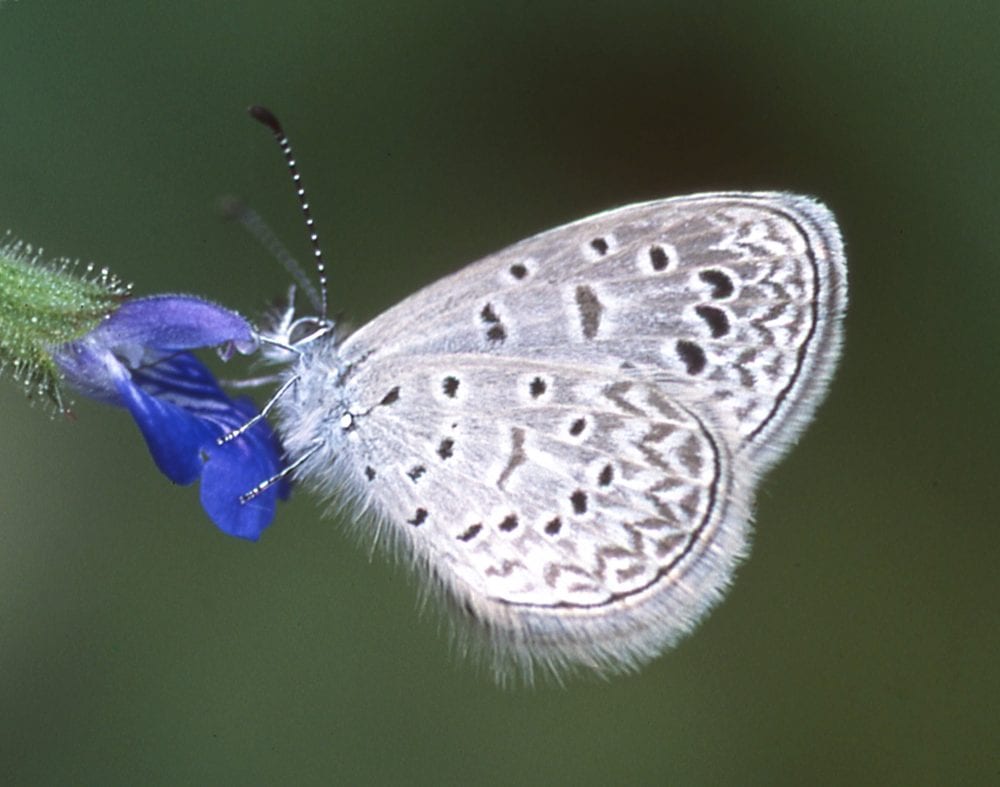
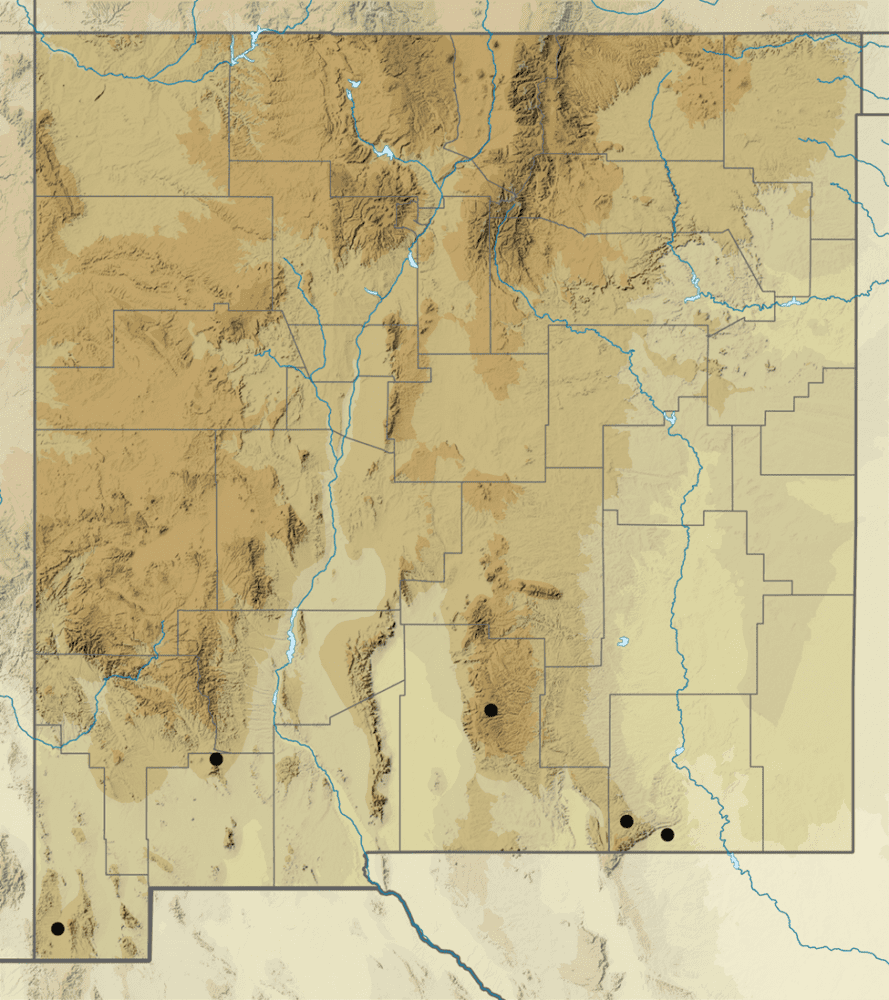
Brephidium exilis (Boisduval 1852) Western Pygmy-Blue (updated August 23, 2023)
Description. Our smallest butterfly has stubby forewings. Western Pygmy-Blue is gold-brown above with iridescent blue basal scaling. The hindwing above has a row of submarginal black spots, occasionally supplemented with a white patch or two. The hindwing below has four black spots pupiled with iridescent gold at the margin. Range and Habitat. Brephidium exilis is resident from South America north to the southwest US. Small as it is, each year it invades areas far north of where it can successfully overwinter, sometimes as far north as Montana and Idaho. It is reported from most of New Mexico (all counties except Mo), but it breeds regularly only in southern New Mexico or at low elevations. Northern New Mexico observations probably represent strays or late season offspring. Life History. Larvae feed on plants in the Chenopodiaceae, including Atriplex canescens (four-winged saltbush; Chenopodiaceae), Kali tragus (Russian thistle aka tumbleweed; Amaranthaceae) and other plants that inhabit disturbed areas, roadsides and saline soils. Flight. Two or three generations are completed in southern New Mexico, where adults may be found year-round in suitable weather. Summer wanderers to northern New Mexico may produce a round or two of offspring before winter cold kills all. Brephidium exilis seems to be expanding its breeding range northward and upward, notably along highways that are salted in winter. Extreme early and late dates here are January 8 and December 18. Comments. Our populations are the nominate subspecies. “Yesterday, walking to the Agricultural College, I found a bush with ants running in numbers over the twigs. Looking to see what they were after, I came across a larva and then another. Presently I saw that the bush was swarming with them, only they were so perfectly concealed by their colour that I should not have noticed them except for the ants; . . . flying about the bush were many of the Exilis butterflies” T. D. A. Cockerell (1894) did not say what the plant was, but our money is on four-winged saltbush.
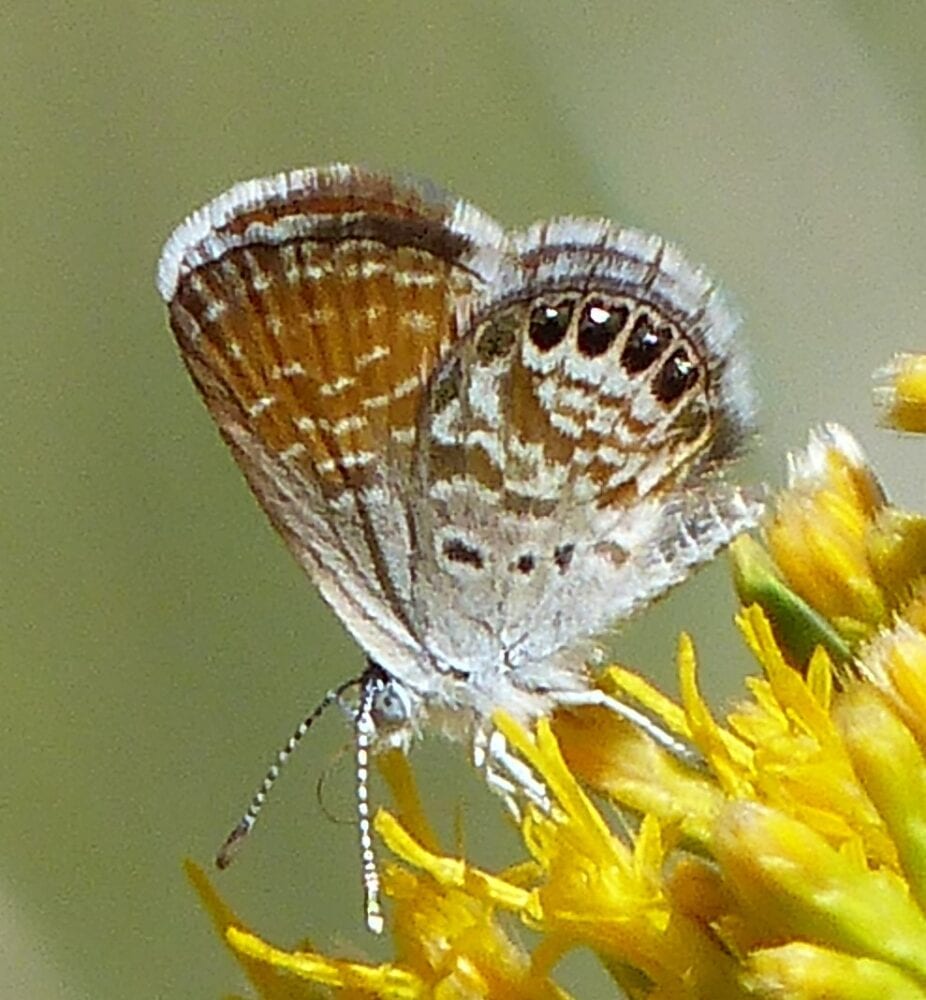
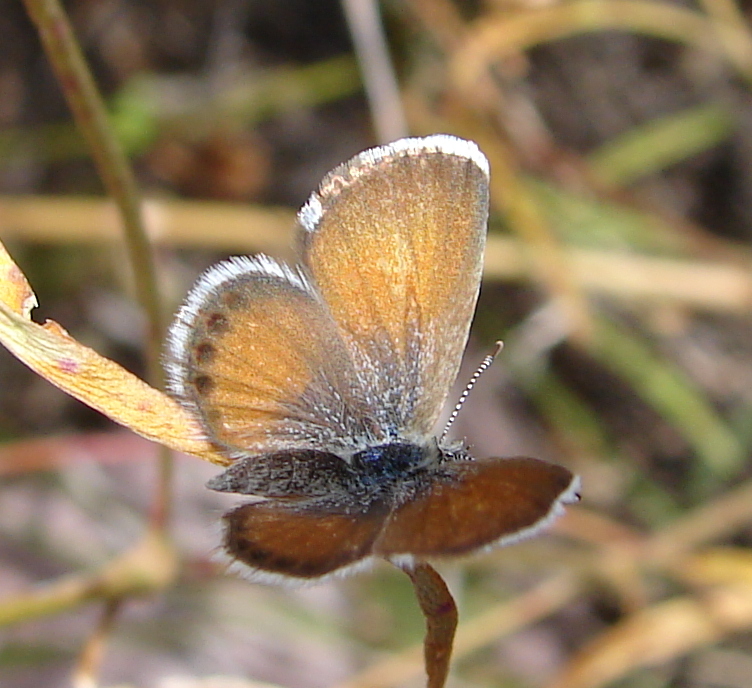
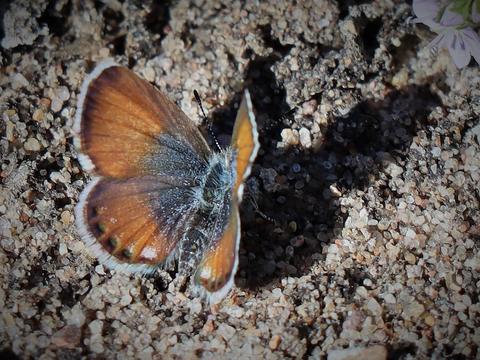
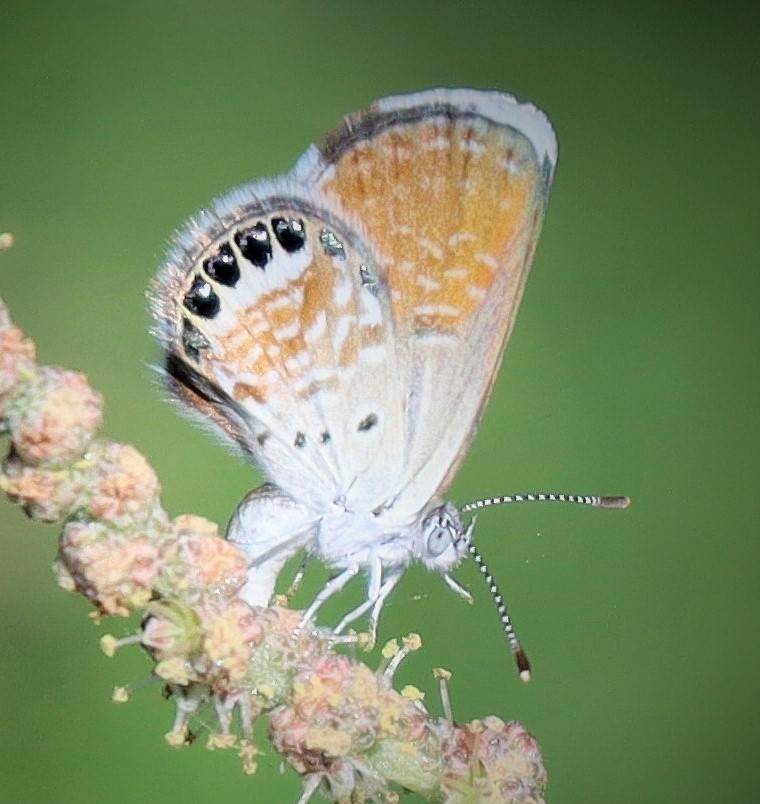
Leptotes marina (Reakirt 1868) Marine Blue (updated May 17, 2022)
Description. Leptotes marina’s striped underside countenance is created by alternating white and gray-tan stripes paralleling the wing margins. There are one or two dark spots near the hindwing tornus. Males are gold-brown above with an iridescent blue sheen. Females are largely brown above with a basal bluish sheen and brown stripes, echoing the stripes on the ventral surface. Females also have distinct “eyespots” near the anal angle dorsally, again echoing what appears on the ventral surface. A related species, the Cassius Blue (Leptotes cassius) is much whiter on the ventral surface, with greater extent of white at the anal angle of the FW. Cassius has been erroneously reported from NM, but it may eventually be found as a stray, particularly in the SE part of the state. Range and Habitat. Marines Blues are native to Central America, Mexico and the southwest US. An effective wanderer despite its small size, it is recorded north as far as the Great Lakes. It occurs throughout New Mexico (all counties). It had been uncommon in northern parts of New Mexico or above 8000′, but they are so abundant in some years as to suggest one or more generations of breeding. Life History. Larvae eat a variety of legumes (Fabaceae) including common natives such as mesquite (Prosopis spp.) and routine weeds such as alfalfa (Medicago sativa). Flight. Adults are reported in southern New Mexico from March 23 to November 26, suggesting at least two generations per year, perhaps even year-round flight when weather is favorable. Numbers peak in early summer, but Leptotes marina seems scarce after August. In northern New Mexico it is recorded mostly in May to July. Adults are commonly seen at nectar (e.g., Amorpha, Acacia, Asclepias), moist earth and animal dung. Comments. Our oldest report of Leptotes marina was collected by University of Kansas Professor Francis Huntington Snow in Gallinas Canyon west of Las Vegas (SM) in July or August 1882.
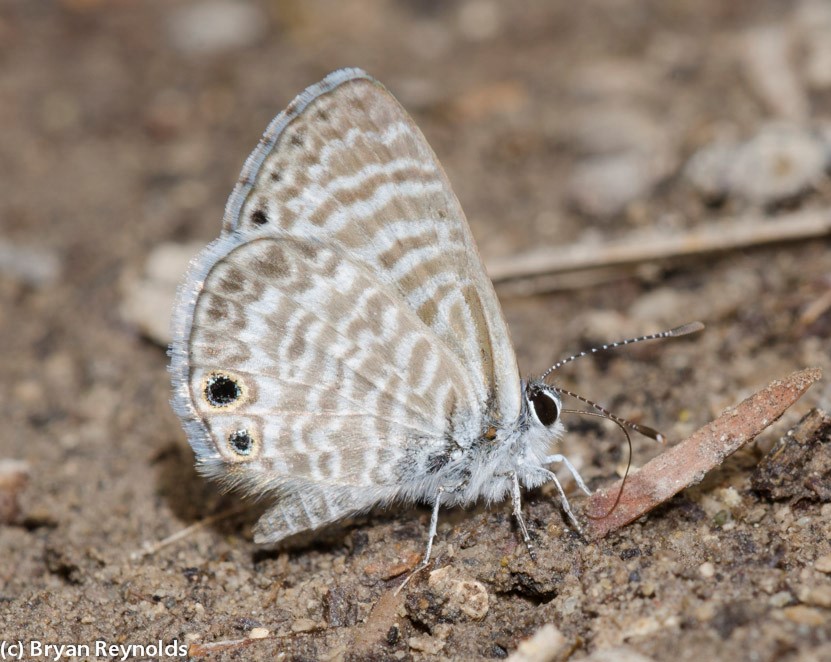
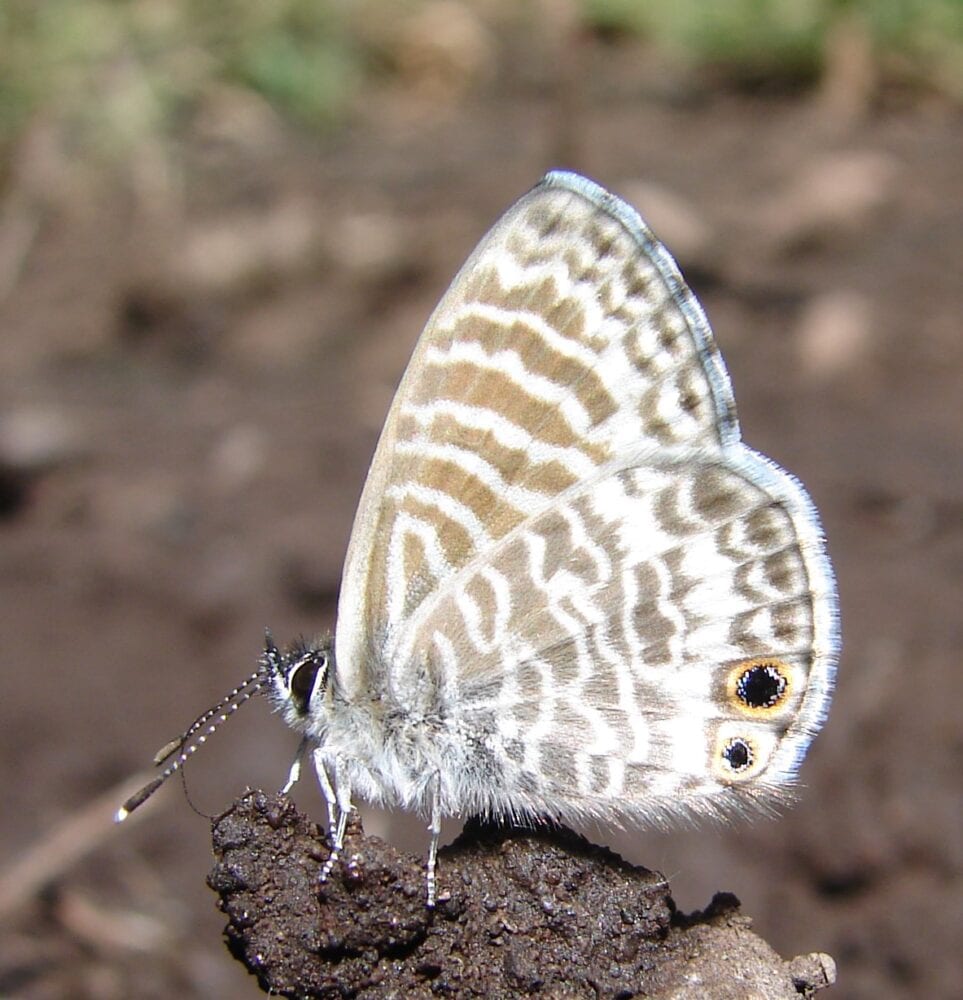
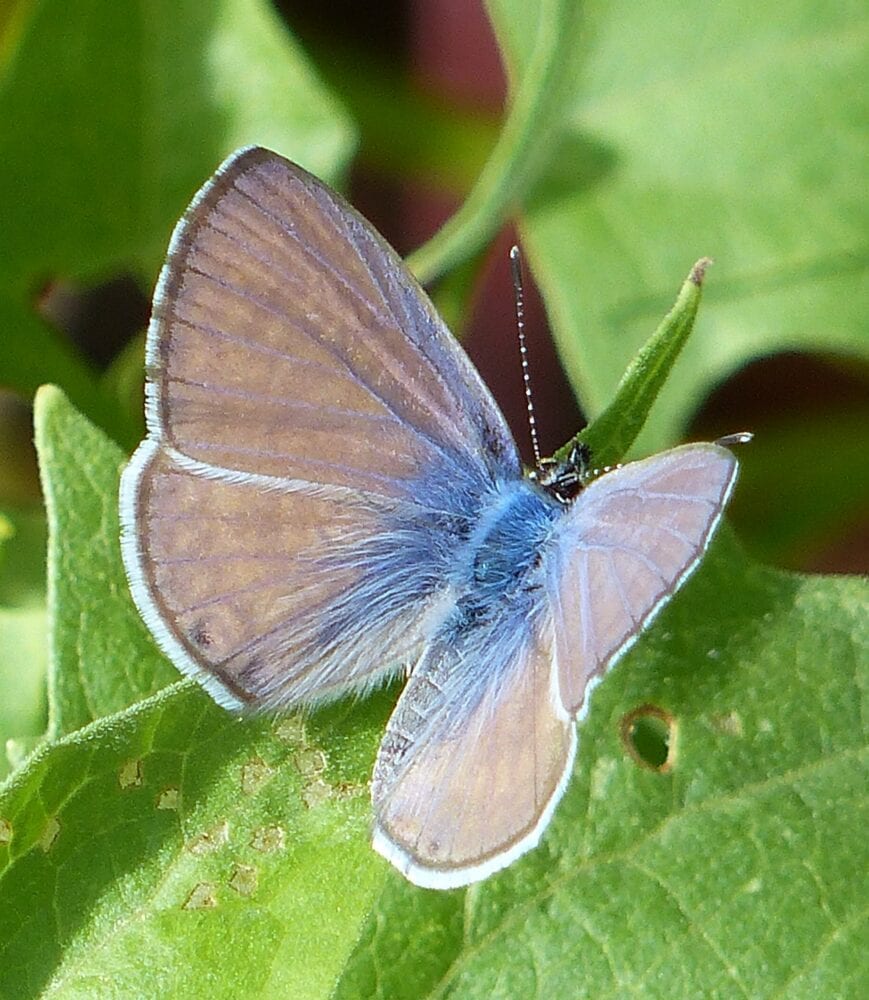
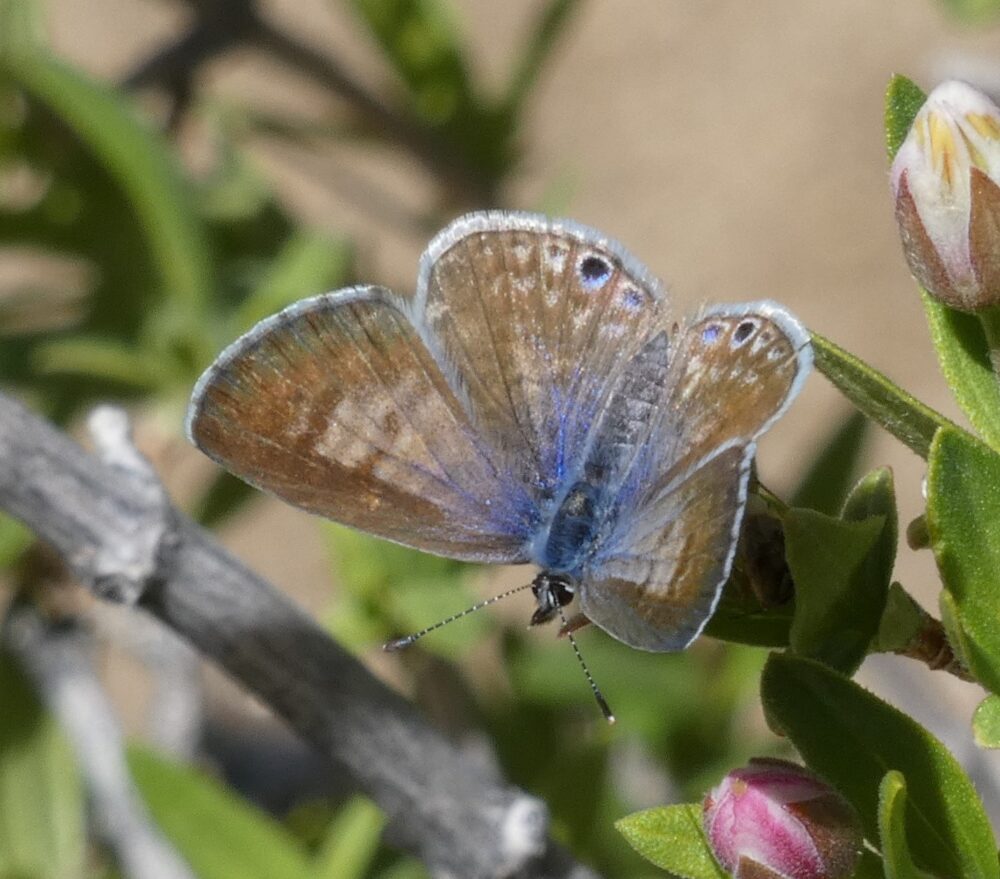
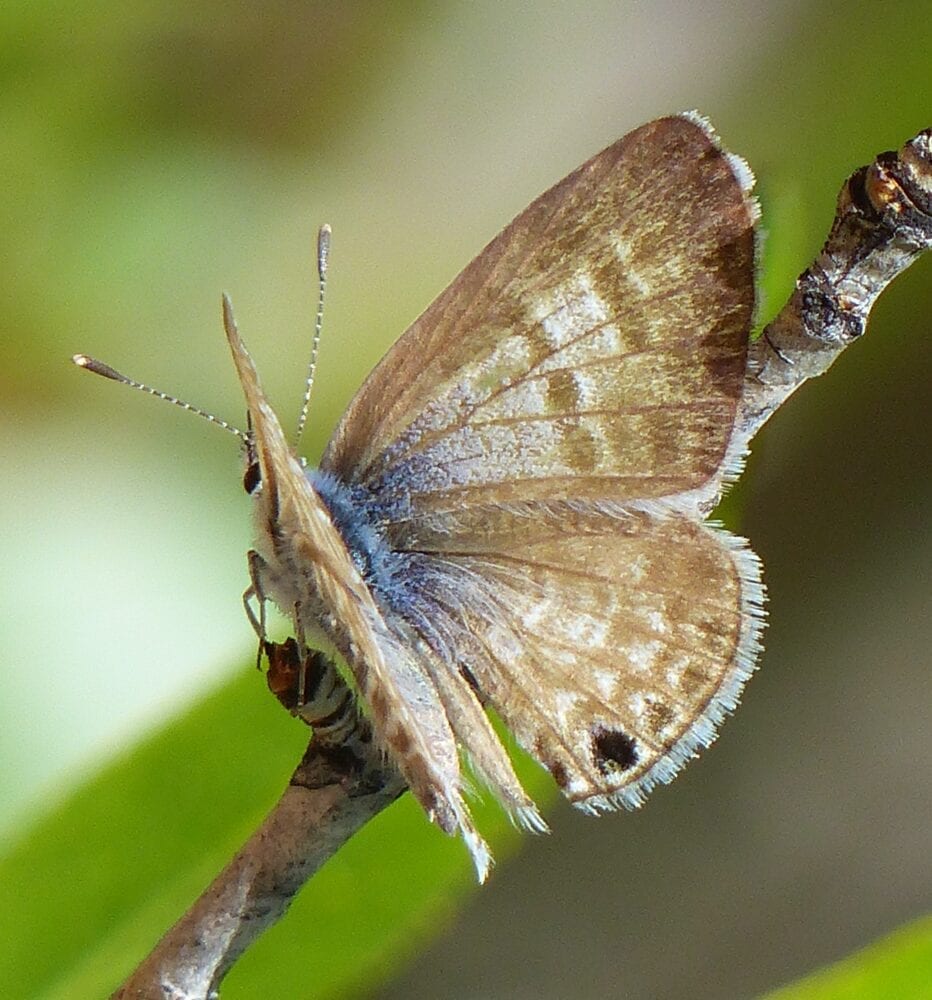
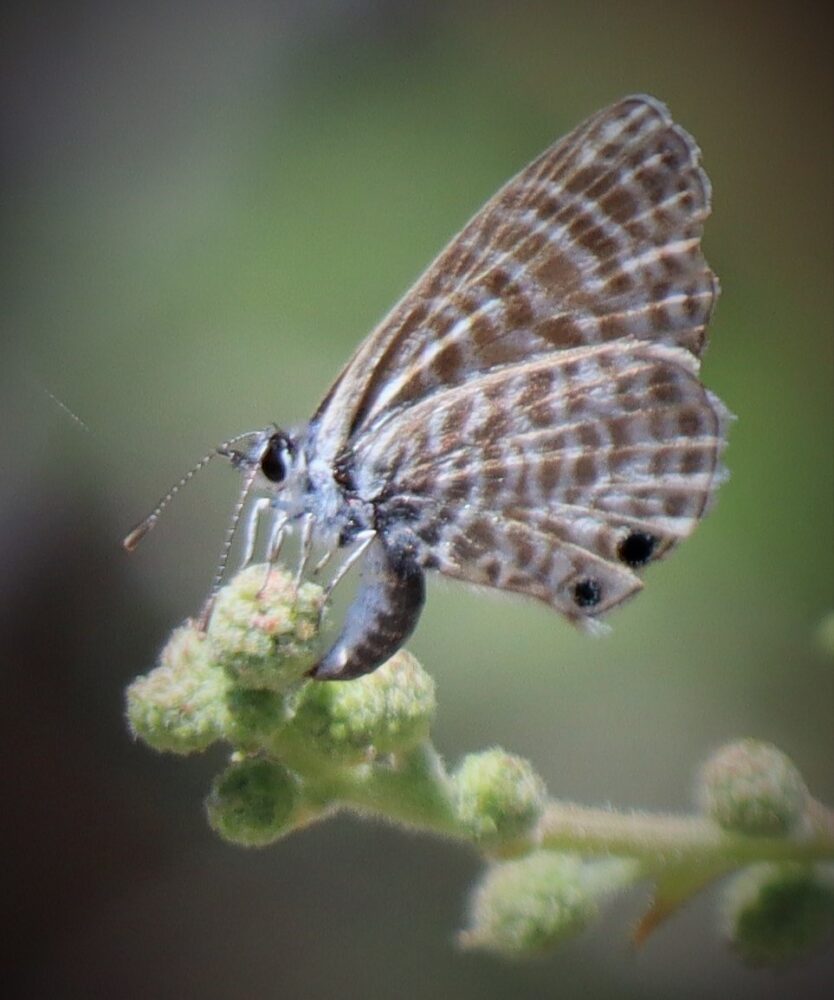
Euphilotes Mattoni [1978] Dotted Blues, Buckwheat Blues (under review 1/31/24
Larvae of this western genus eat only flowers and fruits of wild buckwheats (Eriogonum species; Polygonaceae), and some species seem quite loyal to their host buckwheat(s), away from which adults rarely wander far. They bask on the buckwheat, nectar at it, perch on it, patrol for mates from it, and overnight within it. If you have not found the buckwheat you will not find its associated buckwheat blue. Hint: many buckwheat species love to colonize roadcuts.
What is known about Dotted Blues in New Mexico is anchored by their host buckwheats, wherever those buckwheats occur in good numbers. Learn these buckwheats and you will make a good start:
Antelope Sage (Eriogonum jamesii v. jamesii) hosts Square-spotted Blue (Euphilotes centralis) across much of the state, usually on exposed or disturbed, south-facing slopes from 6000 to 8500 feet elevation.
Buckwheat Brush (Eriogonum corymbosum) hosts Ellis’ Blue, Euphilotes ellisii, found in the northwest corner of the state (SJ,MK,Sv).
Redroot Buckwheat (Eriogonum racemosum) hosts Spalding’s Blue (Euphilotes spaldingi) across much of northern and central New Mexico, usually in dry meadows from 6500 to 8500 feet elevation.
Cushion Buckwheat (Eriogonum ovalifolium) hosts Stanfords’ Blue (Euphilotes stanfordorum) in northwestern New Mexico (SJ).
Wright’s Buckwheat (Eriogonum wrightii) hosts Rita Blue (Euphilotes rita) in semi-arid grasslands of central, southern and southwestern New Mexico (Be,Ca,Da,Gr,Hi,Lu,Si,So), typically 5000 to 7000 feet elevation.
Spreading Buckwheat (Eriogonum effusum) hosts Euphilotes (rita) coloradensis per Scott Ellis pers. comm. 2023. This form is found in northern and eastern New Mexico (Gu,MK,Qu,SF,SJ,So,Sv,Un).
Slenderstem Buckwheat (Eriogonum leptocladon) and Slender Buckwheat (Eriogonum microthecum) are used by Euphilotes pallescens emmeli in northwestern New Mexico (SJ,MK). The relationship between the Slenderstem- and Slender-feeding populations of Emmel’s Blue requires further study (something that could be said of all of these critters!).
Nick Grishin (pers. comm. 9/15/23) suggests that, genomically, rita rita, pallescens and rita coloradensis are likely to be 3 different species.
Many questions remain to be answered about which dotted blue is associated with which buckwheat. Field observations, specimens or photos should always include the buckwheat. Because the buckwheats are themselves so complex (~250 species), that identification by a qualified botanist is highly recommended.
Identifying Dotted Blues is difficult to impossible without dissection and/or host association. Sizes, colors and markings of all Euphilotes follow the same basic plan. The submarginal hindwing orange band lacks the black spots with scintillating blue sparkles that are typical of Icaricia acmon or I. lupini. Identifying an individual butterfly or population in the field or from photographs can be challenging because it often requires knowledge of the host buckwheat, its flight season, wing marks and genitalia (impossible to examine in the field). Even then, some doubt can remain due to the multitude of named forms. A solitary photo, no matter how good, or a specimen unlinked to its buckwheat, are usually insufficient to determine identity. If you are taking photos, try to get good shots of males and females, topside and bottom side; and the buckwheat.
Evolution of these similar taxa likely resulted from loyalty to larval hosts combined with seasonal differences in bloom times and flight times during post-pluvial isolation of >250 species and forms of Eriogonum in the semi-arid Southwest. This plant group was elucidated by Reveal (1969). Its complex of butterfly herbivores is under study (e.g., Pratt and Emmel 1998) and will continue to be studied for some time before a complete understanding is reached. Taxonomic levels at which to sort these various named entities (e.g., species vs subspecies, and then which species does each subspecies belong with) remain unclear, or at best a matter of opinion and disagreement among experts. so we have to be patient while we contribute information.
Euphilotes centralis (W. Barnes & McDunnough 1917) Central Blue (updated July 24, 2022)
Description. Males are deep blue above with a reliably wide black margin on the forewing, often 15% of the wing radius. The dorsal hindwing orange band is always narrow, but can vary from orange and moderate length (e.g., Zimmerman photo below) to merely a compact, pink-orange aurora near hindwing tornus (e.g. Cary photo below). Dorsally, the Grey/brown females have a hindwing submarginal orange band. A gray/white ventrum has black dots that are smeared on the forewing. Wing fringes are prominently checkered. The submarginal hindwing orange band is relatively narrow compared to other Euphilotes, occupying only about half the available space. Range and Habitat. Central Blues live in shrublands and savannas of the western US, including New Mexico’s major uplands and escarpments (counties: Be,Ca,Ci,Co,Gr,Gu,Ha,Li,LA,MK,Ot,Qu,RA,Sv,SM,SF,Si,So,Ta,To,Un), 5000 to 9000′. Life History. Larvae eat antelope sage (Eriogonum jamesii var. jamesii). This association is enough to confirm identity of this butterfly and is more reliable than many phenotypic characters. Flight. Adults fly in mid-summer, generally between June 17 and August 27; lower elevation colonies (Gu,Qu) fly later, into September. Comments. Taxonomically, this butterfly is pretty well understood. The only ongoing debate is whether centralis is a full species as per Pelham (2021) or a subspecies within Euphilotes battoides (Behr 1867) as treated by Ferris and Brown (1980), Brock and Kaufman (2003) and Glassberg (2017). If you like the former approach, as we do, then our populations are the nominate subspecies, Euphilotes centralis centralis. More Comments. There are a handful of unsubstantiated reports of Euphilotes ancilla (probably ssp. barnesi Opler & M. Fisher 2009) from northern NM which may be centralis, genuine ancilla, or a completely different species. Those records are from Co,Sv,SJ & SF; further research will tell (we hope). E. ancilla larvae feed on Eriogonum umbellatum, which is extremely scarce in northern NM. Adults of ancilla emerge earlier than centralis, though their flight periods may overlap.
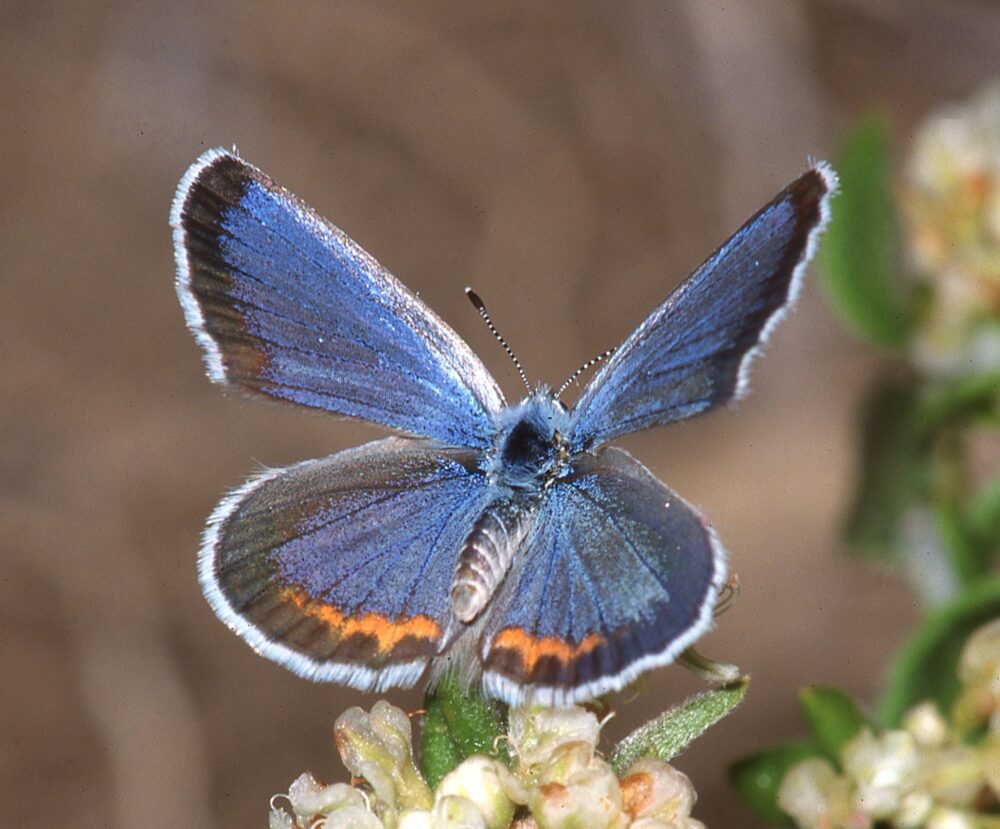
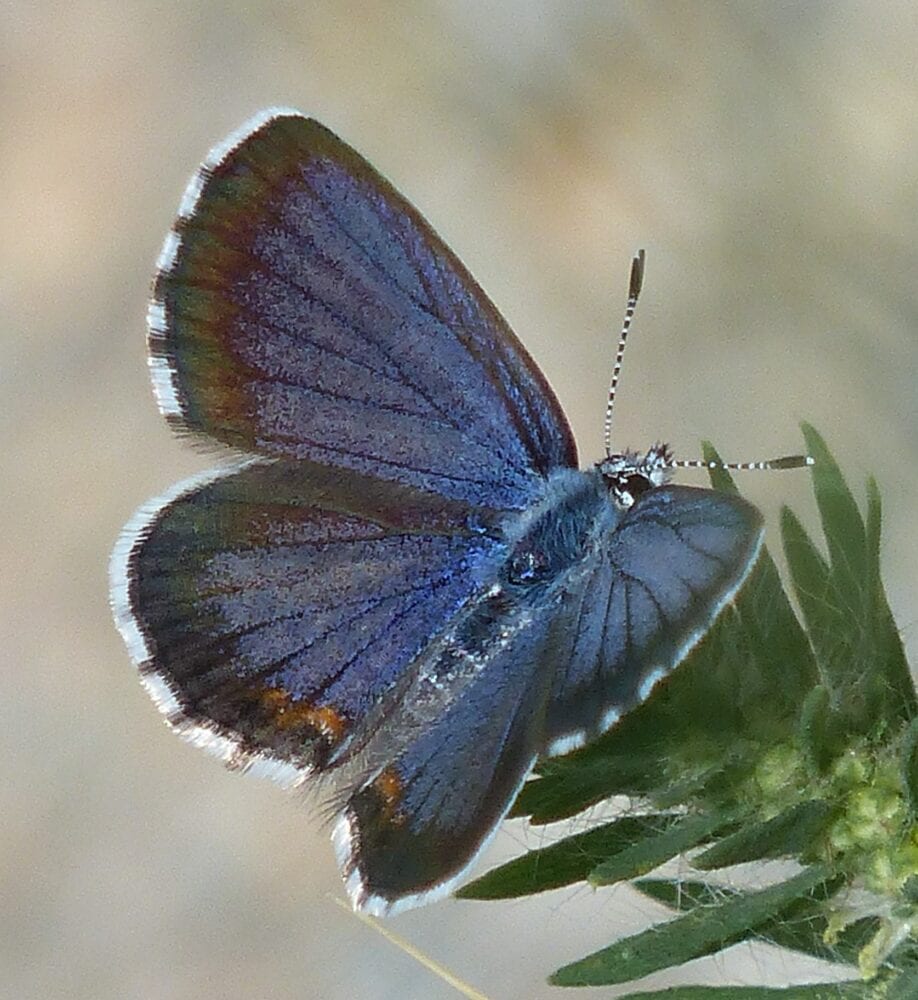
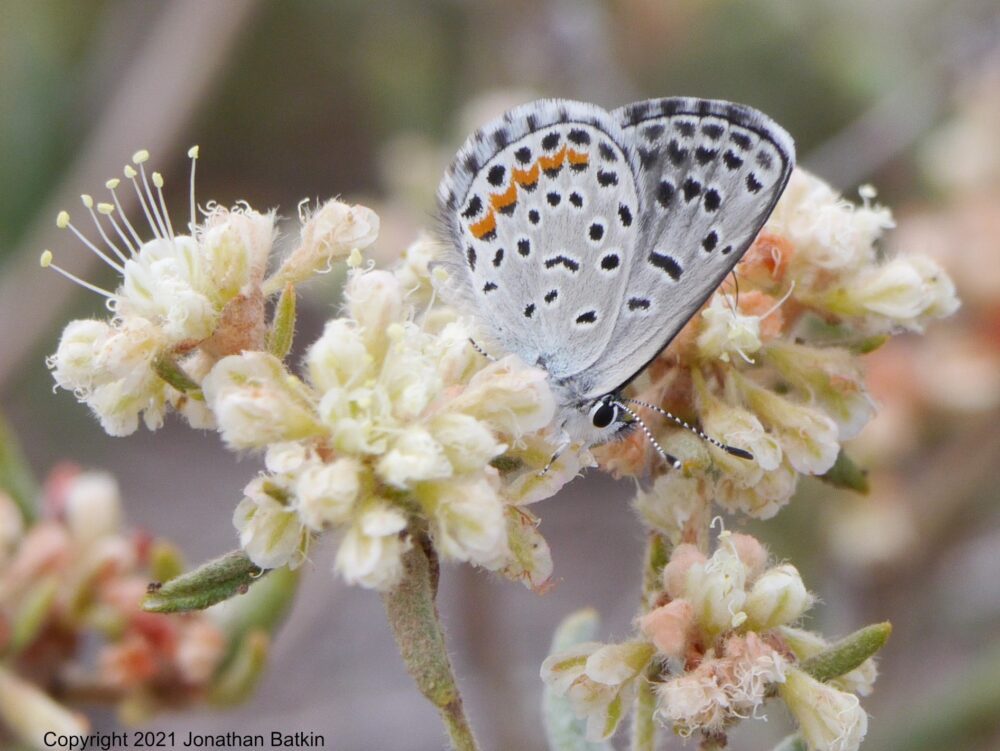
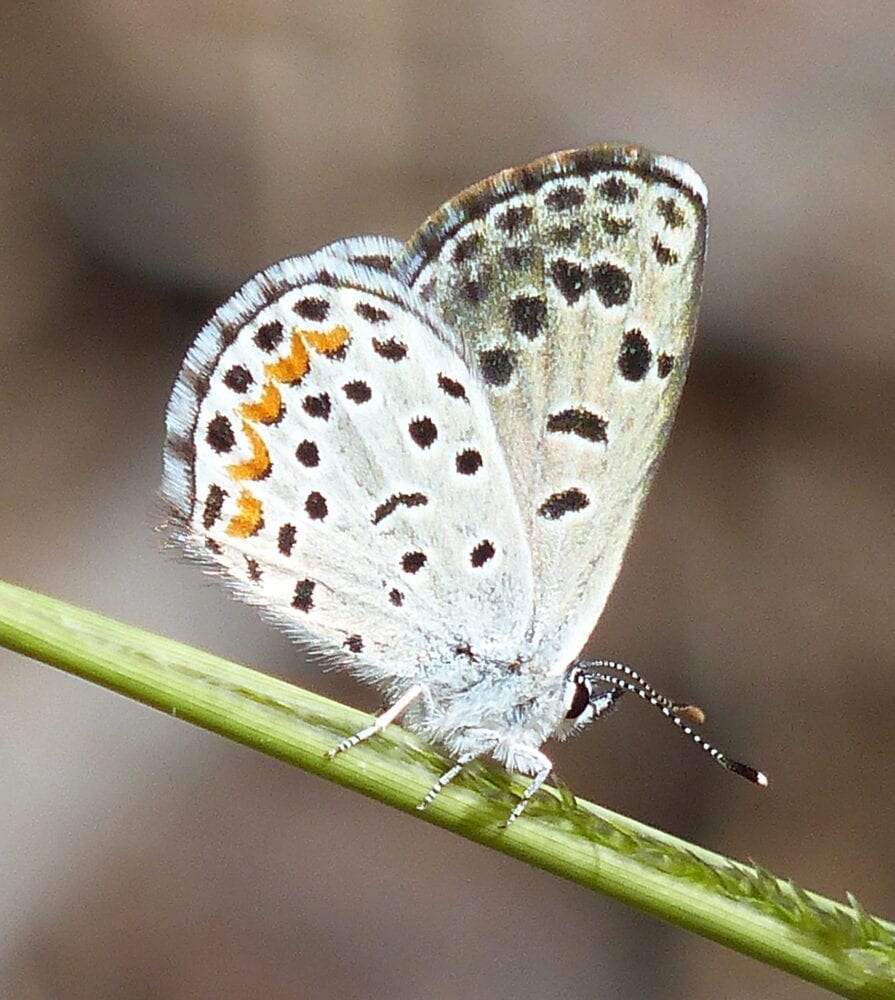
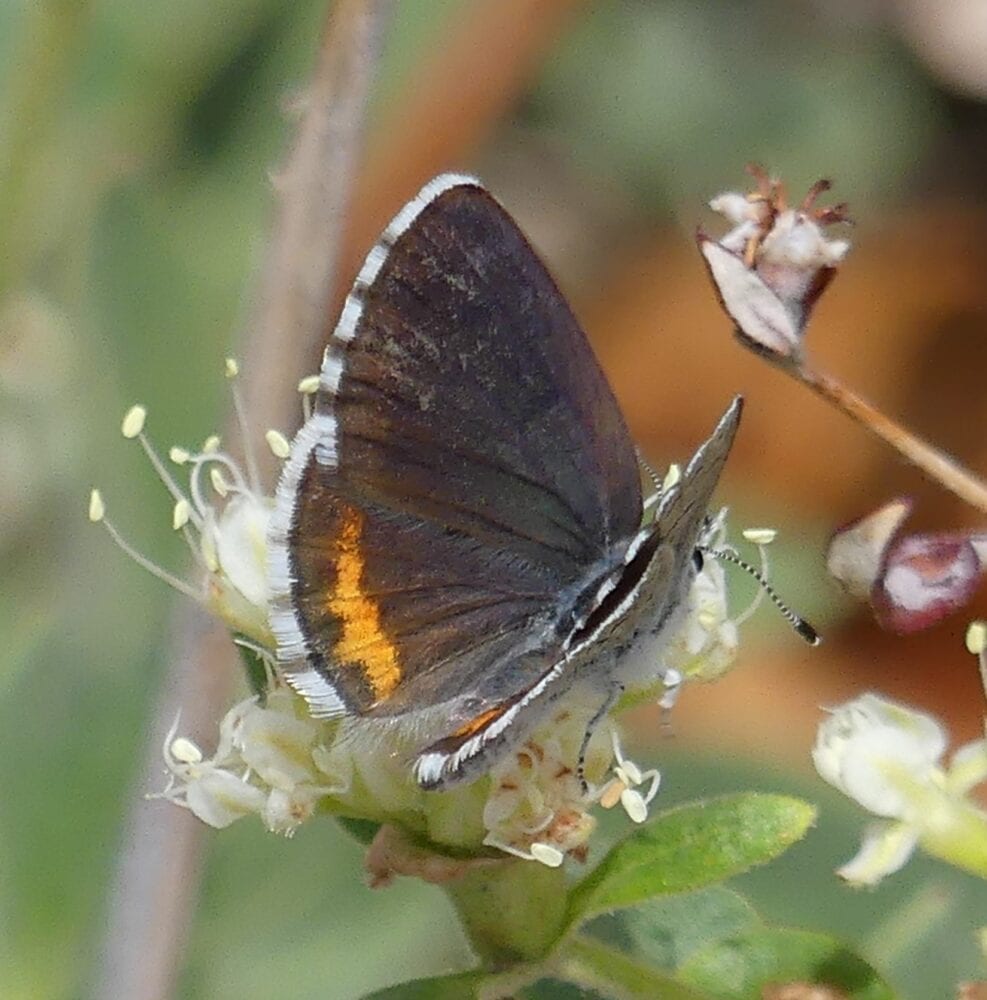

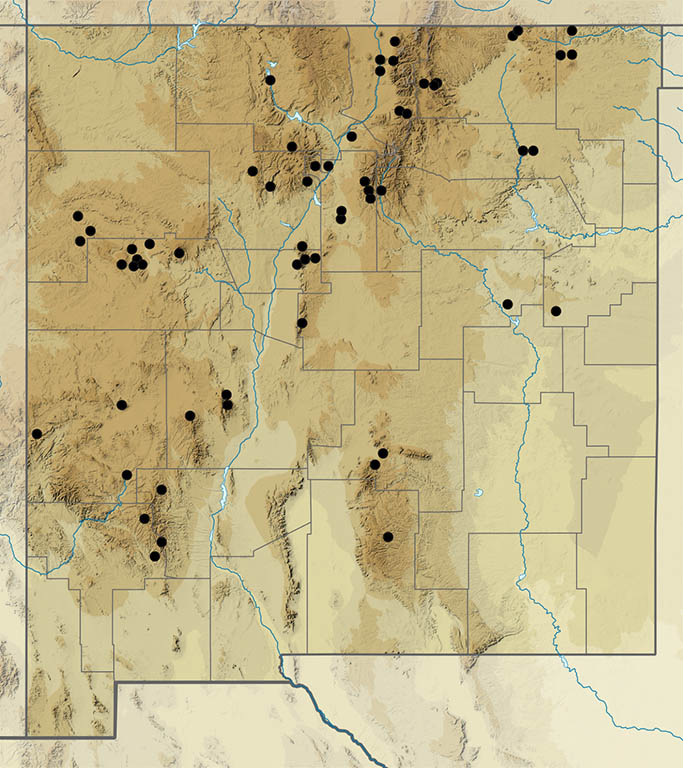
Euphilotes ellisii (Shields 1975) Ellis’ Blue (updated January 29, 2025)
Description. Compared to Central Blues, Ellis’ males are a paler blue above with a narrower black border. Females may be lighter brown above with a wider orange band. It may be more important to be able to distinguish it from ‘Colorado’ Rita Blue, with which it is sympatric and synchronic in northwest New Mexico. In that comparison, Euphilotes ellisii has moderately checkered wing fringes; males have a compact pink/orange aurora at the back of the dorsal hindwing with limited development of black dots; and females have a more compact orange band with more prominent black dots at the rear of the dorsal hindwing. Differentiating Ellis’ from ‘Colorado’ Rita Blue based on ventral views only is challenging. In that attempt, look for moderate wing fringe checkering and a light gray ground color on Ellis’, compared to slight or limited fringe checkering and white ground color on ‘Colorado’ Rita. Success is not guaranteed. Range and Habitat. This Colorado Plateau insect occurs in arid northwest New Mexico shrublands (counties: MK,SJ,Sv,SF?), usually 5500 to 7200’. Life History. Larvae appear to be restricted to stands of crispleaf buckwheat (Eriogonum corymbosum). Field (or lab) identification of this plant is key to identifying this butterfly, and often more reliable than phenotypic characters, many of which overlap with E. rita coloradensis. Flight. Adults fly their one annual air show in late summer. Our records are clustered between August 6 and September 7. Comments. The nominate subspecies, occupies habitats in SW Colorado and SE Utah, while subspecies E. e. anasazi (Scott 1998), whose ventral hindwing orange submarginal band is narrow, seems to prevail in NW New Mexico. Euphilotes ellisii and E. rita coloradensis, are most reliably differentiated by their host plants, which may sound straightforward, but those host wild buckwheats are sympatric (in NM) and bloom at the same time. BOA spells the Latin species epithet for this species as ellisii, not ellisi.
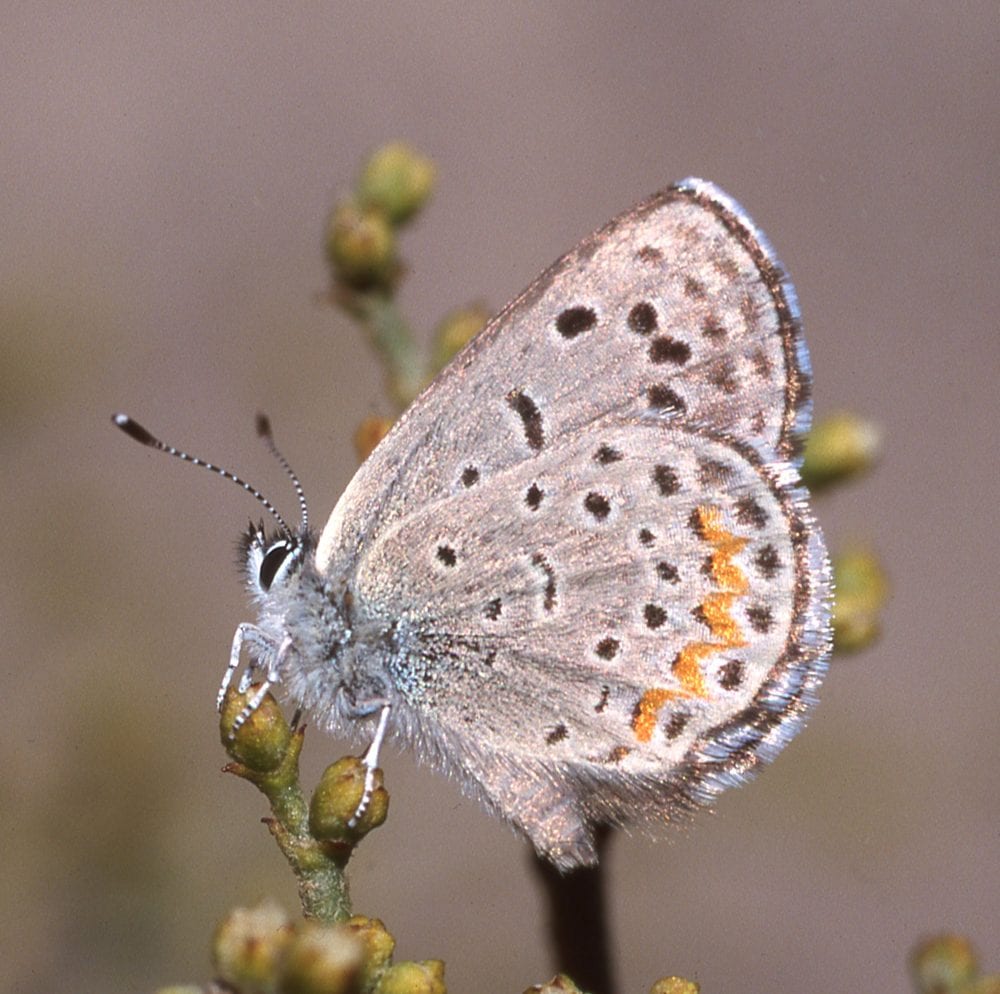
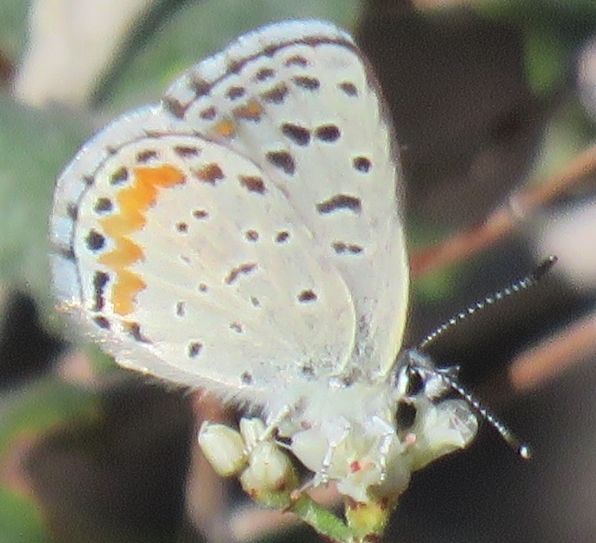
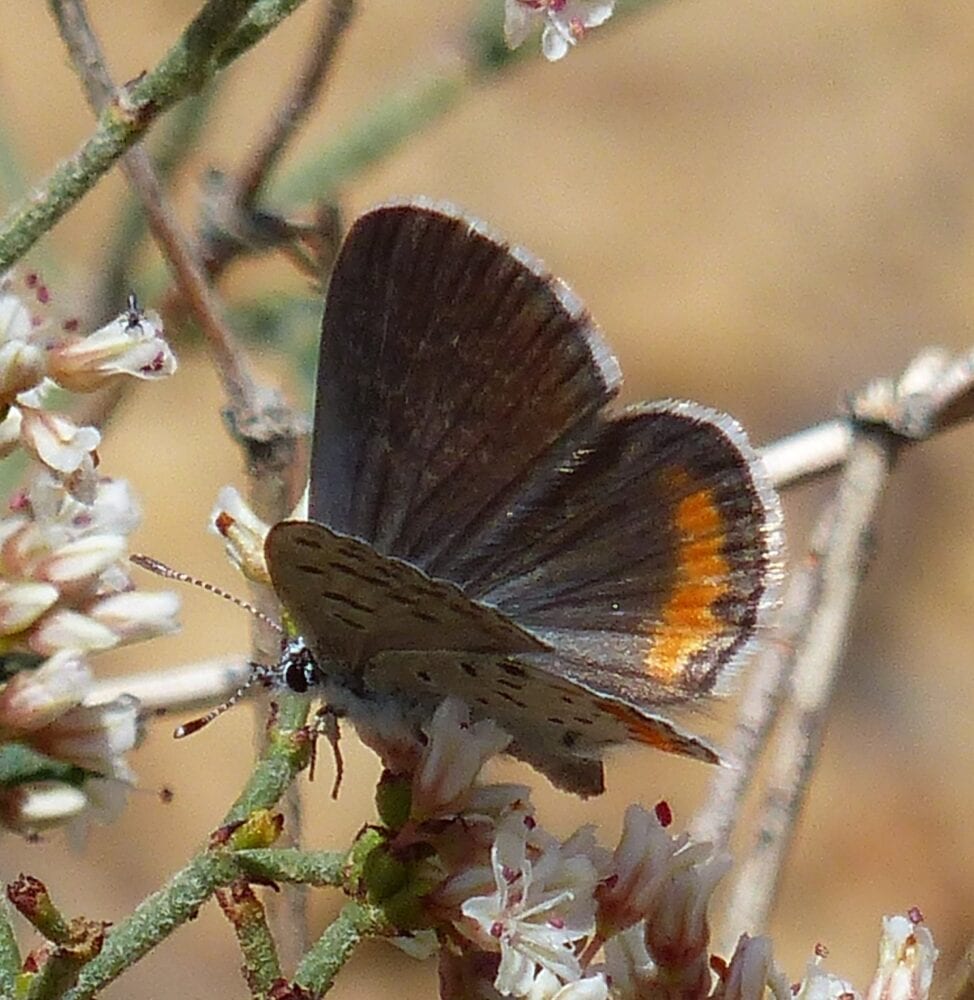
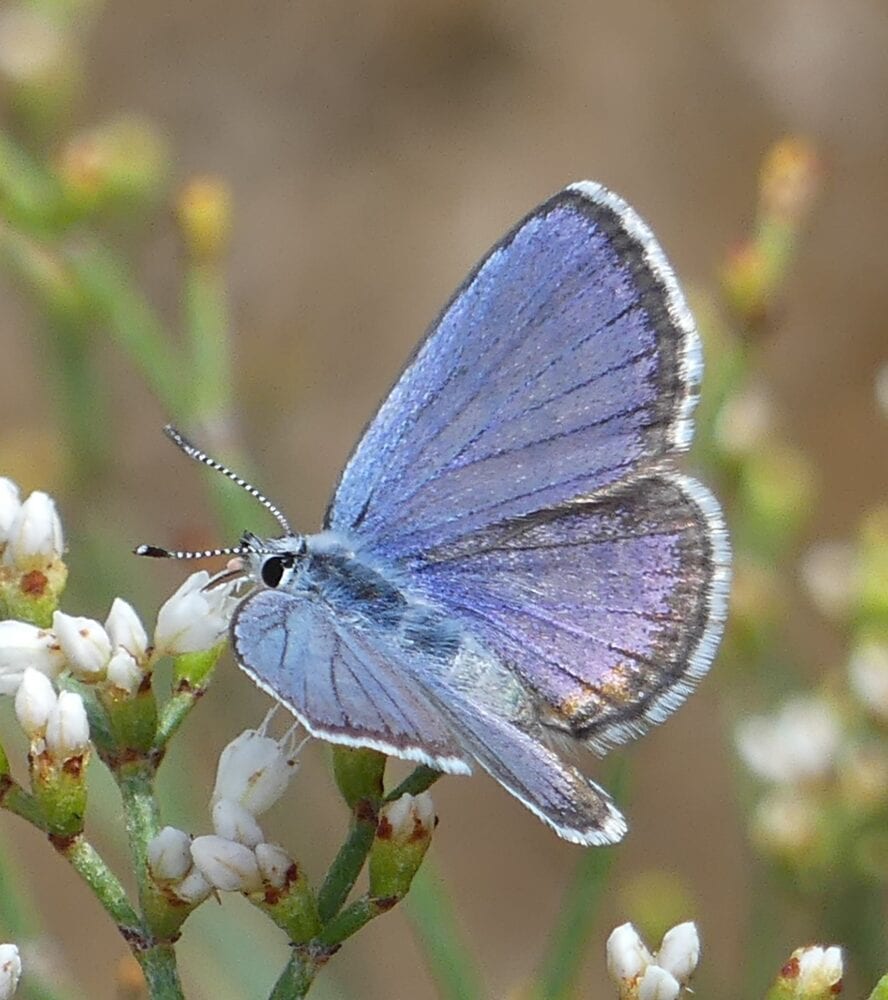
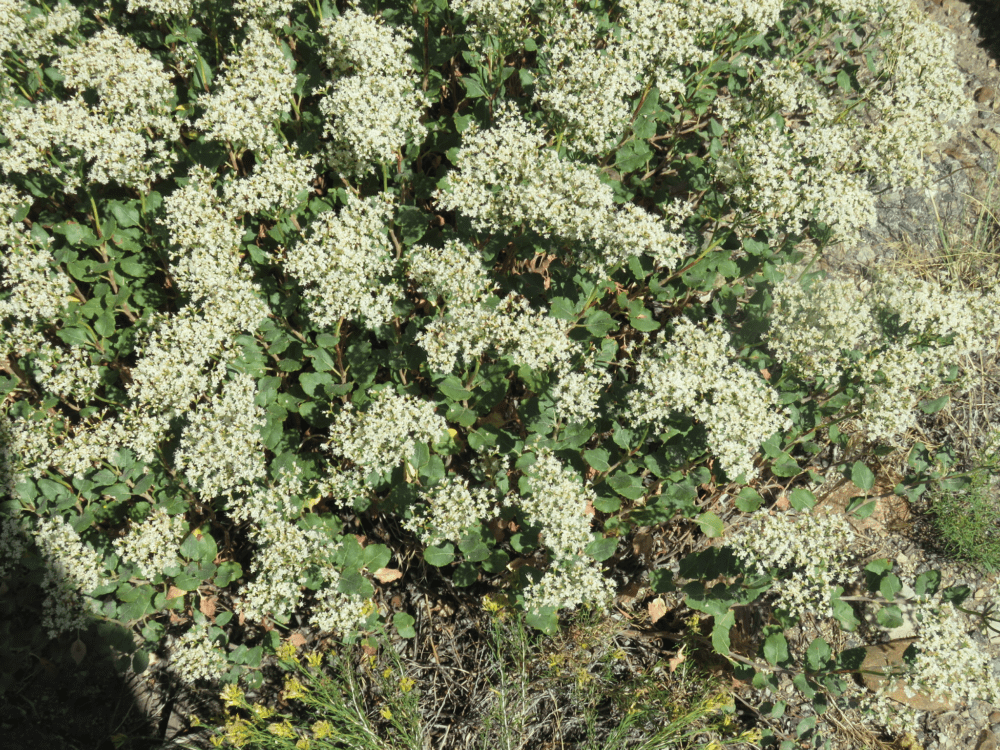
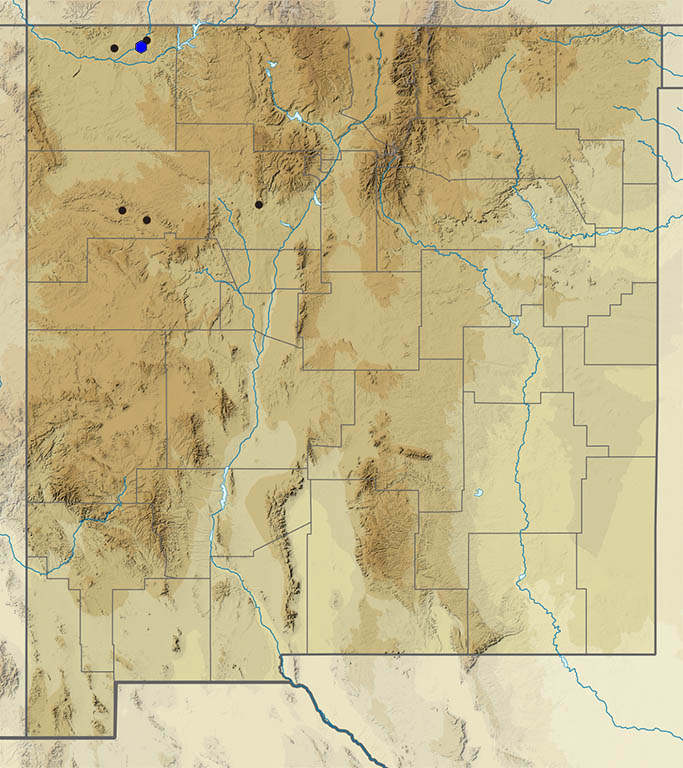
Euphilotes spaldingi (W. Barnes & McDunnough 1917) Spalding’s Blue (updated May 19, 2022)
Description. Spalding’s Blue is the most distinctive member of this genus in New Mexico, with marginal orange spots on ventral forewings and hindwings on males and females, whereas congeners have orange only on the hindwing. Spalding’s Blue also resembles Melissa Blue (Plebejus melissa), but it lacks iridescent blue scintillae in the ventral hindwing submargin and male Melissa’s have no orange above. Range and Habitat. This butterfly occurs in our northern uplands as far south as the Gallo and Manzano Mountains (counties: Be,Ca,Ci,Co,MK,RA,Sv,SJ,SF,Ta,To). It occupies Upper Sonoran to Transition Zone savannas, grasslands and dry meadows with extensive stands of the host, generally 5000 to 9000′ elevation. Life History. Redroot buckwheat (Eriogonum racemosum; Polygonaceae) is the only known host, even at its southeast limit in Manzano Mountains State Park and at its easternmost occurrence at Eagle Nest Lake State Park. Eggs hatch immediately so larvae can feed and pupate before winter. Flight. Euphilotes spaldingi is univoltine with adults on the wing in summer. Our records fall between June 27 and August 25. While flying about host racemes in grassy savannas, adults seek nectar at flowers and siphon nutrients from mud created by summer rains. Comments. This species was once considered a subspecies of Euphilotes rita. Our populations belong to subspecies Euphilotes spaldingi pinjuna J. Scott 1981, in recognition of the pinon/juniper savanna habitat it often occupies. The first New Mexico record dates to 6 August 1907 from near Ft. Wingate (MK), probably collected by John Woodgate and now in the American Museum of Natural History in New York.
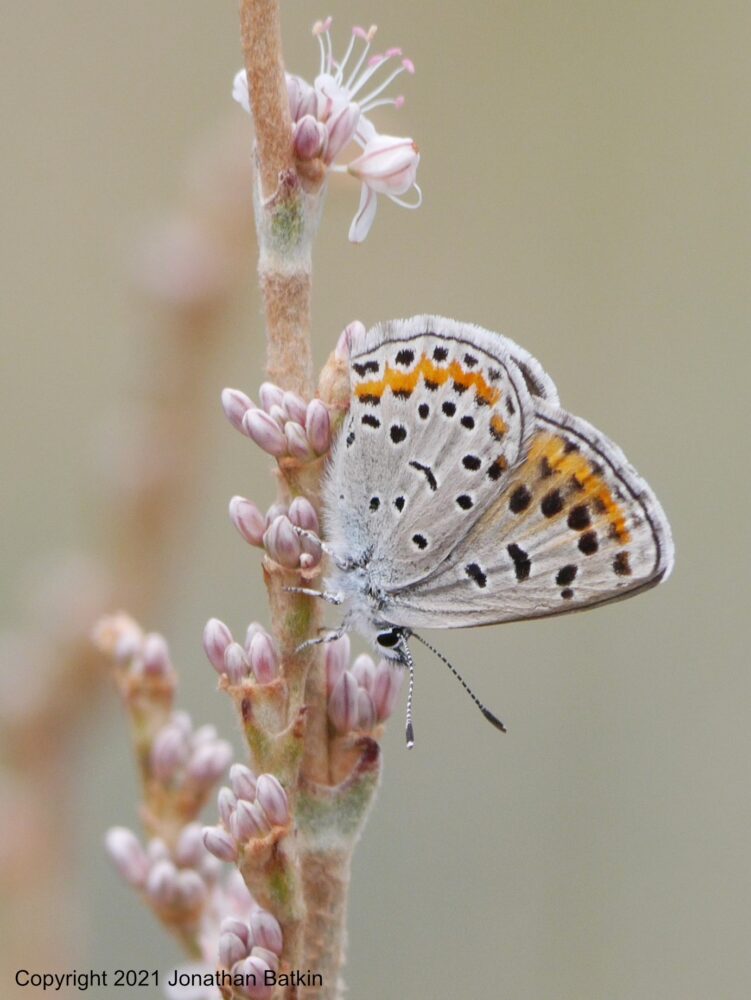
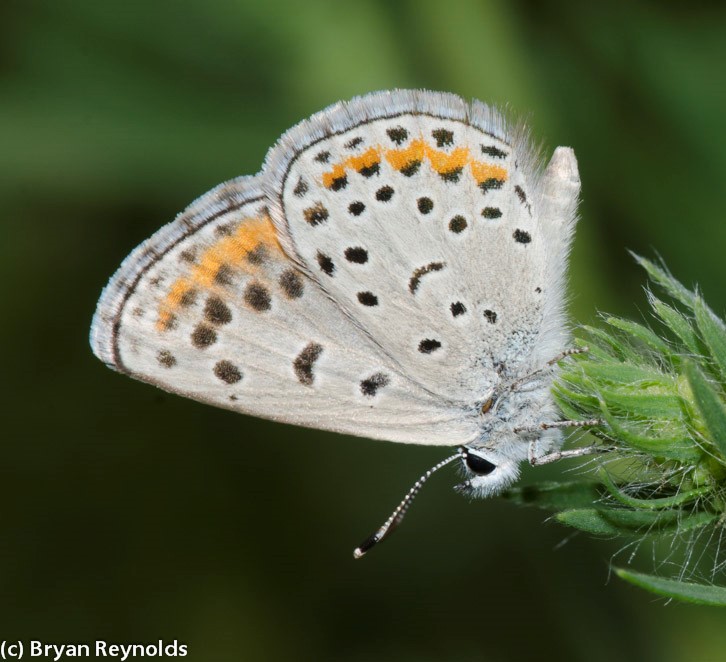
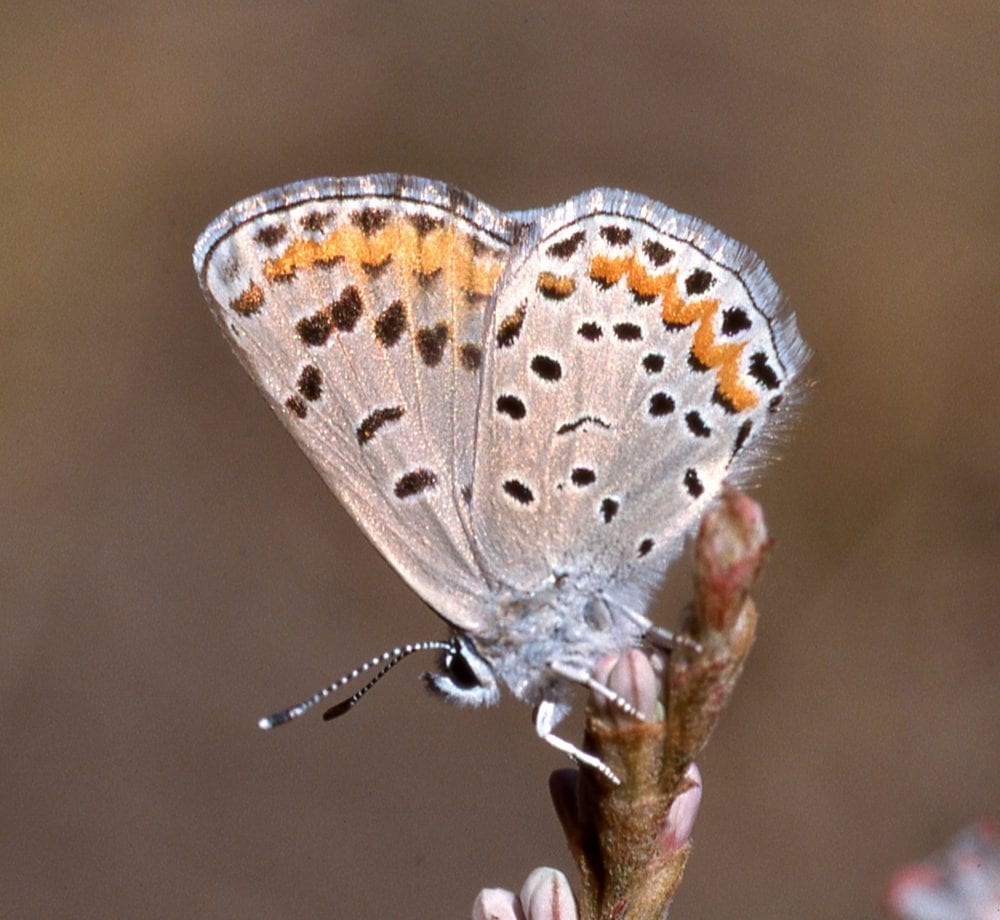
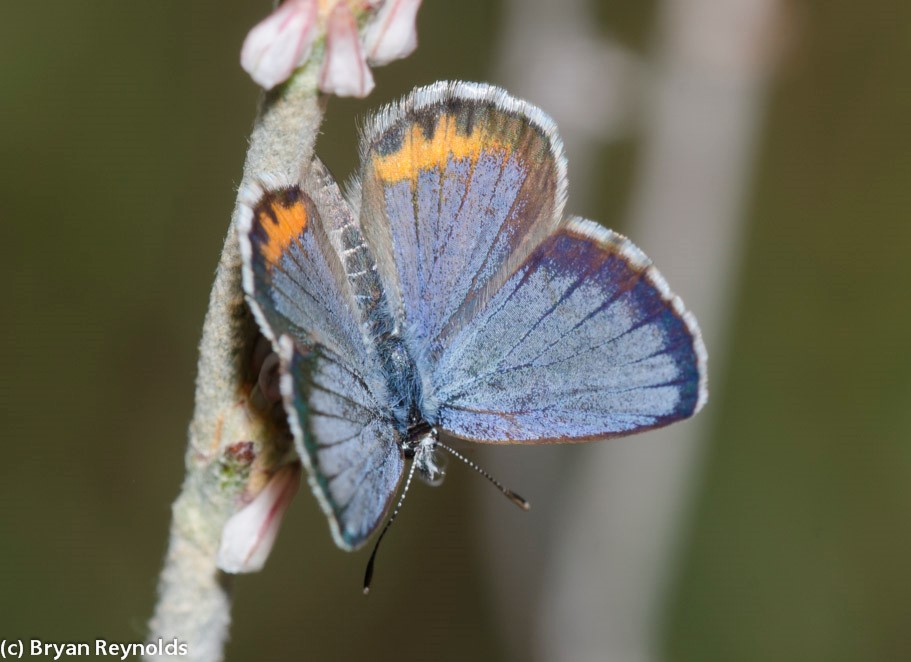
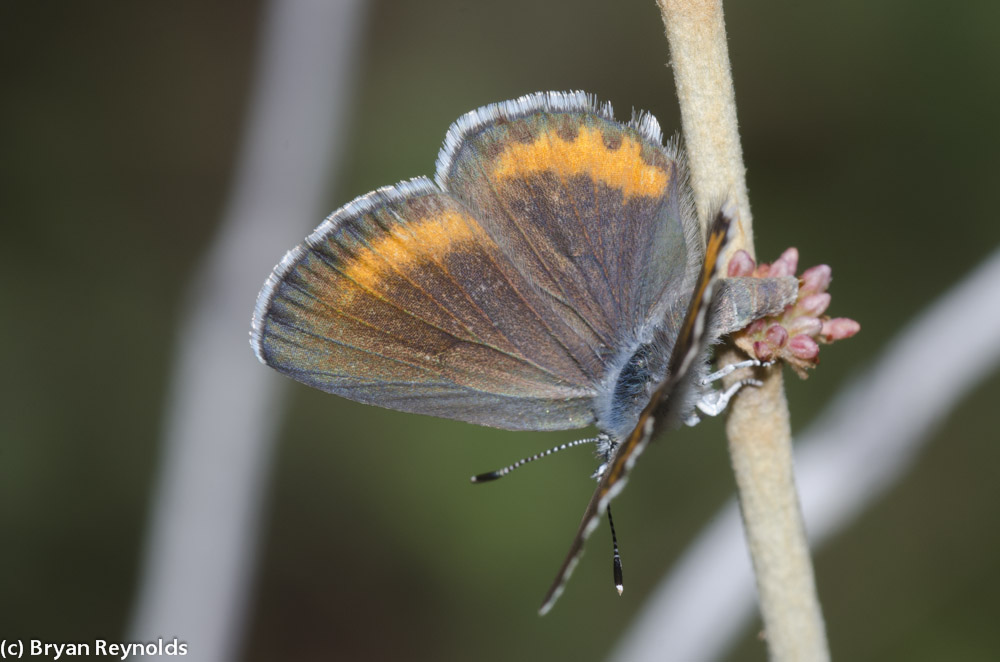
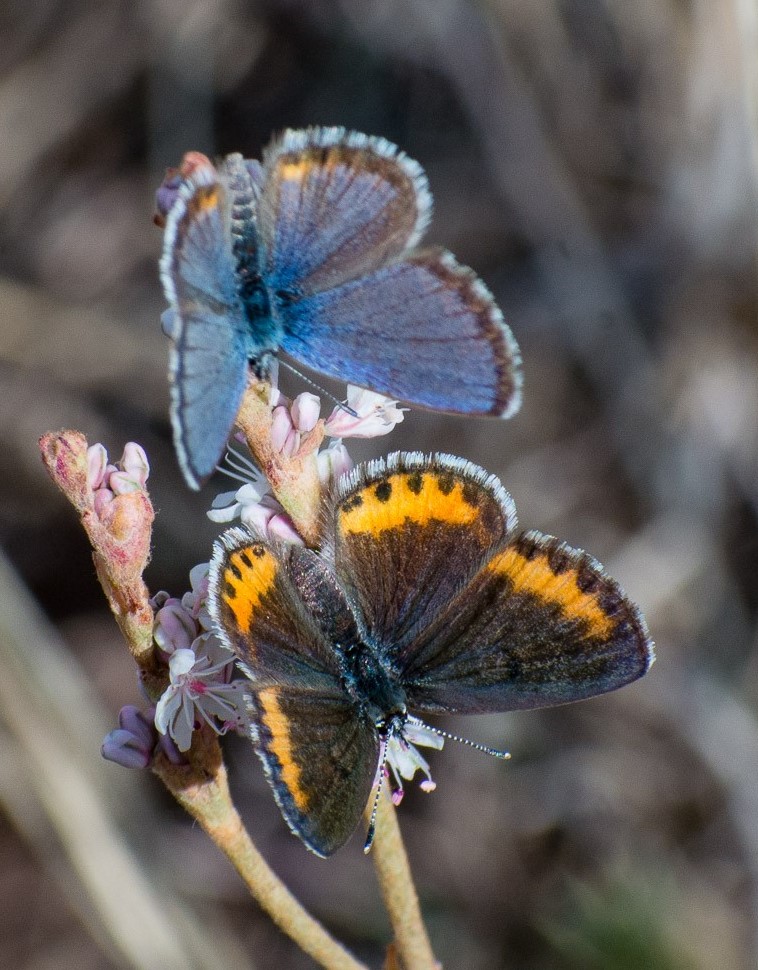
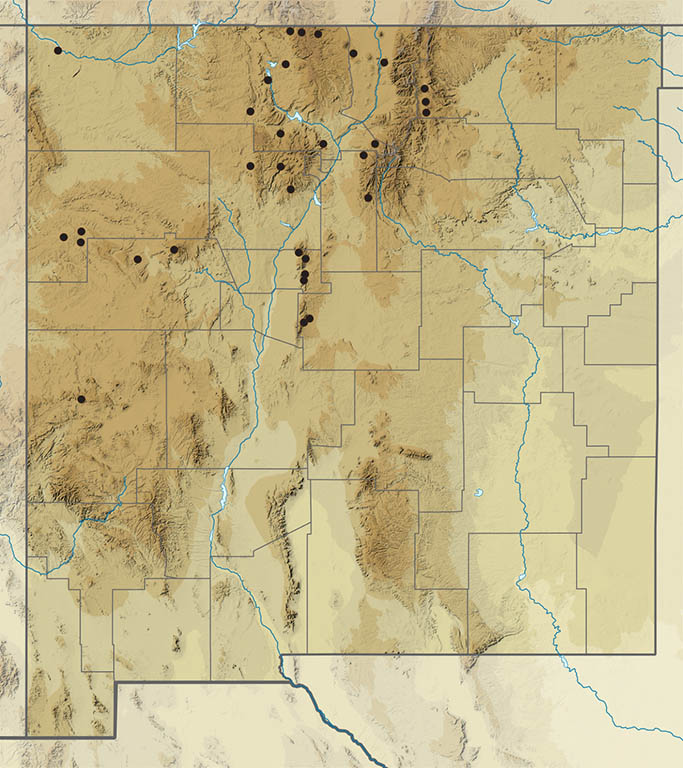
Euphilotes stanfordorum Opler and A. Warren 2009 Stanfords’ Blue (updated May 21, 2024)
Description. On Stanfords’ Blues, the ventral hindwing orange band tends to be less continuous. The ventral forewing is heavily smeared/smudged in males, but not in females, which also can have a touch of submarginal orange near the back edge. Male uppersides are bright blue, with a prominent black submargin., The dorsal hindwing has only a faint coral/orange aura near the anal angle, with semi-prominent black dots along the rear margin. Females are dark brown above with a prominent orange submarginal band on the hindwing. Field identifications are aided by identification of the larval host Eriogonum. Range and Habitat. This species occurs in limited populations from southwest Colorado and southeast Utah into extreme northwest New Mexico (county: SJ), where they occupy semi-arid mesas, 5400 – 6000 feet, with juniper scrub savannas also supporting the obligate larval host. Life History. Larvae eat only cushion buckwheat (Eriogonum ovalifolium), a low-growing plant that sprouts spherical, white or pink/white inflorescences in spring. Larvae eat succulent spring growth, then pupate. Chrysalids overwinter and adults emerge the following spring, but it is likely that pupal diapause can be extended for multiple years. Flight. Across its range, adults fly from late April into late May, never wandering far from stands of the host. In New Mexico this seems to be our only spring-flying Euphilotes. The NM flight period documented so far, May 5 to May 26, will expand with additional study. Comment 1. The first New Mexico record belongs to Irwin Leeuw, who in 1997 snatched a couple specimens northeast of Aztec. When caught, this butterfly was first thought to be a form of Euphilotes ancilla, then later of Euphilotes enoptes, also spring flyers. Comment 2. In 2009, E. stanfordorum was described as its own distinct species by Opler and Warren. The specific epithet honors long-time, hard-working, well-deserving Colorado lepidopterist Dr. Ray Stanford and his wife Kit, who took the senior author under their wings during his early years in New Mexico. Thanks, Ray and Kit! Comment 3. This butterfly’s known range in New Mexico could be expanded by tracking down additional Eriogonum ovalifolium stands in northwest NM. Comment 4. On 21-vii-1997 Kilian Roever captured a Euphilotes species in SJ just below the Colorado border (3 mi NNW of Cedar Hill) associated with Eriogonum ovalifolium, with the notation “this needs study.” It certainly does; he reported it as Euphilotes battoides, probably due to the late date, but the site and buckwheat are consistent with stanfordorum, which was undescribed at the time. Comment 5. We have a number of mid-summer reports of Euphilotes ancilla (probably barnesi Opler & M. Fisher 2009) which are likely misidentified Euphilotes centralis. However, there are additional records from the vicinity of Aztec for early June which are probably stanfordorum. The host plant for ancilla is Eriogonum umbellatum, which is very rare in northern New Mexico.
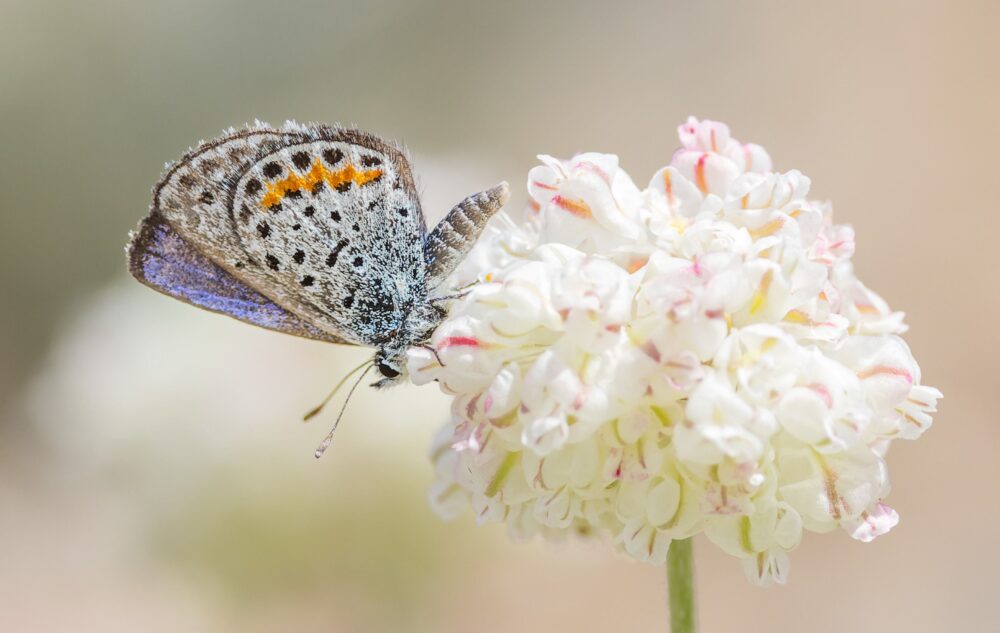
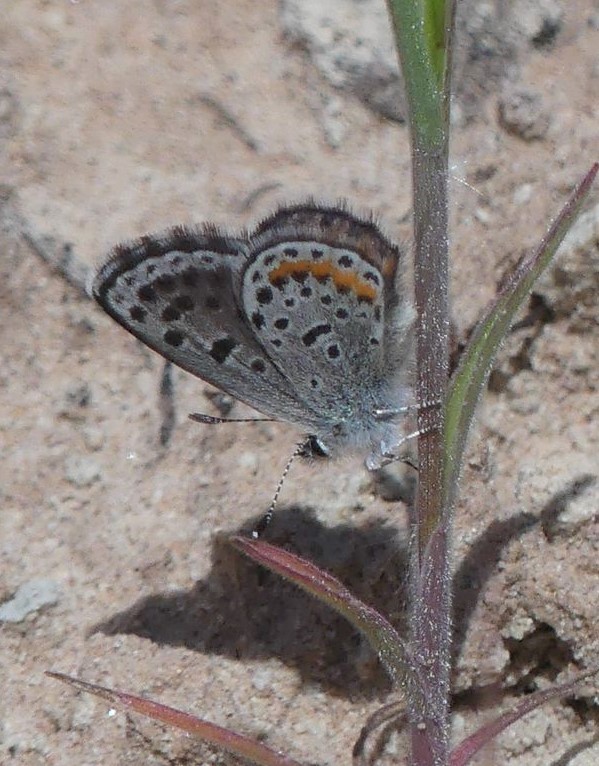
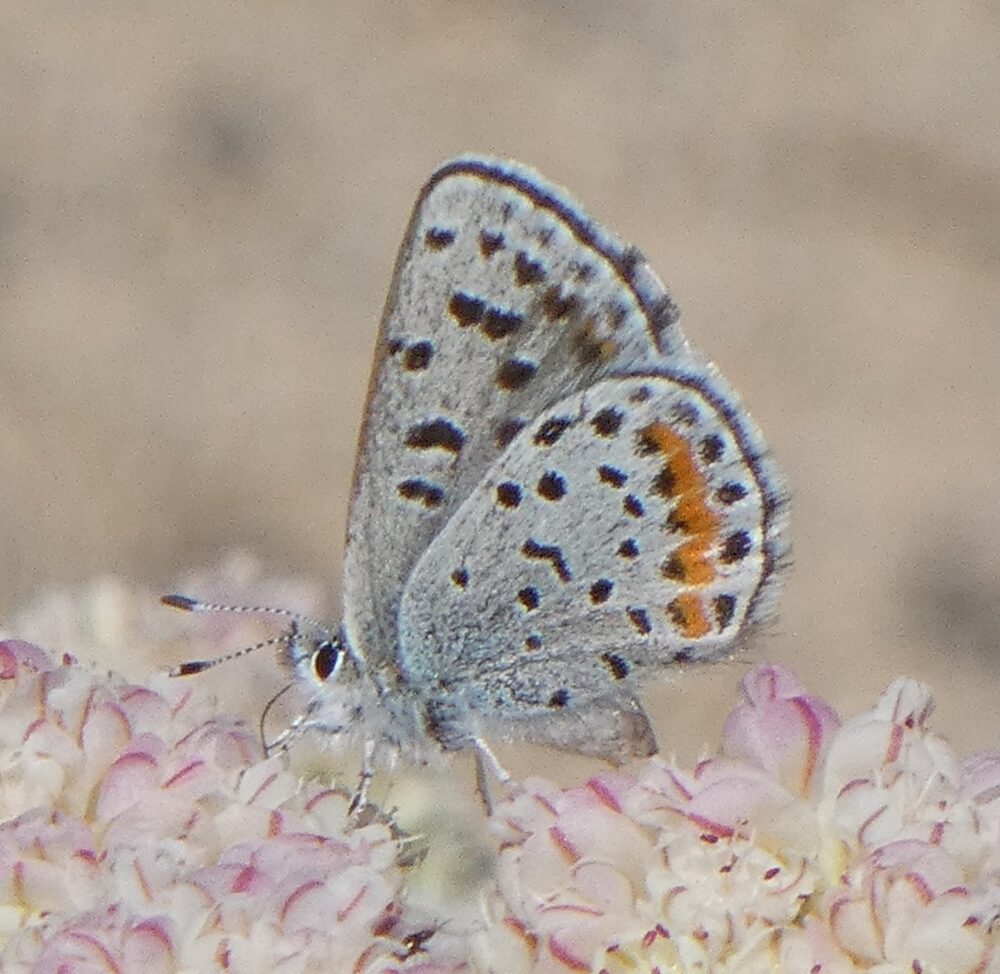
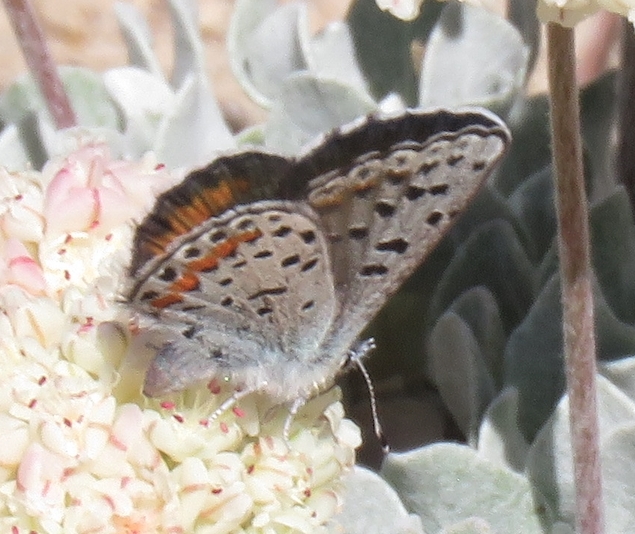
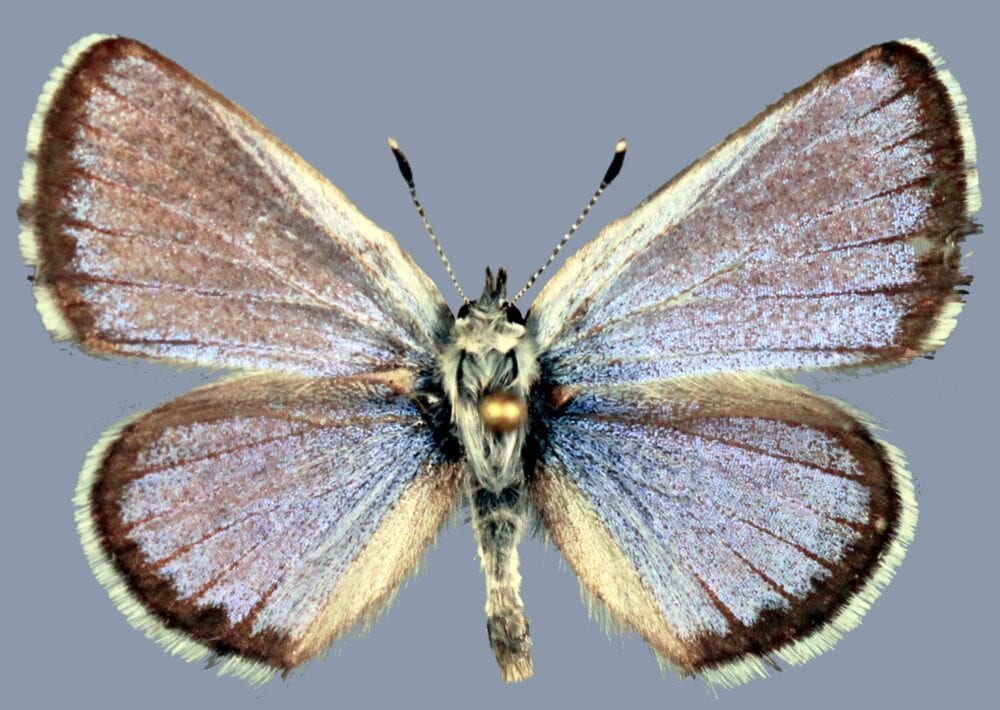
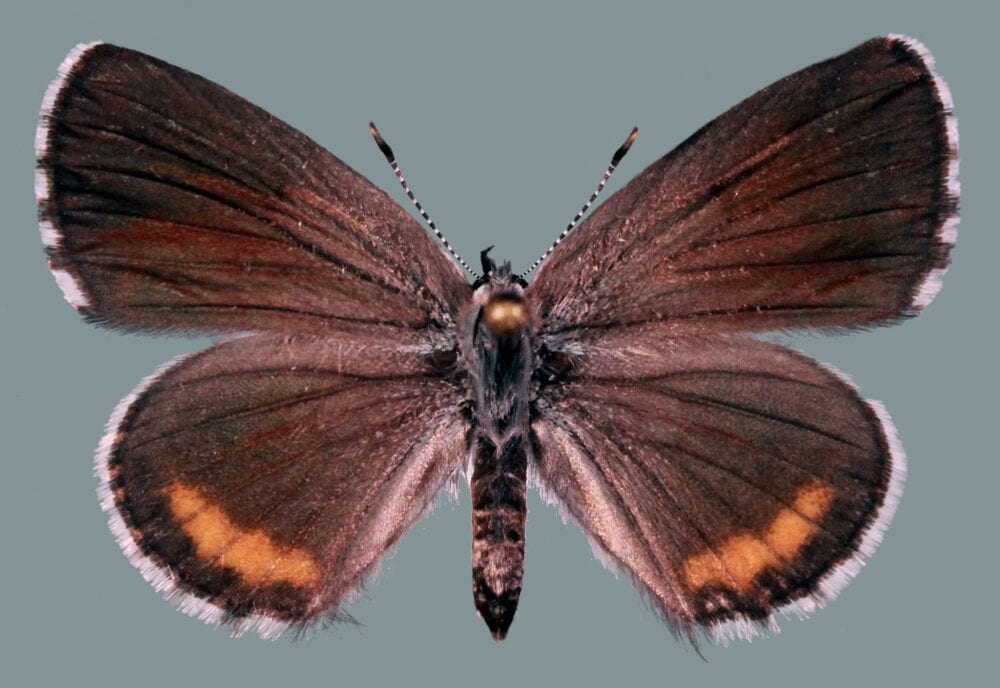
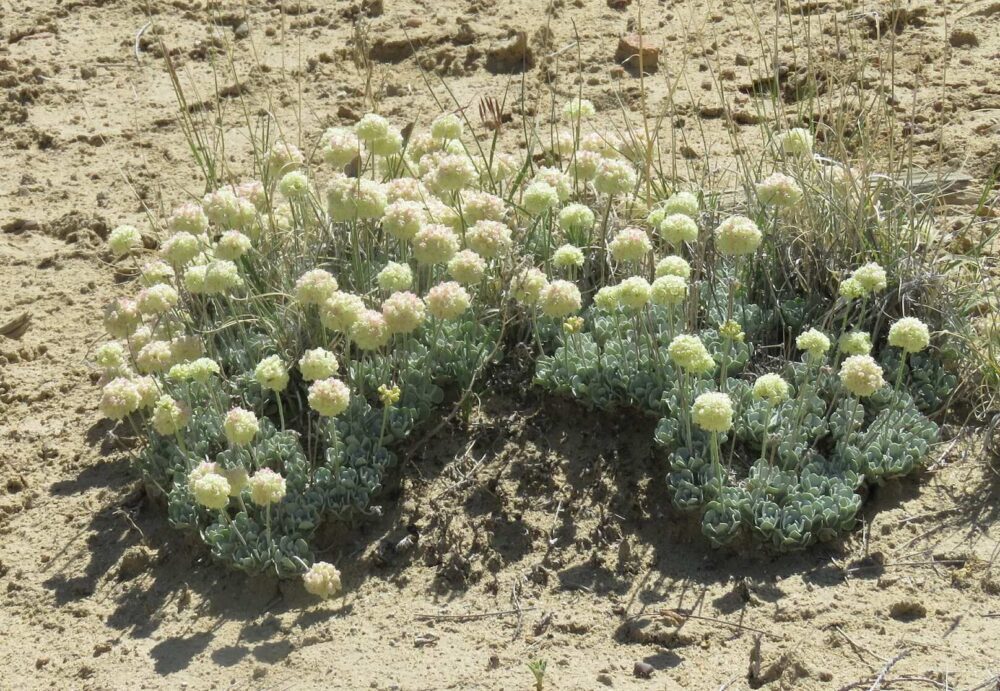
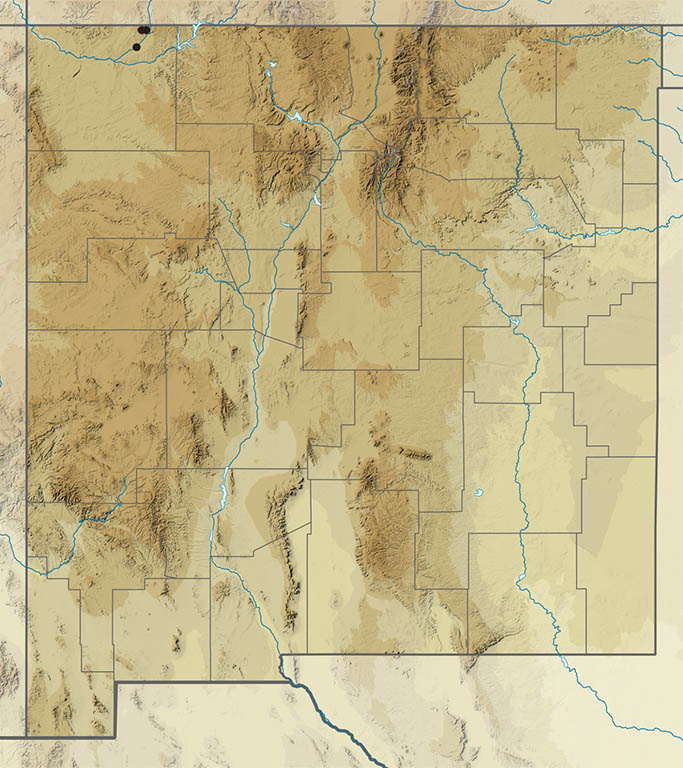
Euphilotes rita (W. Barnes & McDunnough 1916) Rita’s Blue (updated August 9, 2023)
Description. Rita’s Blue follows the general Euphilotes look, but minor differences are apparent. The topside orange band on female hindwings is rather broad. On males, the dorsal hindwing pink/orange aurora is more fully expressed and is accompanied by four or five well-defined, circular black spots in the submargin. The dorsal forewing black margin is thin, no more than 10% of the wing radius, as in Ellis’ Blue but not Central Blue. Fringe checkering is weak. Ventral forewing black spots are prominent, less smeared. Range and Habitat. Rita Blues lives throughout the American Southwest and northern Mexico. In New Mexico, they occupy Upper Sonoran Zone grasslands and shrublands where the larval host prospers (counties: Be,Ca,DA,Gr,Gu,Hi,Lu,MK,Qu,RA,Sv,SJ,SF,Si,So), typically 4800-8000’ elevation. Life History. Larvae eat various Eriogonum species available in their habitat around the state (see below). As with congeners, pupae overwinter. Flight. Adults perch upon and nectar at August- and September-blooming stands of their small perennial woody shrub hosts. Adults never wander far, but they often go to moist soil. Euphilotes rita flies relatively late in the season. Comment 1. At elevations from 4800 to 7,000 feet, southwest and south-central New Mexico have subspecies Euphilotes rita rita (counties: Be,Ca,DA,Gr,Hi,Lu,Si), whose larvae eat Eriogonum wrightii var. wrightii. Records for this form span July 15 to October 16. Comment 2. The southern Rocky Mountains subspecies, Euphilotes rita coloradensis (Mattoni [1966]), inhabits shrublands and savannas of encircling our north-central mountains and northwestern foothills (counties: Gu,MK,Qu,Sv,SJ,SF,So), 5500 to 8000’ elevation. Larvae of eat Eriogonum effusum, E. rotundifolium, perhaps E. lonchophyllum and others. A population of Rita Blue at Sevilleta National Wildlife Refuge in central New Mexico (So) (see photo below) is hosted by Eriogonum effusum, so it is placed here. Our records span August 6 to September 9.
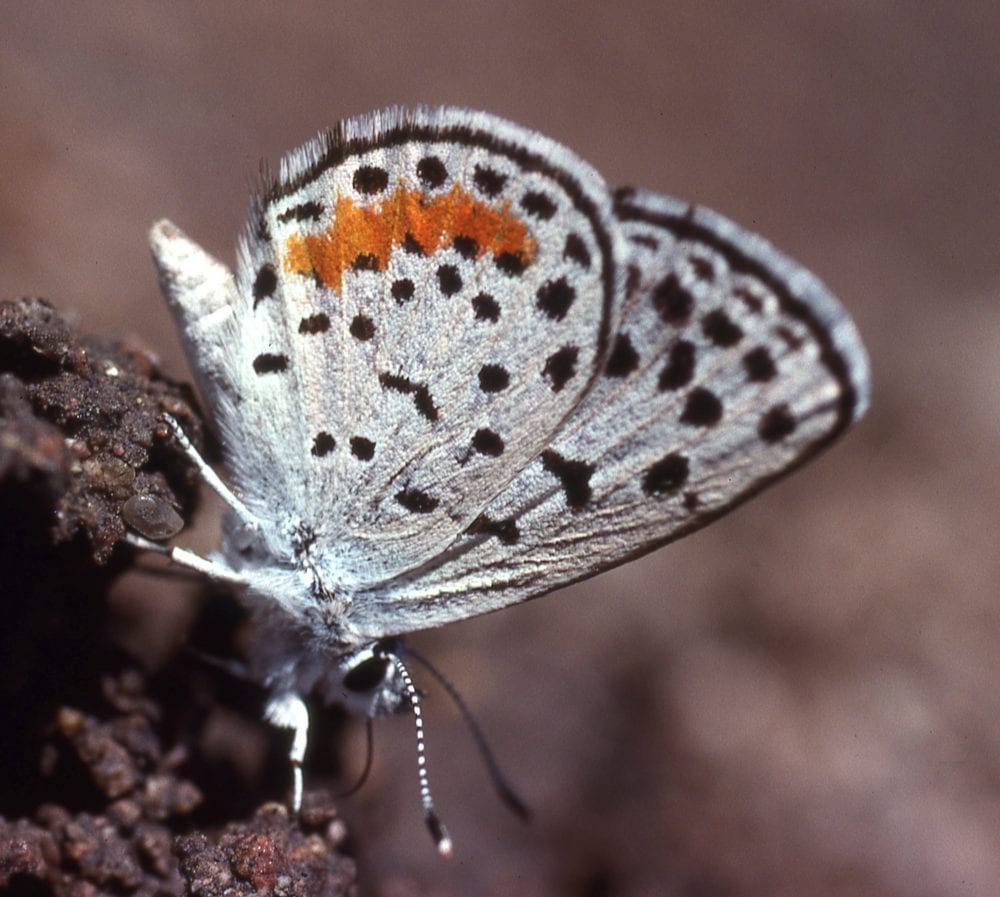
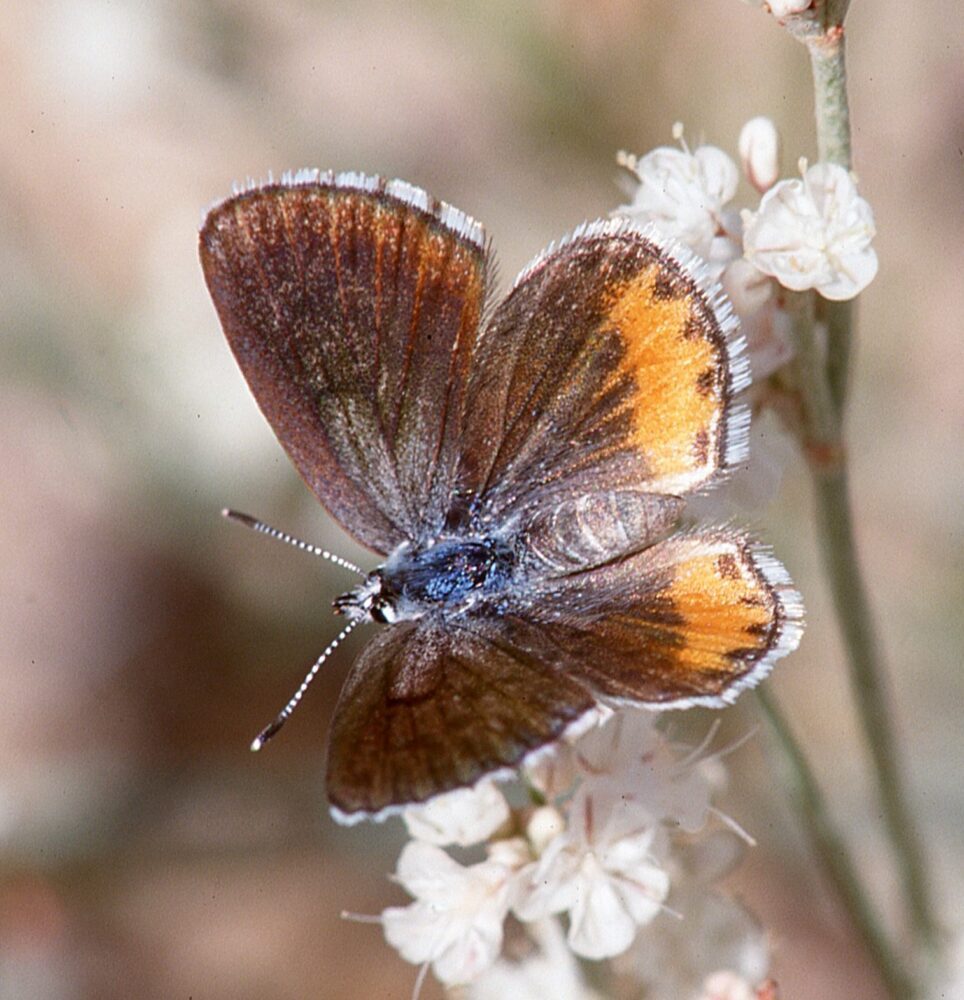
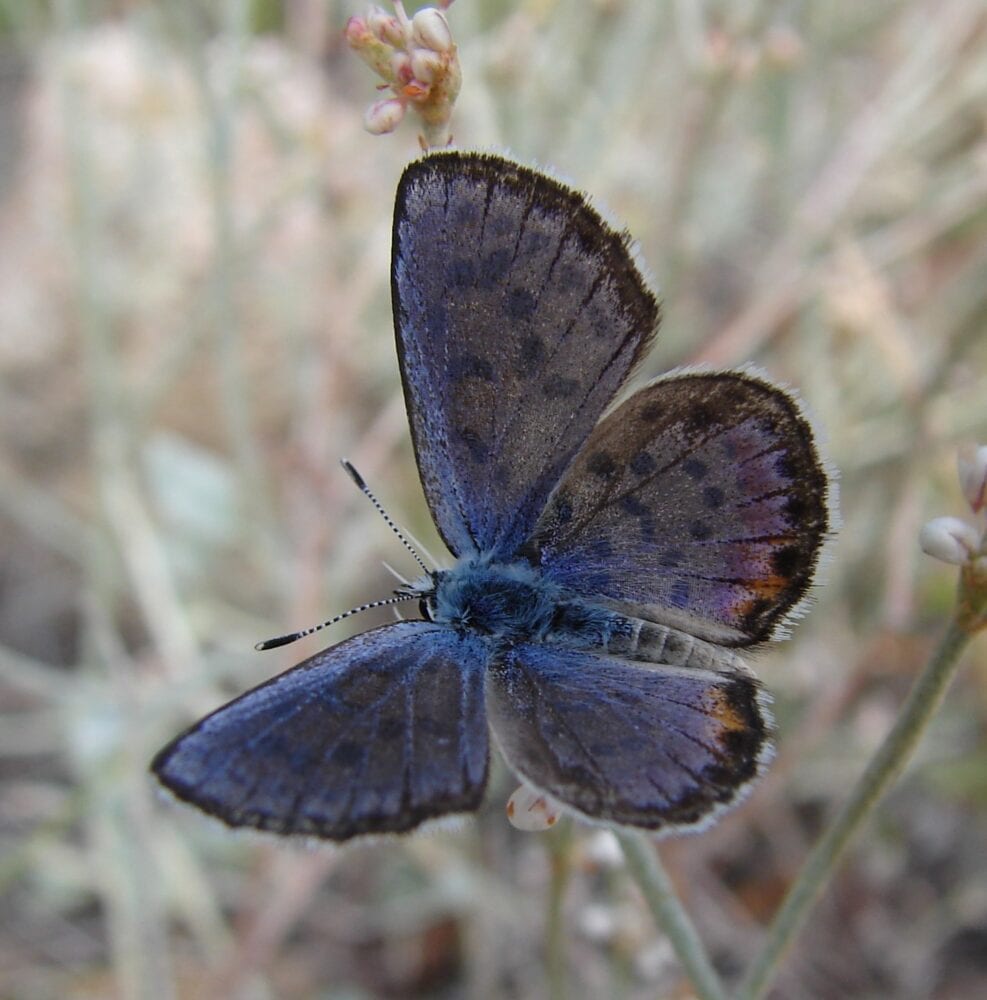
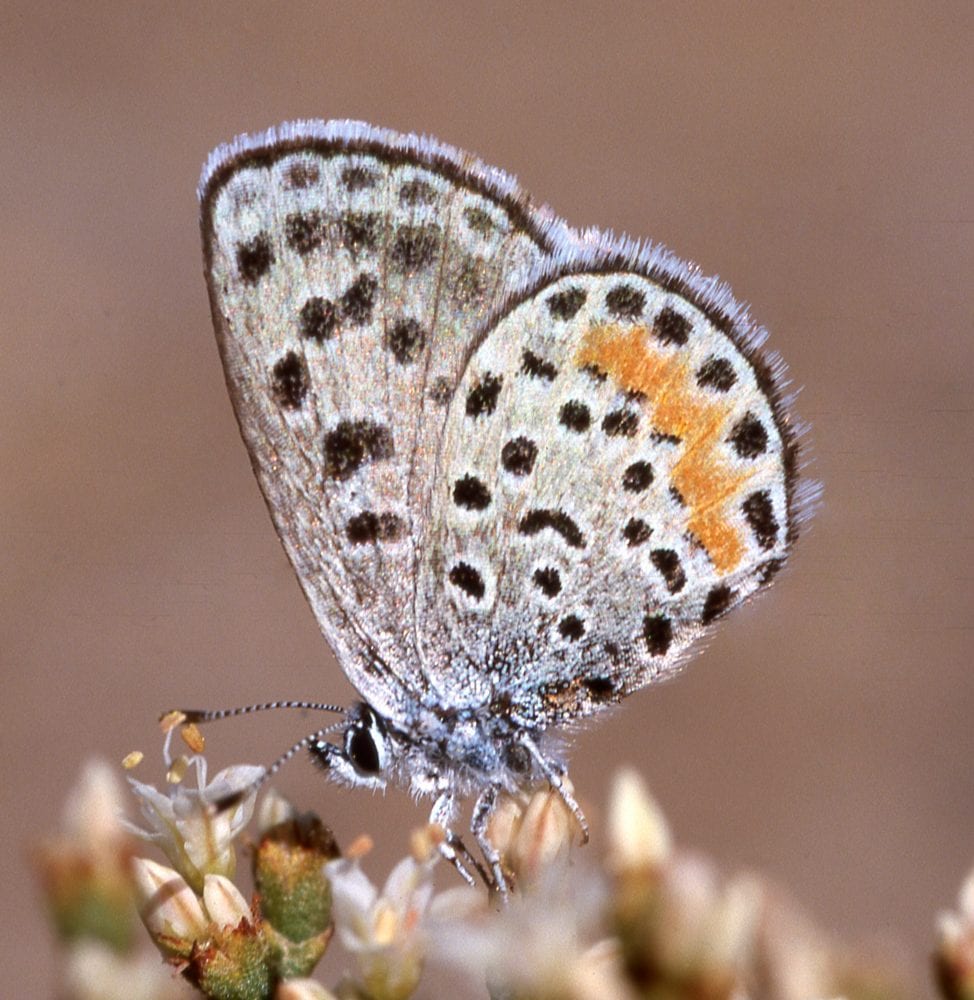
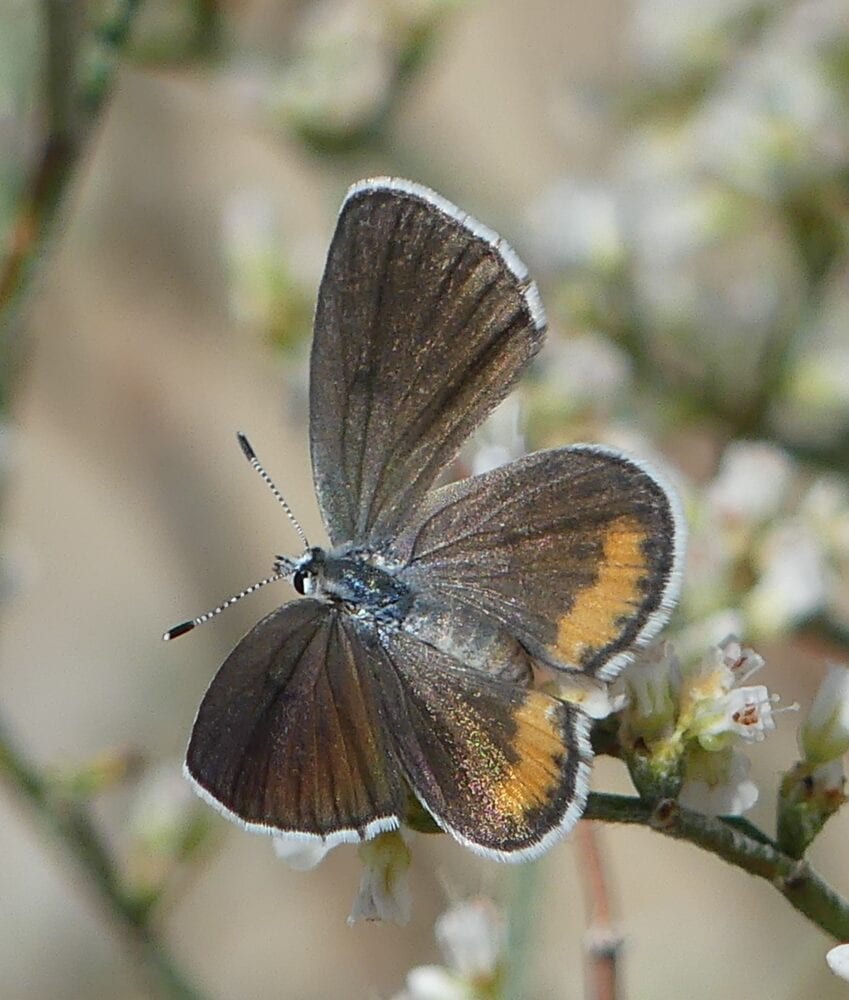
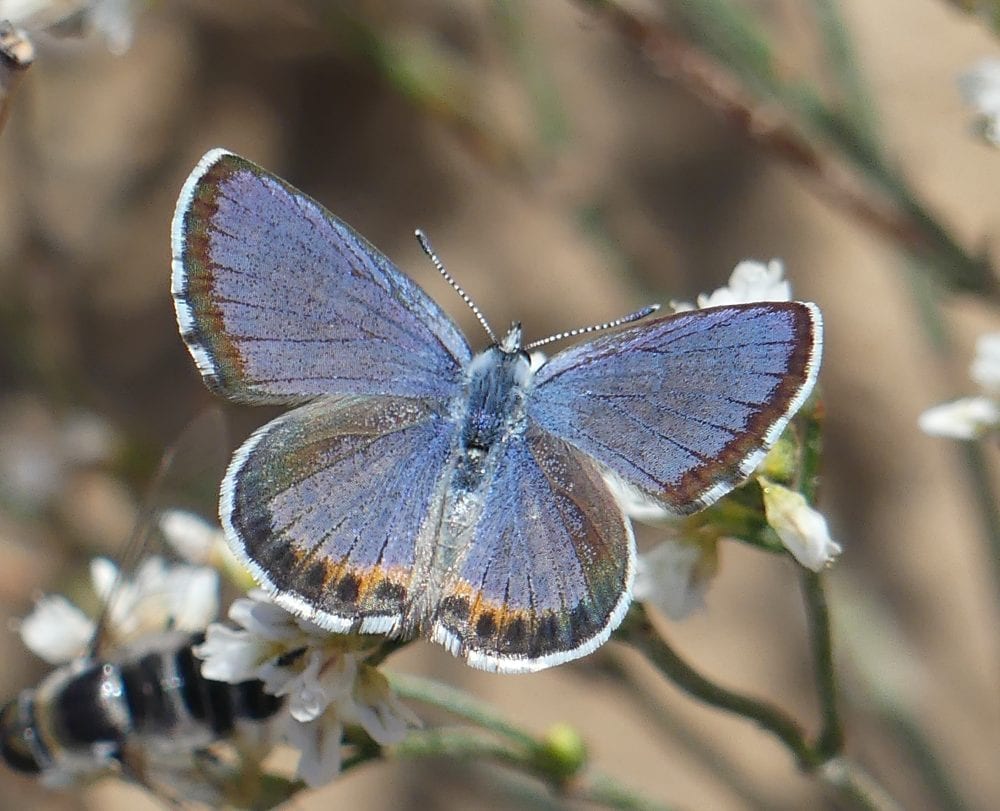
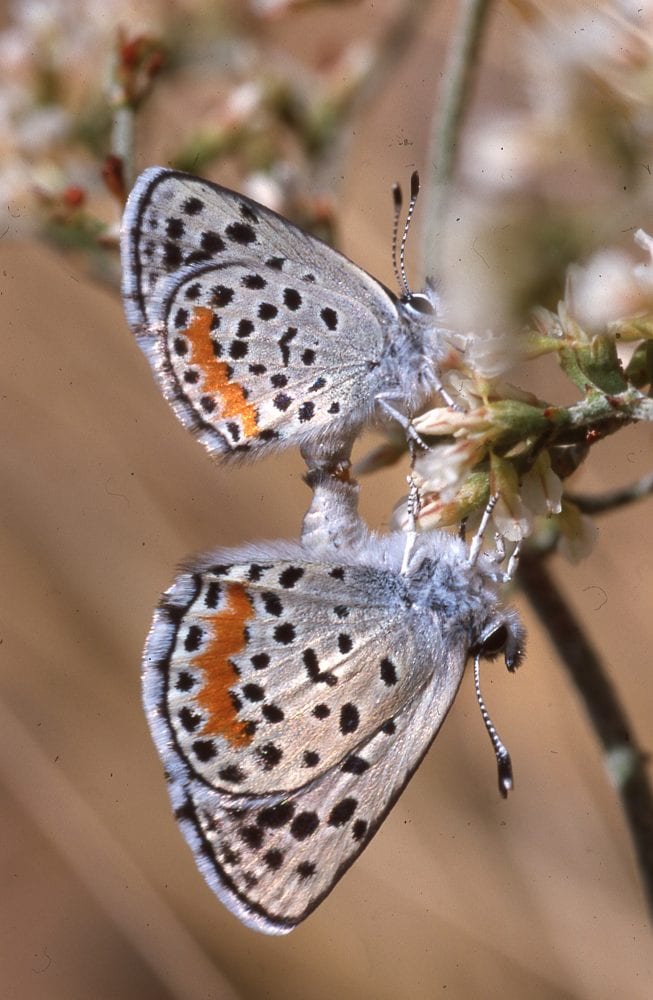
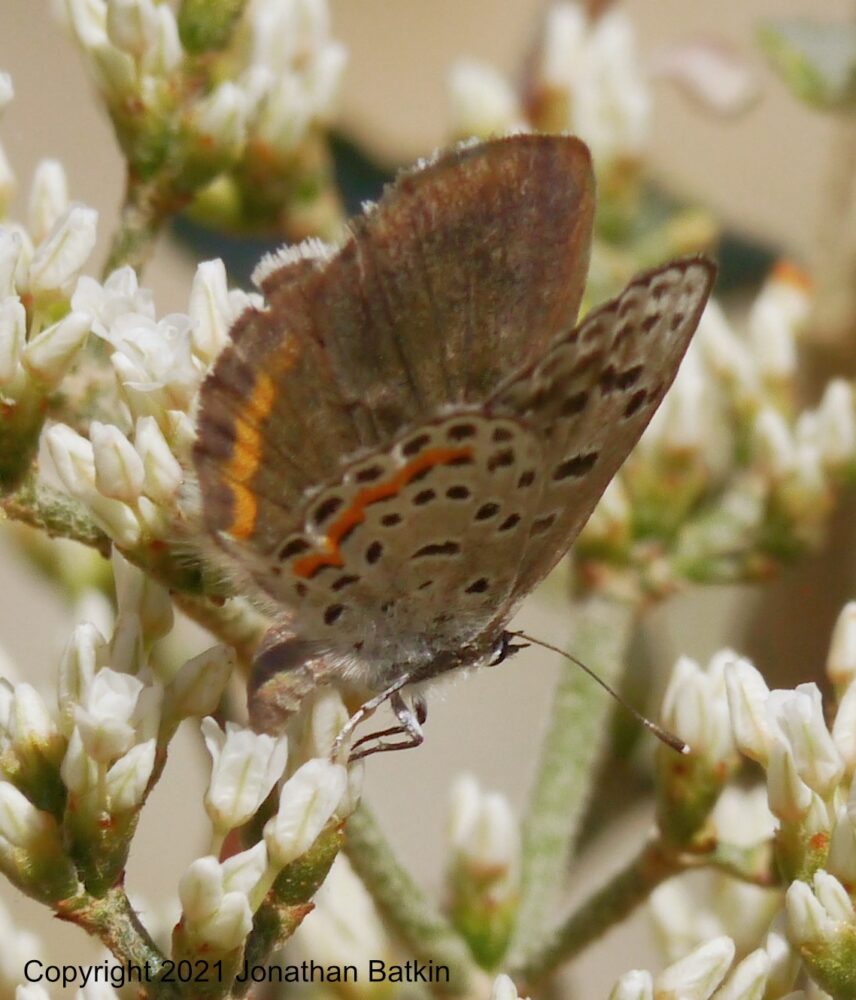
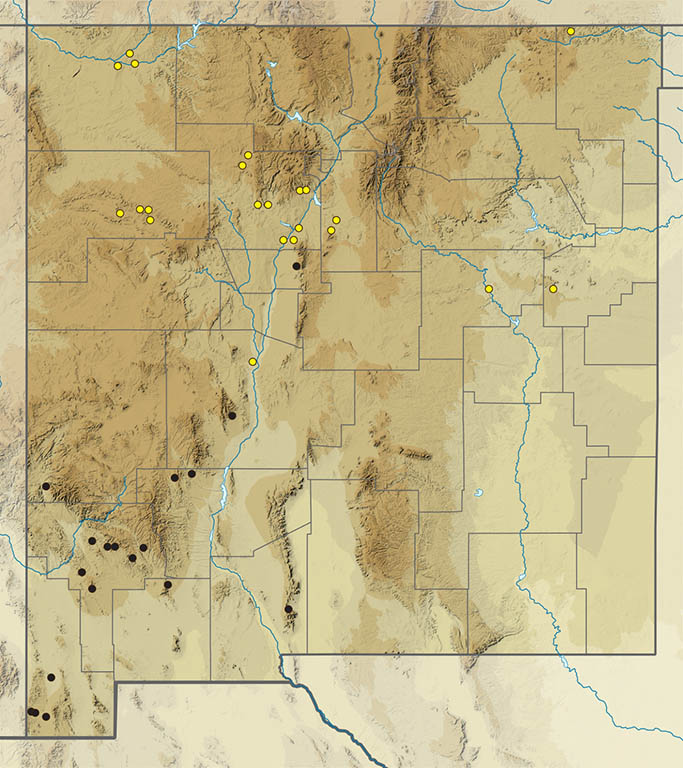
Euphilotes pallescens (Tilden & Downey 1955) Pallid Blue (updated May 22, 2022)
Description. Pallid Blue is paler than other buckwheat blues in three ways: the ventral ground color tends toward white as opposed to gray, the VHW black spots are small, and the VHW orange band tends to be thin. Range and Habitat. Look for this blue in the Colorado Plateau shrublands of UT, NV, northern AZ, western CO, and northwest NM (counties: MK,SJ). Life History. This species is said to be associated with a small number of different buckwheats, as described below. Flight. Adults fly from mid-August to mid-September. They roost, perch, court, mate and nectar among the host plants. We have very few New Mexico records and therefore our knowledge is rudimentary. Comments. Colorado Plateau ssp. Euphilotes pallescens emmeli (Shields 1975) has lighter blue males and uses Eriogonum leptocladon in NW NM (SJ). A largely sympatric race uses Eriogonum microthecum (MK). Much remains to be learned about this butterfly in New Mexico.
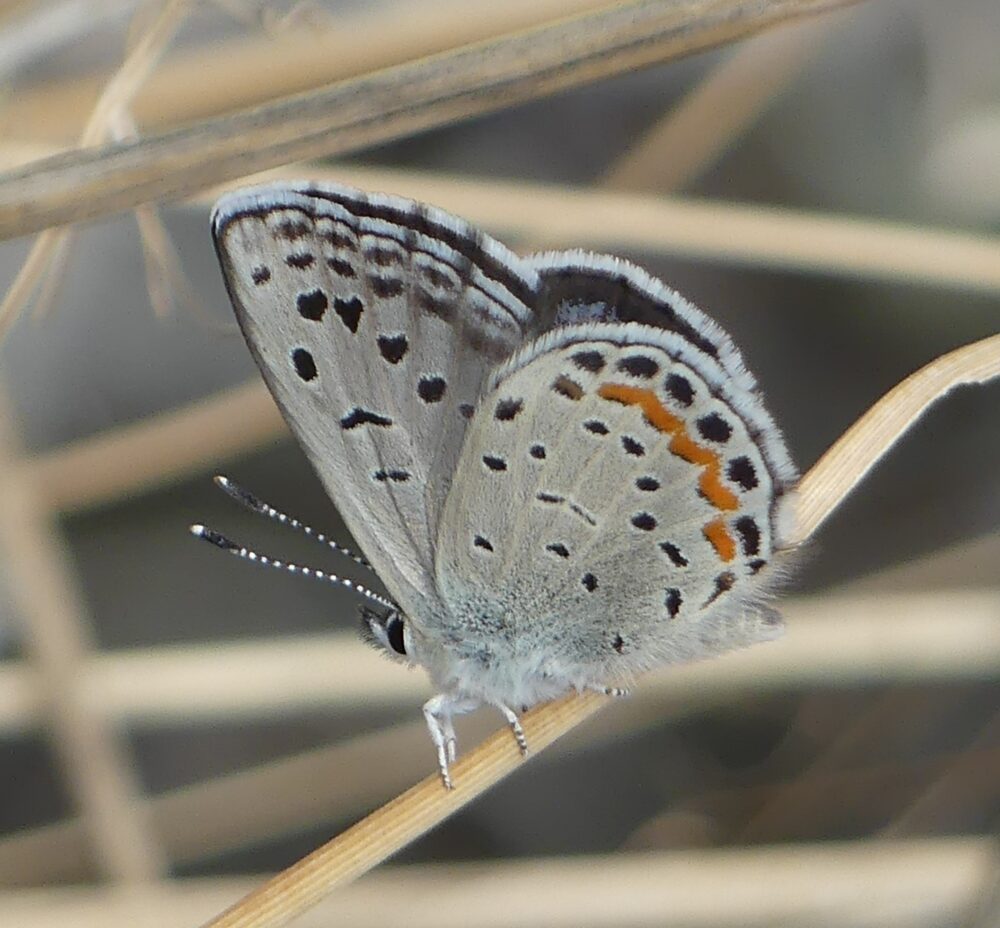
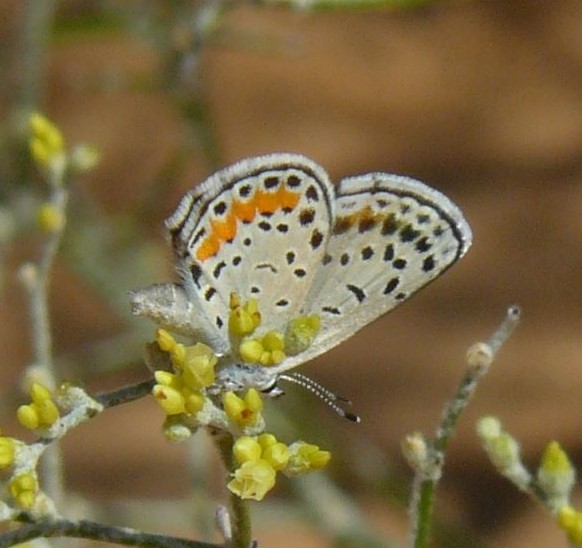
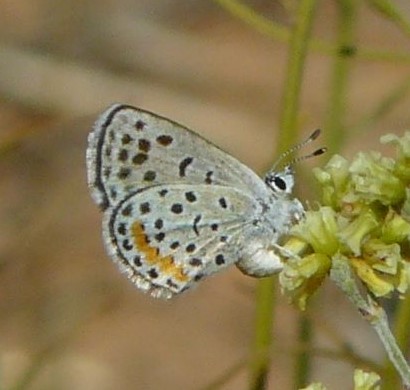
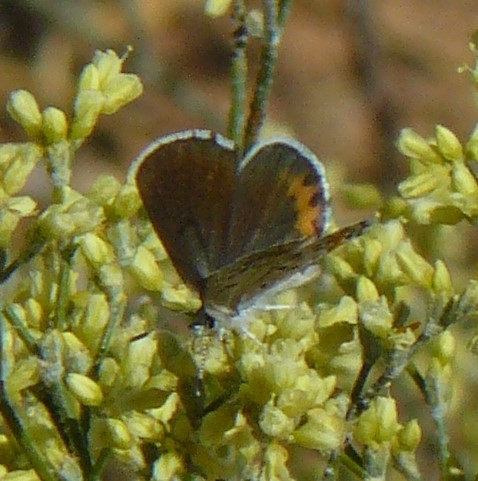
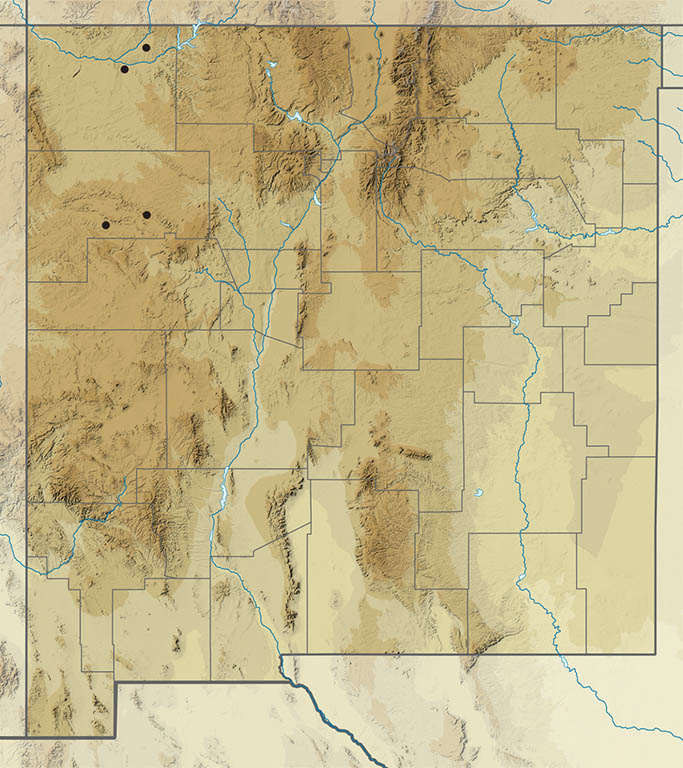
Glaucopsyche piasus (Boisduval 1852) Arrowhead Blue (updated May 24, 2022)
Description. Arrowhead Blue has bright blue males and blue-brown females. The hindwing below has a diagnostic band of white, arrowhead-shaped spots. The forewing below has a prominent postmedian band of white-ringed black spots. Range and Habitat. Glaucopsyche piasus lives in montane western US, inhabiting mixed woodlands. In New Mexico it has a limited distribution in mountain ranges ringing the San Juan Basin (counties: Ci,MK,Sv,SJ). It is found from 7,000 to 9,000′ elevation in the Zuni, Chuska and Mt. Taylor ranges. Life History. Females place eggs on various lupines (Lupinus spp.; Fabaceae). Ferris and Brown (1980) and Scott (1992) exclusively cite Lupinus argenteus (Silver Lupine) which is common in northern New Mexico and the probable host for our populations. Chrysalids overwinter. Flight. Arrowhead Blues have one annual brood. Adults are out and about from May 2 to June 30, peaking in late May and early June. Adults bask and perch on host lupines but will travel to gather nectar and sip electrolytes from moist earth. Comments. We have subspecies Glaucopsyche piasus daunia (W. H. Edwards 1871).
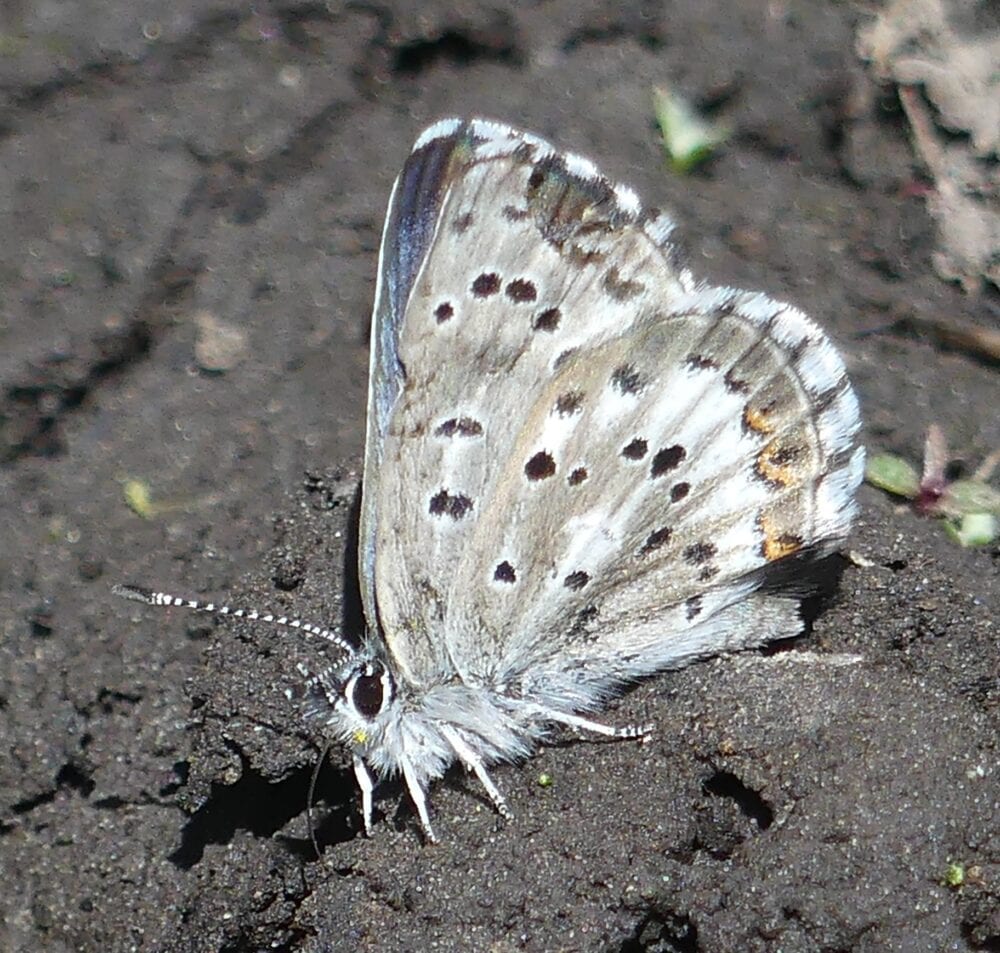
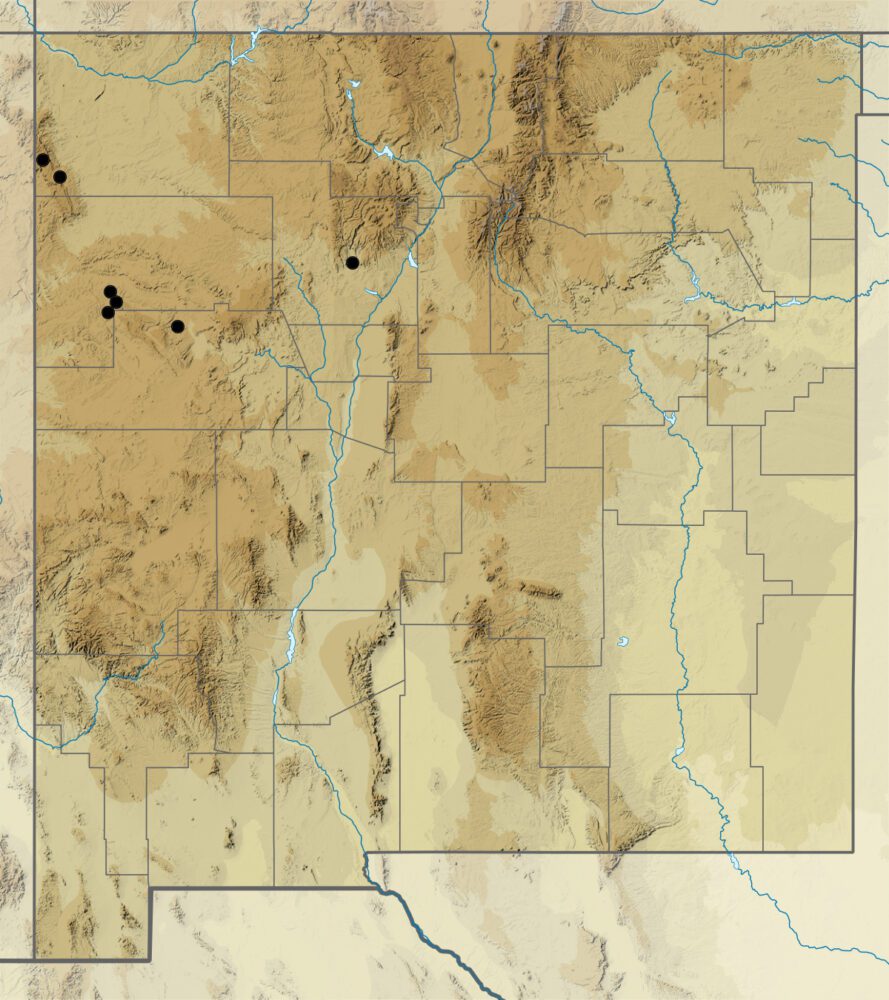
Glaucopsyche lygdamus (E. Doubleday 1841) Silvery Blue (updated July 21, 2023)
Description. Glaucopsyche lygdamus is unmarked glossy blue on the upperside, one of our more beautiful blues. On females, the blue is reduced to the basal area, leaving the distal area dark gray. Prominent postmedian bands of white-ringed black spots decorate the undersides against a pale, grey-tan background. Range and Habitat. Silvery Blues live in much of boreal North America from northern Alaska south to Baja California, east to Newfoundland, and south to the Ozarks and Appalachians. In New Mexico it occupies upland savannas and meadows (counties: Be,Ca,Ci,Co,Gr,Ha,Li,LA,MK,Mo,Ot,RA,Sv,SJ,SM,SF,Si,So,Ta,To, Un), generally 6500 – 11,000’. Life History. Larvae eat legumes (Fabaceae) such as Lupinus argenteus, Oxytropis lamberti, Thermopsis divaricarpa and Astragalus spp. Lupinus sierrae–blancae is used in the Sacramento Mountains (Li,Ot). Pupae overwinter. Flight. Silvery Blues are broadly univoltine in New Mexico with adults in flight from March 22 to July 27, depending on elevation; one very late record is August 28. Peak flight varies from May in the Gila and Sacramento Mountains to June farther north. Adults feed at flowers and moist soil. Comments. New Mexico has four named subspecies of which the two best known are Rocky Mountain subspecies Glaucopsyche lygdamus oro (Scudder 1876) in north-central New Mexico and Mogollon Rim subspecies Glaucopsyche lygdamus arizonensis McDunnough 1936 in southwest New Mexico mountains. Richard Holland (2011) described Sacramento Mountains and Sierra Blanca (Li,Ot) subspecies Glaucopsyche lygdamus ruidoso (R. Holland 2011). He also described the race from the volcanic uplands of the Raton Mesa complex (Co,Un) as Glaucopsyche lygdamus erico (R. Holland 2011).
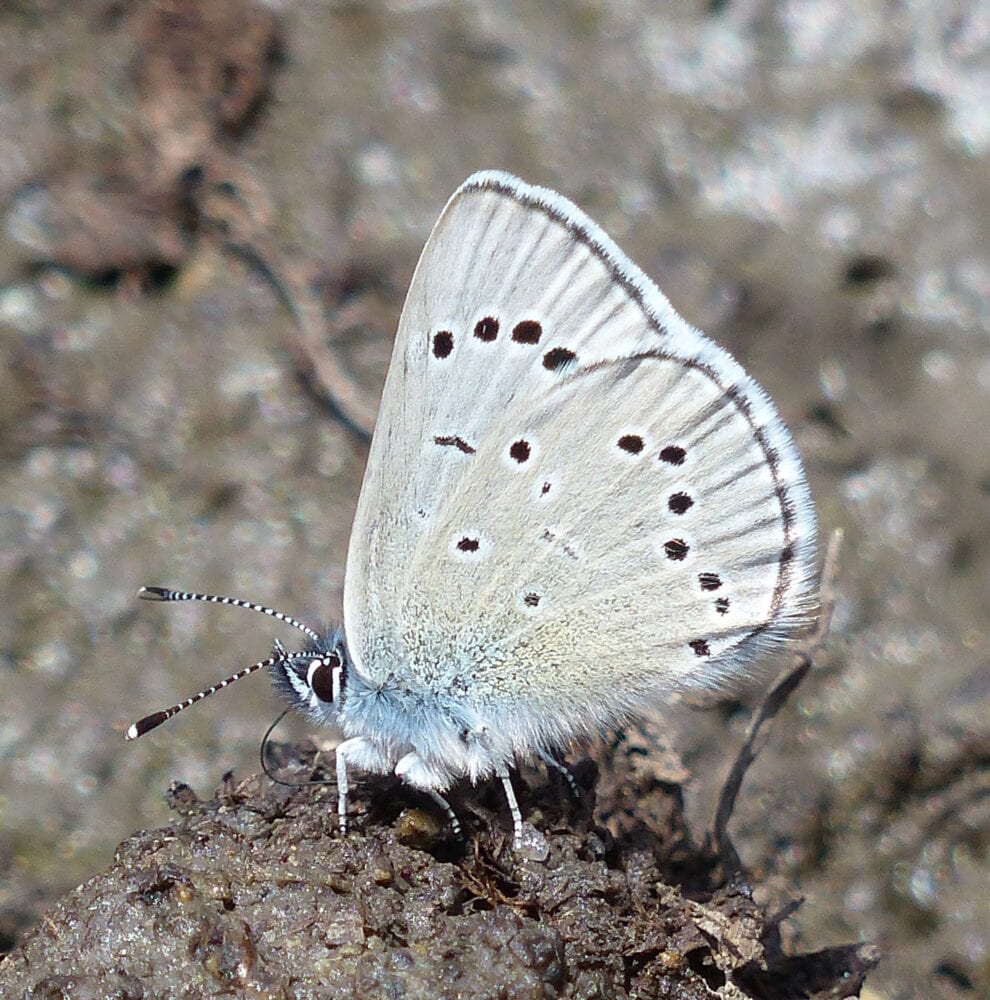
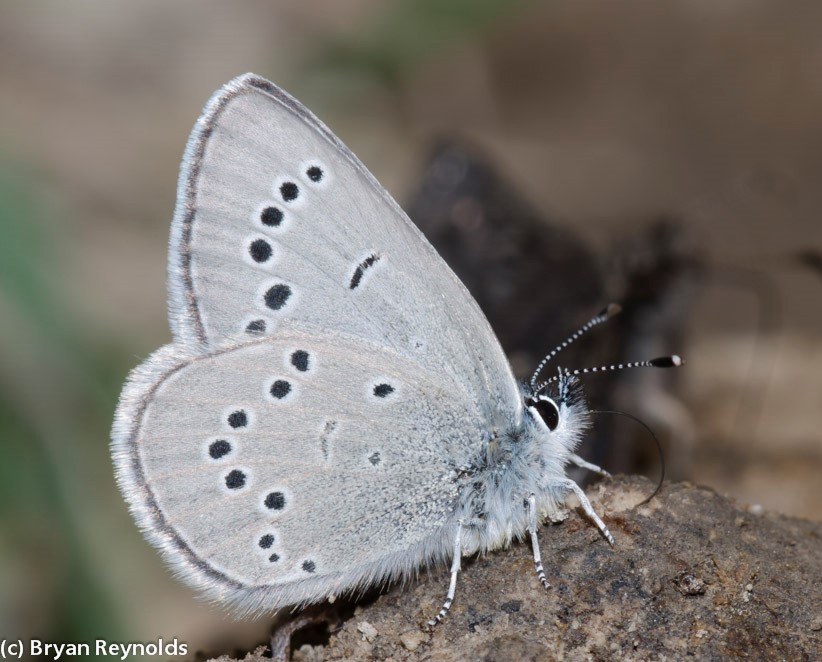
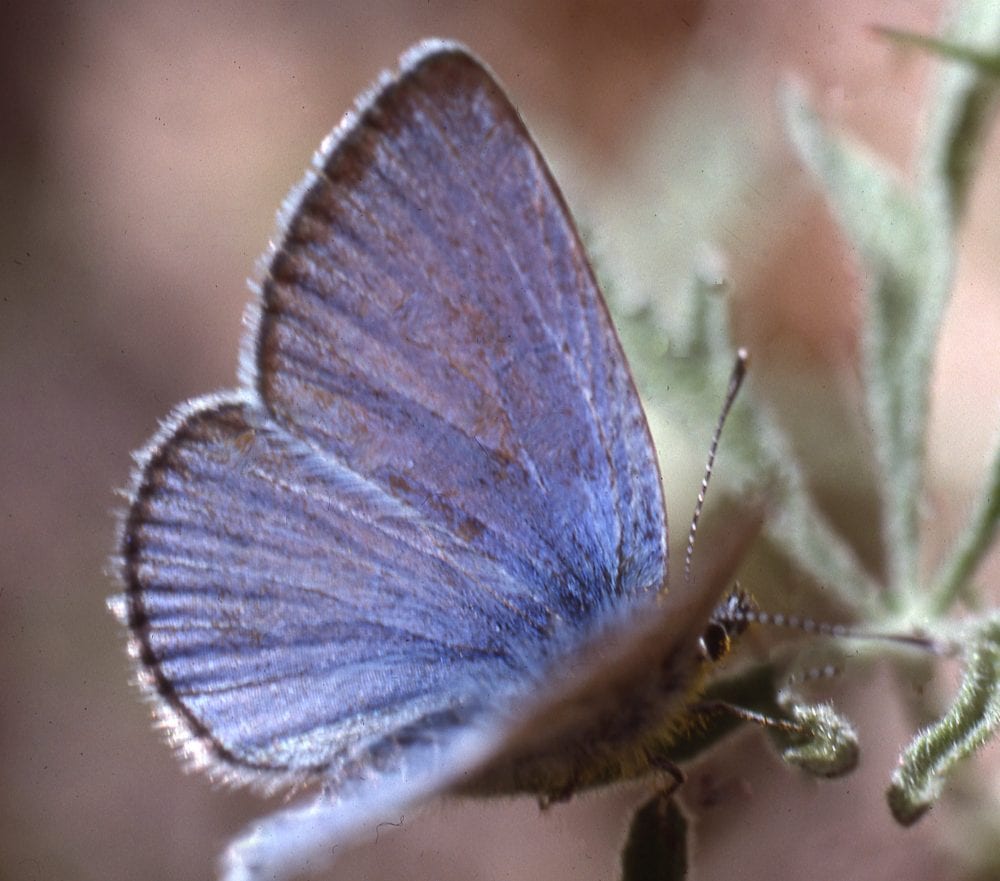
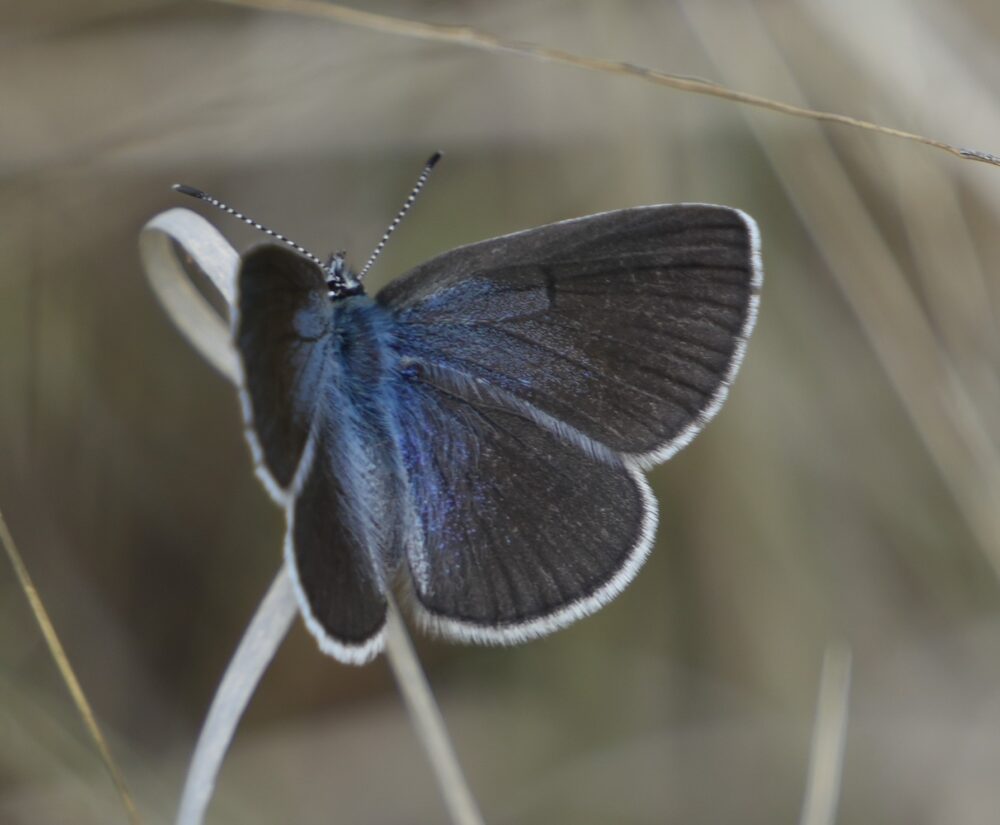
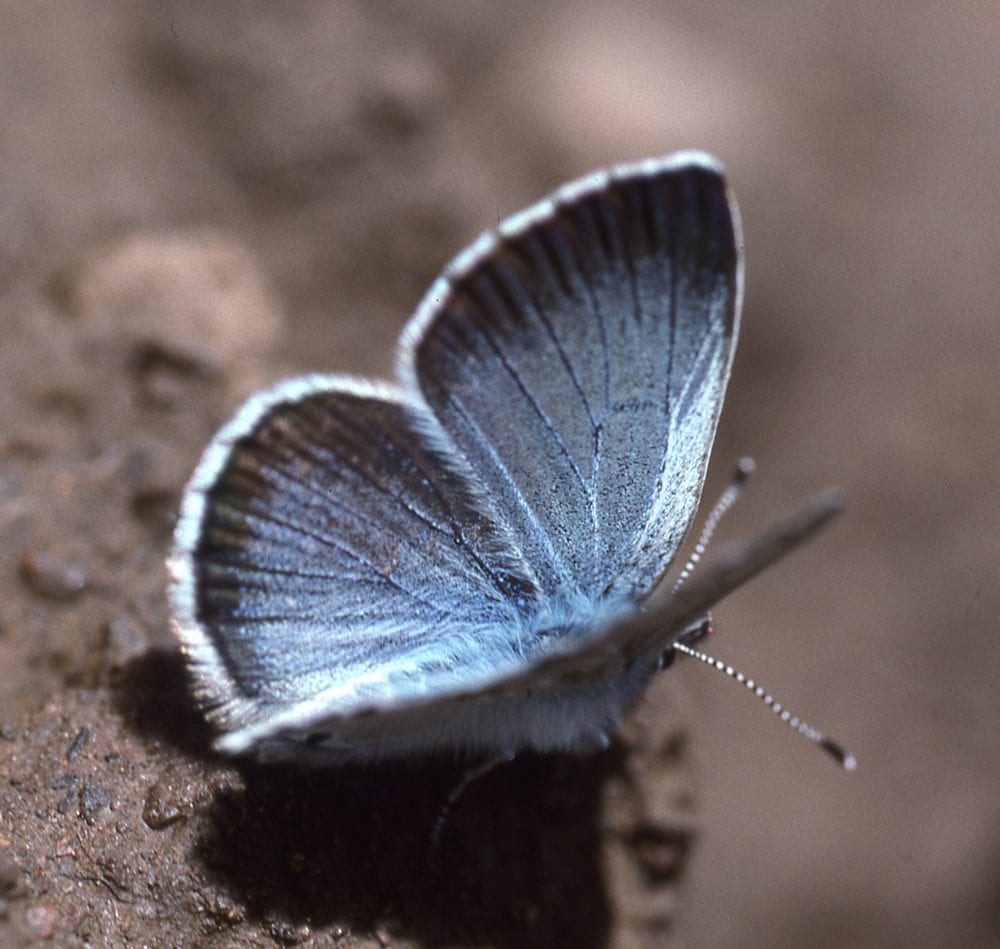
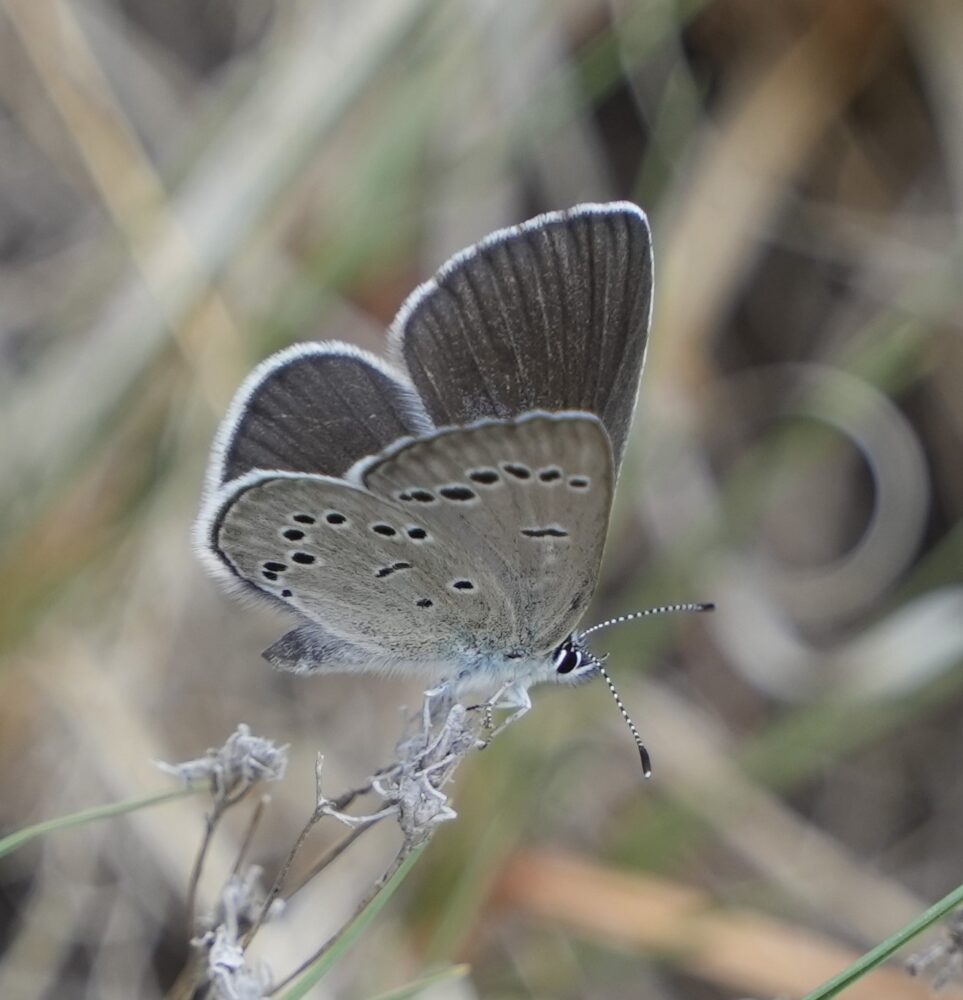
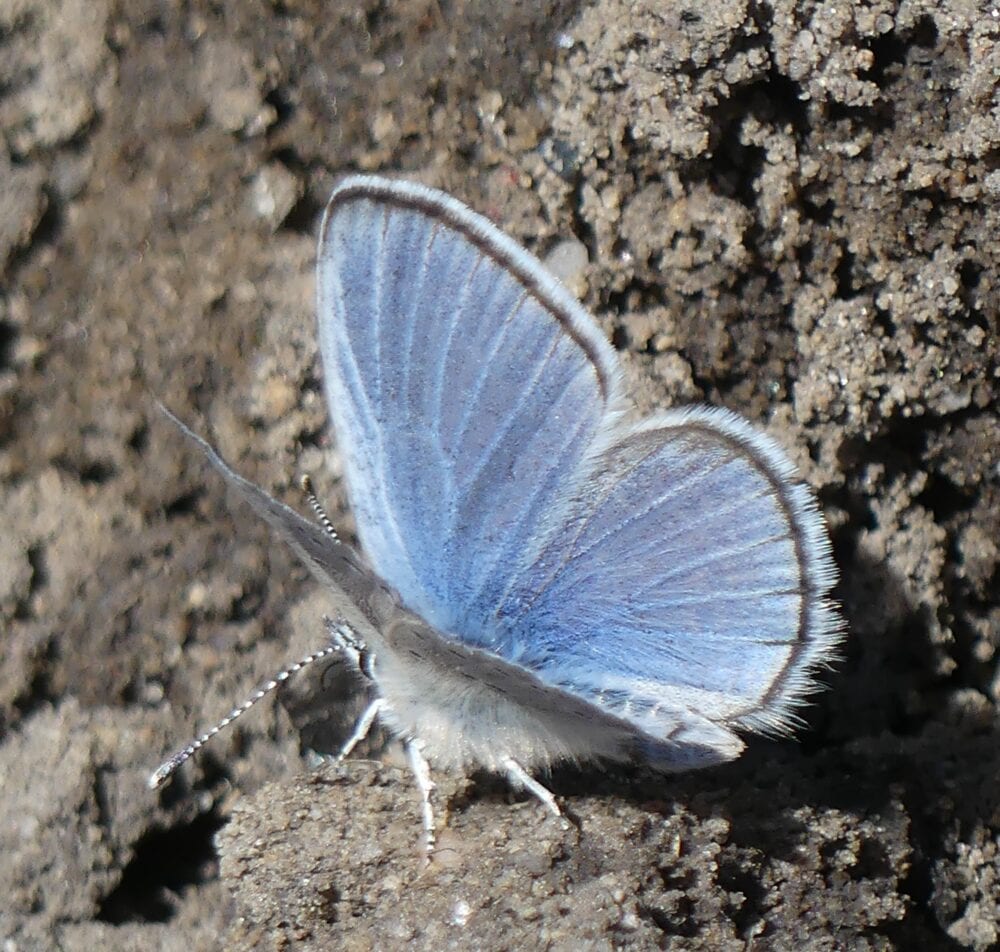
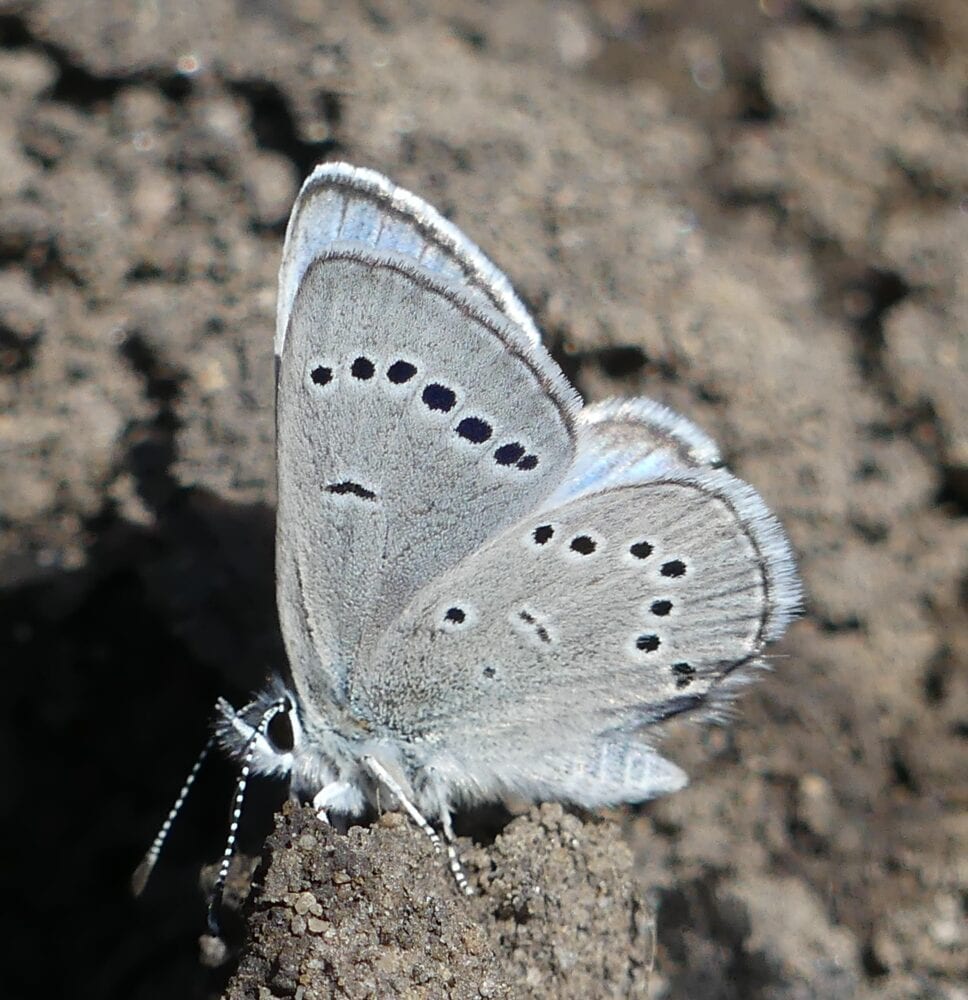
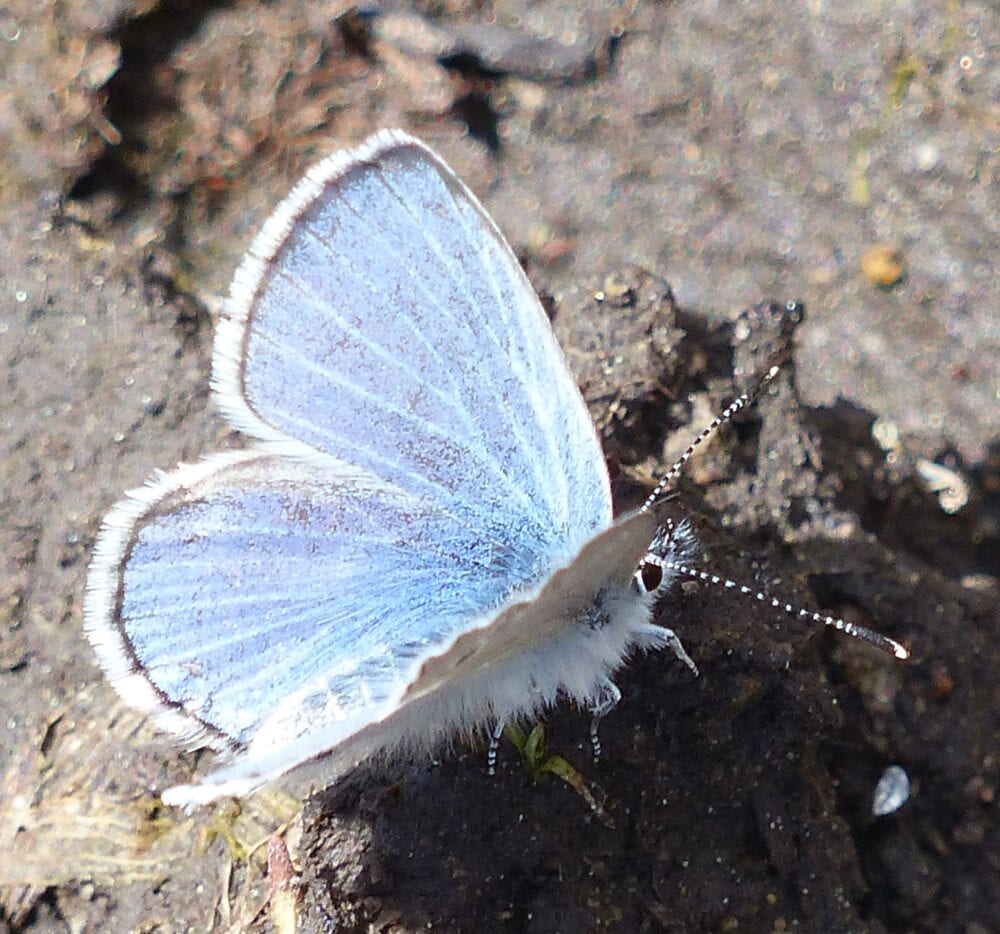
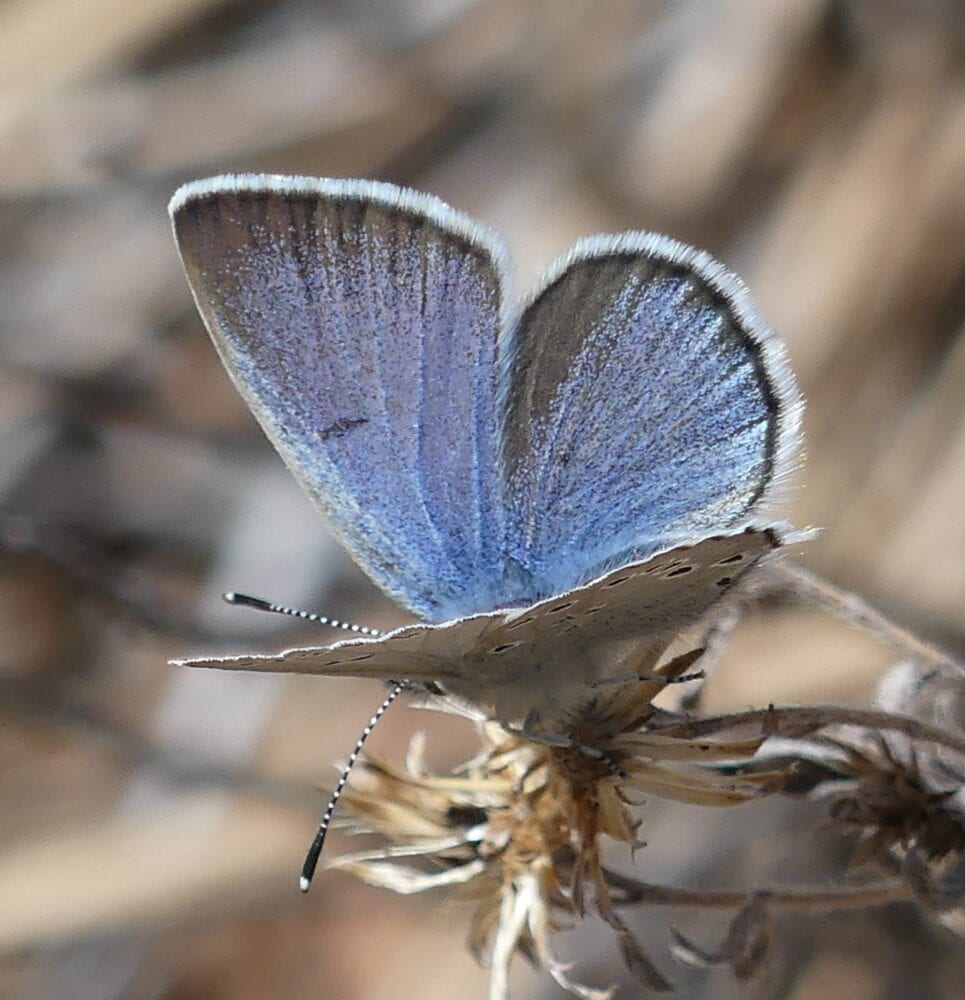
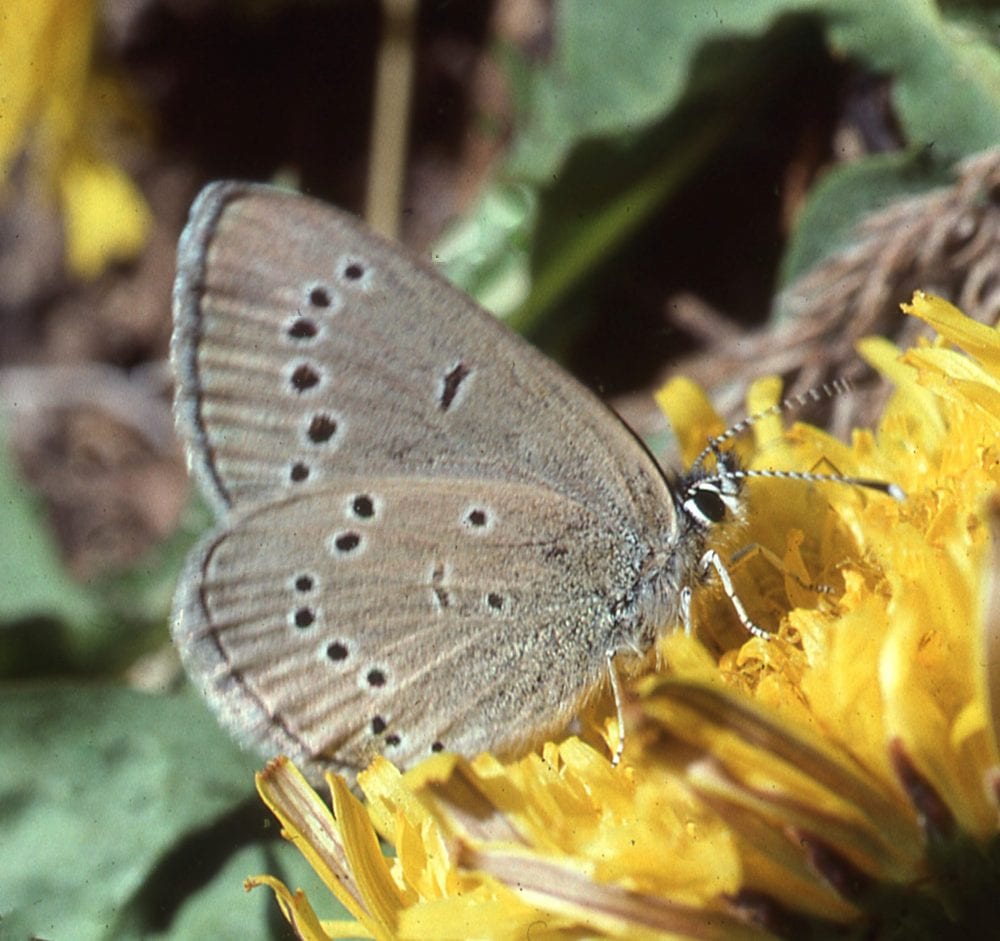
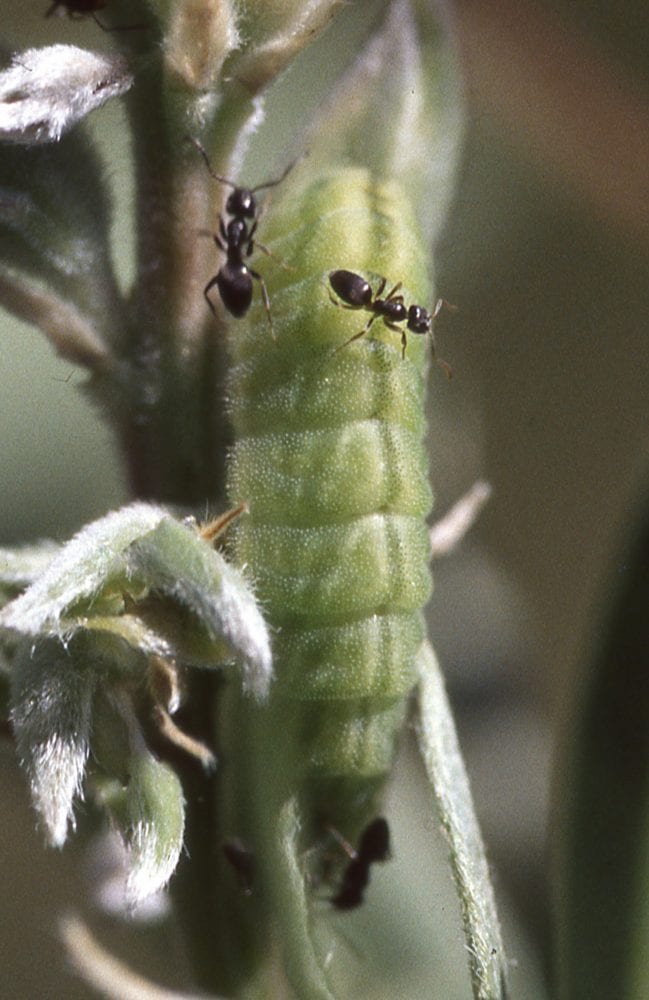
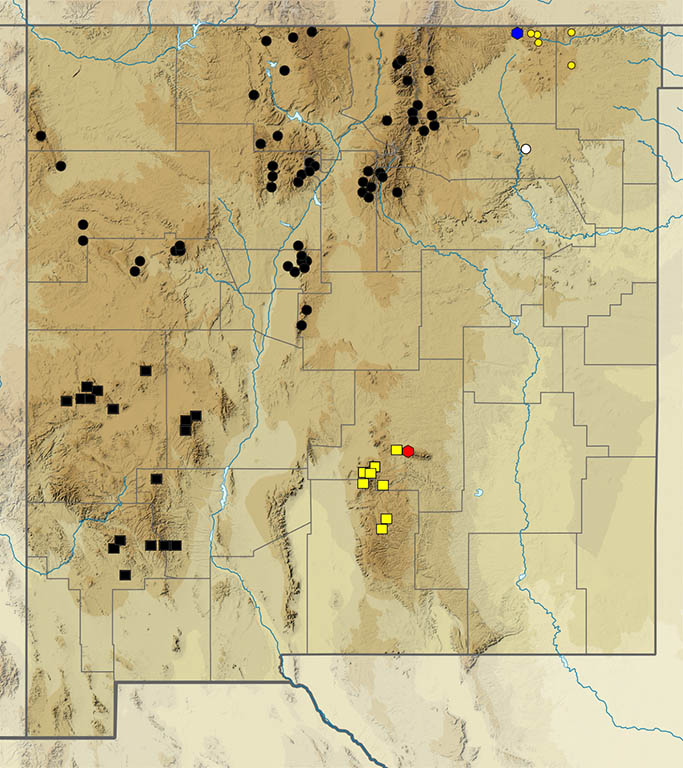
The Azures. Taxonomy and nomenclature within the Azures, genus Celastrina, continues to be in flux. As put more elegantly by LaBar et al. (2022), “The history of Celastrina has long been a complex and fascinating puzzle” and in our opinion that ain’t changing anytime soon. Some of the confusion derives from not knowing whether a particular named taxon is distinct at the species or subspecies level. DNA studies may have the capability to clarify this matter but attempts to date have all met with difficulty and nothing has yet been published. Standard and routine DNA analyses are not generating the hoped-for concise and well-defined phylogenetic tree. This suggests that real-life relationships within Celastrina are themselves not clearly defined in nature and that the different Celastrina entities may themselves not function or behave like standard species or subspecies. This can happen when one taxonomic entity is in the process of diverging and differentiating into two, but then are thrown back together, say by reversal of environmental changes that started them on their path toward differentiation. There are different degrees of differentiation (well, a continuum); when the process continues long enough that two entities no longer recognize each other, then we have two species. But getting there can be a long road, and that process does not always run to a conclusion. That leaves two entities somewhat different, but still able to interbreed to some degree. On the ground, consider an internally reproducing entity that is distinctly itself in the heart of its distribution, but where it overlaps in time and space with a near relative, they are able to interbreed and thus the genes are still mixing.
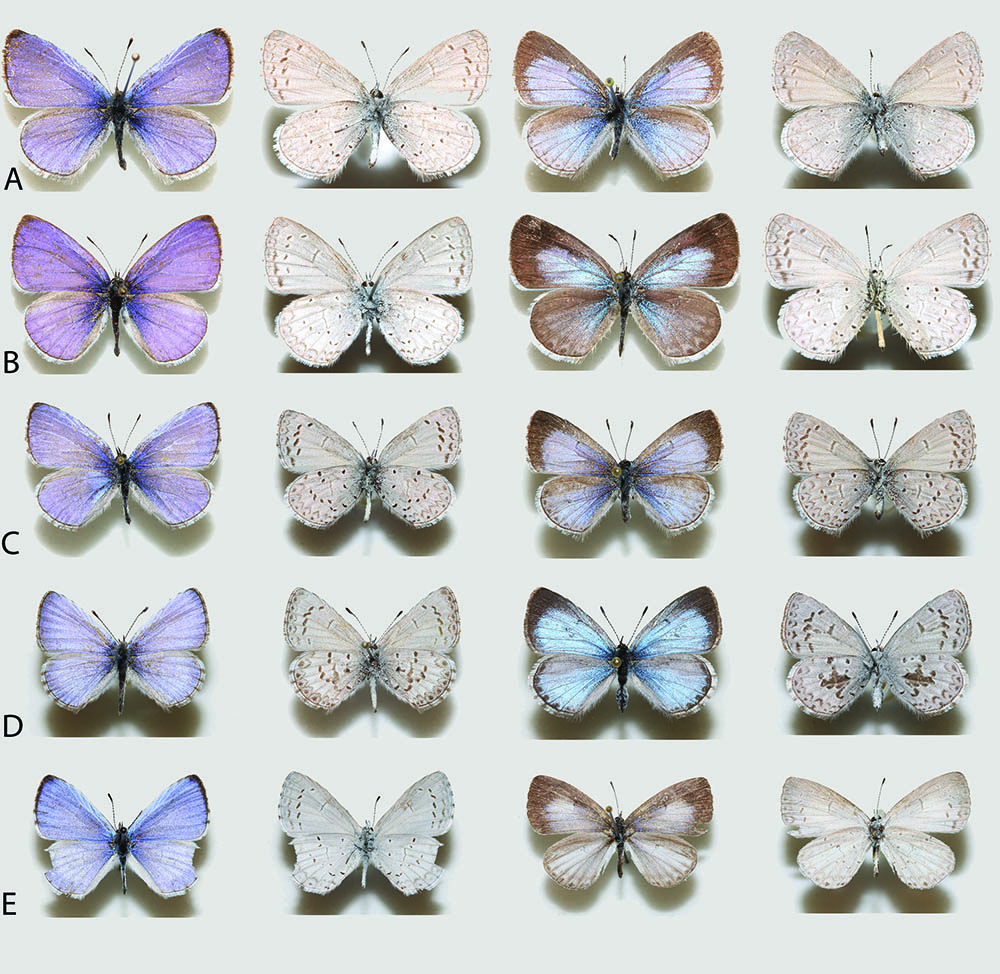
Celastrina gozora (Boisduval 1870) Mexican Azure (updated August 12, 2024)
Description. In New Mexico, Mexican Azures are iridescent sky blue above; males have a thin black DFW margin whereas females have a very broad black forewing postmedian/submarginal area, broader than on other azure females, extending to the FW’s trailing edge. Undersides are white or pale gray, overlaid with a pattern of subdued gray chevrons, dots and dashes. White fringes have dark vein-end checks which are small on FW and faint to absent on HW. Other azures (sidara and lumarco) with which Mexican Azure flies in northern NM, have a grayer ventral ground color and dark marks are bolder, blacker. Azures are larger than the similarly marked and aptly named Tiny Blue (Zizula cyna). Range and Habitat. A butterfly of Mexico and Central America (typical gozora ), Mexican Azure ranges into the southwestern US as subspecies cinerea (W. H. Edwards 1883) – ‘Southwestern’ Mexican Azure. This, our dominant azure, lives in Upper Sonoran to Canadian Zone canyons and woodlands in southern and western New Mexico, straggling up into the Sangre de Cristos (counties: Be,Ca,Ci,Co,DA,Ed,Gr,Gu,Hi,LA,Li,Lu,MK,Mo,Ot,Ro,Sv,SJ,SM,SF,Si,So,Ta,To,Va), between 4000 and 10,000′ elevation, perhaps even into extreme southern Colorado. Life History. Per Bailowitz and Brock (2021:105), larvae eat flower buds and fruits of shrubs, vines, or small trees in many plant families and genera. Examples include Rhamnaceae (Ceanothus), Fabaceae (Lotus, Calliandra, Amorpha), Rosaceae (Cercocarpus, Holodiscus, Peraphyllum, Petrophyton, Prunus), Polygonaceae (Eriogonum). Larvae are tended by ants. Flight. Adults eagerly visit flowers, mud, scat, etc. ‘Southwestern’ Mexican Azures complete at least two principal generations per year, with additional early or late emergences possible in southern regions. Records fall between January 22 and December 1, peaking in May-June and again in August-September. It is the only resident azure that flies from mid-July into autumn. Comment 1. Populations in New Mexico mostly fit within southwest subspecies Celastrina gozora cinerea (W. H. Edwards 1883), with some specimens exhibiting a tendency towards the nominate subspecies. These specimens have the upperside blue invaded to a greater or lesser extent by white. Comment 2. Differences between C. gozora cinerea and northern NM sidara and lumarco are subtle and we still have much to learn about the distribution of each entity in NM, especially in areas of overlap such as the Jemez and Sangre de Cristo Mountains. For example, why is double-brooded C. g. cinerea routinely observed in the Jemez Mtns. and NW NM but only rarely seen in the Sangre de Cristos east of the Rio Grande? Comment 3. A worn stray documented in Portales (Ro) by Sapkota et al. 2024, is known from ventral images only. It could also be C. neglecta, but the May 3 date is inconsistent with other (scarce) neglecta records from NM, which are all late summer, so we’re going with C. gozora., noting the shaky ID. Comment 4. Celastrina taxa seem to be in a continual state of taxonomic flux. DNA research has so far not been helpful in distinguishing species and subspecies, so the uncertainty seems likely to continue. North American (Nearctic) populations of Celastrina have been divided into at least 10 species. It is possible that more species will be discovered in New Mexico.
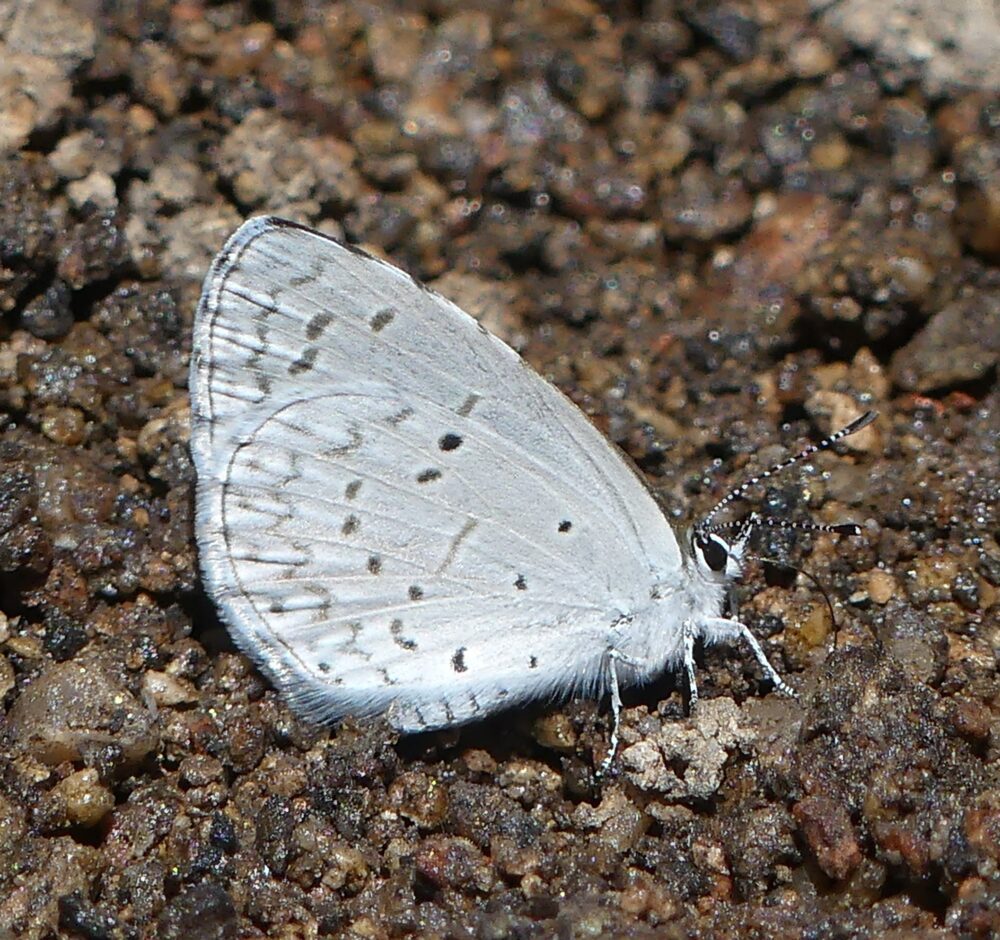
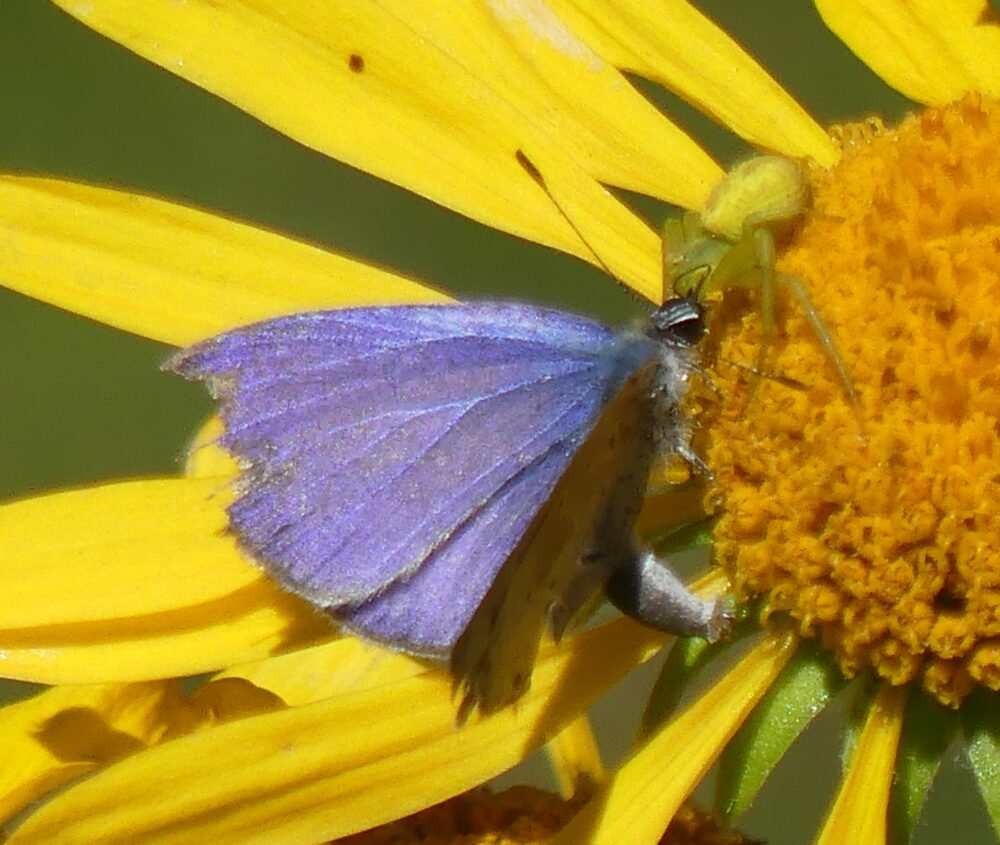
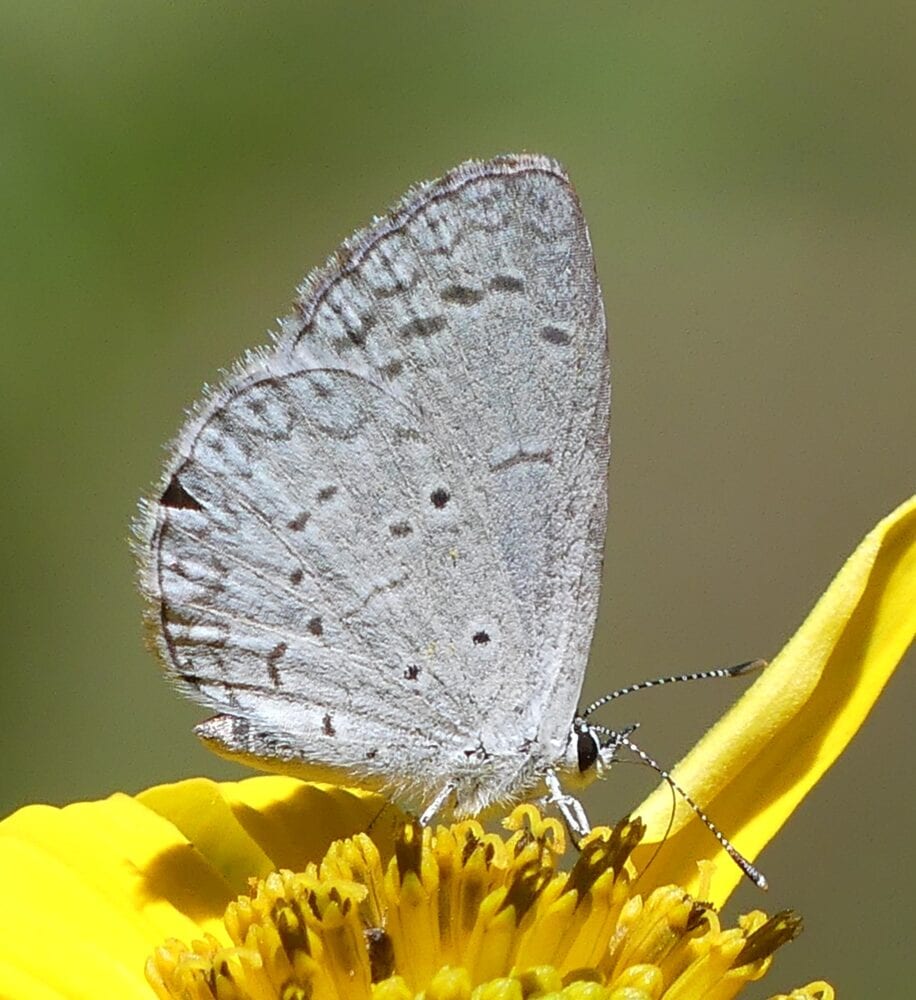
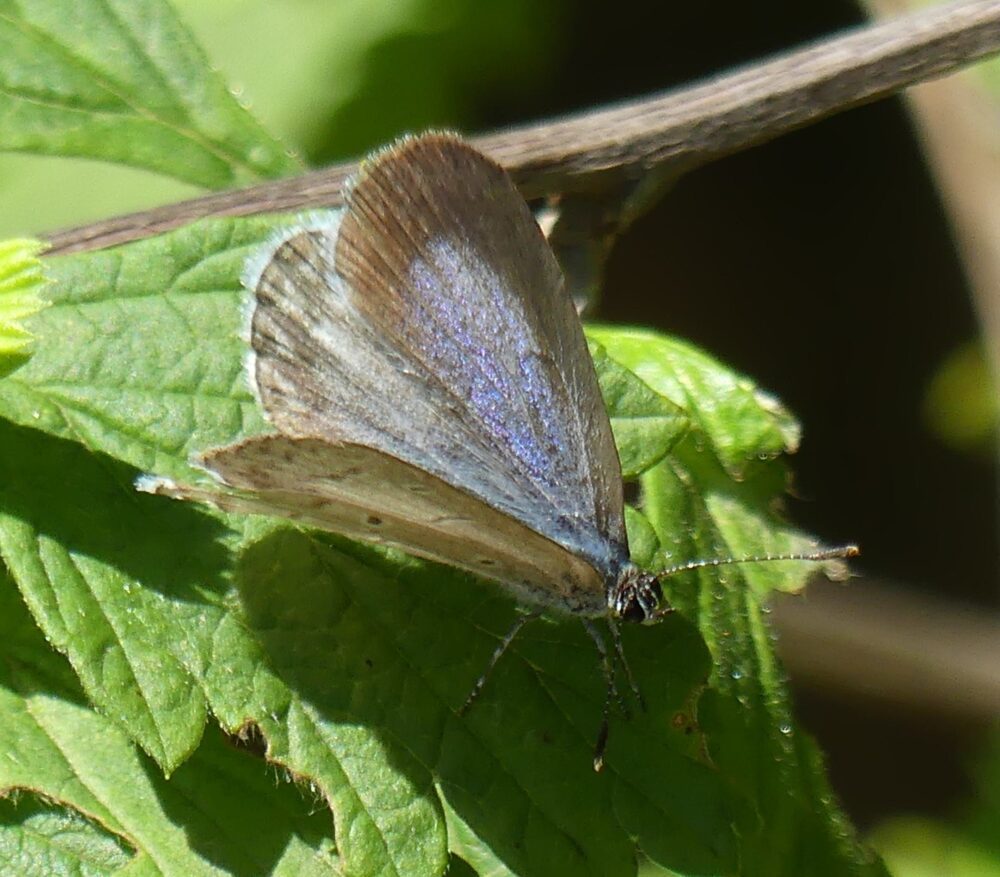
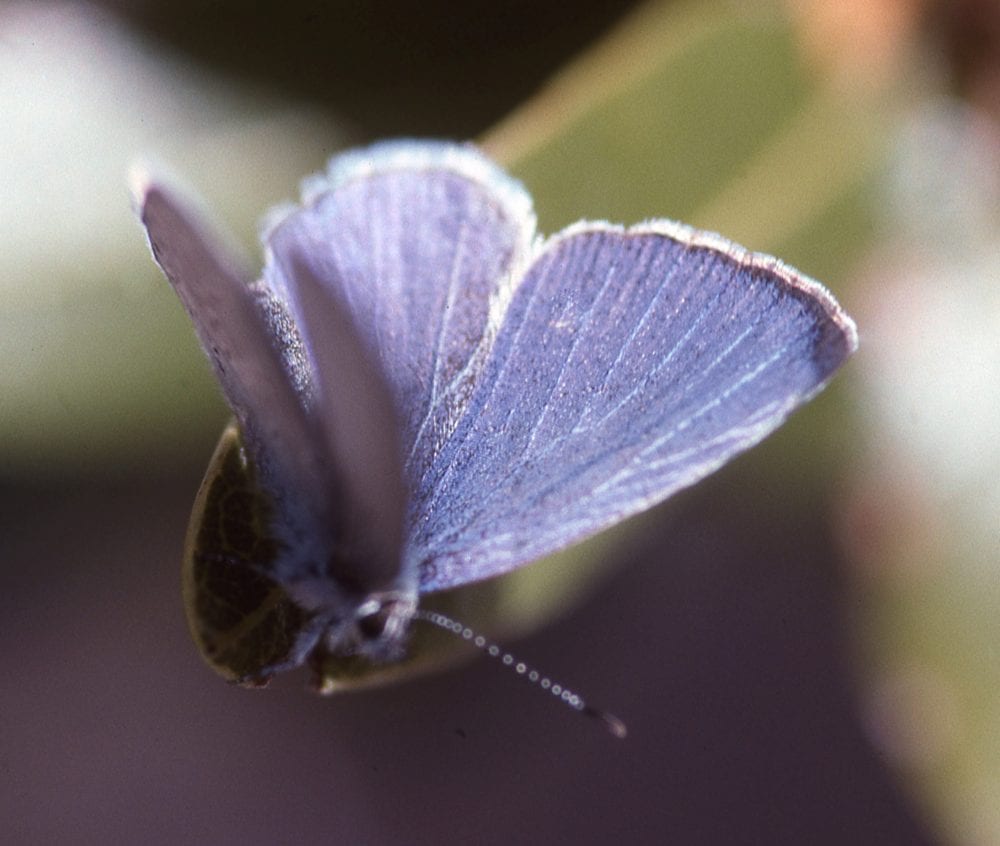

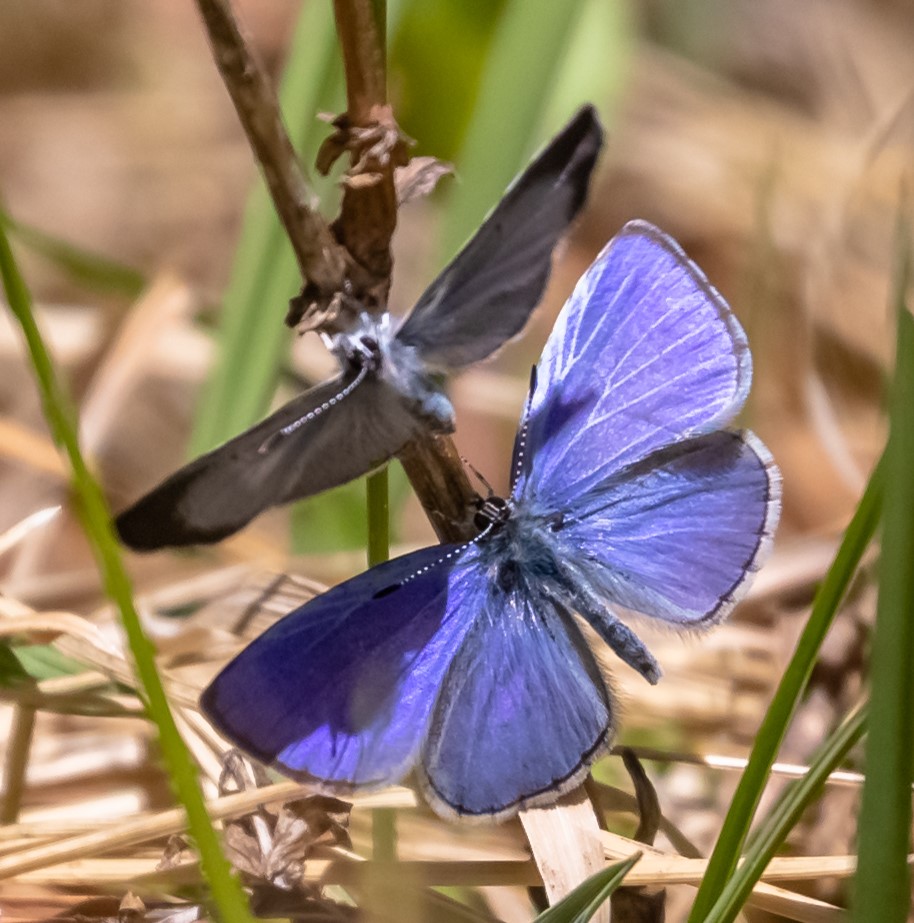
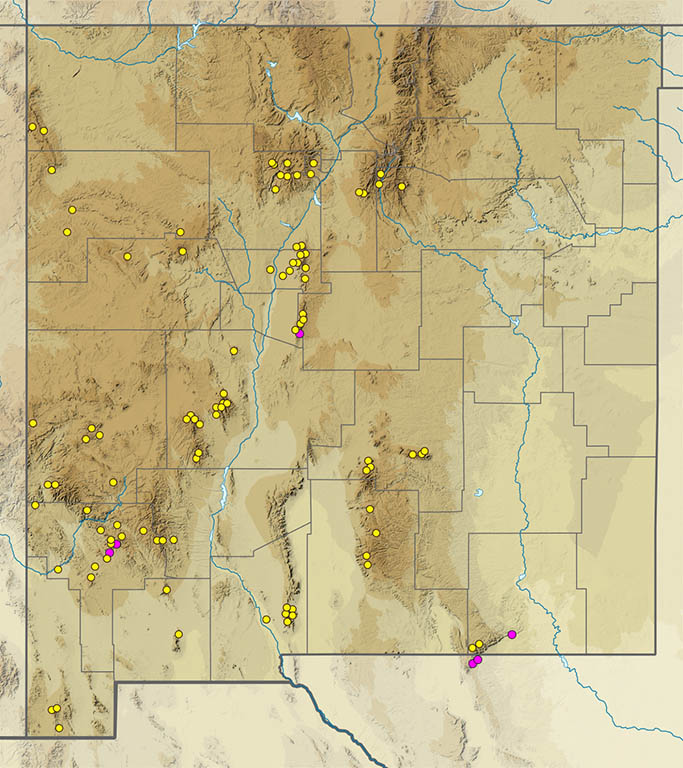
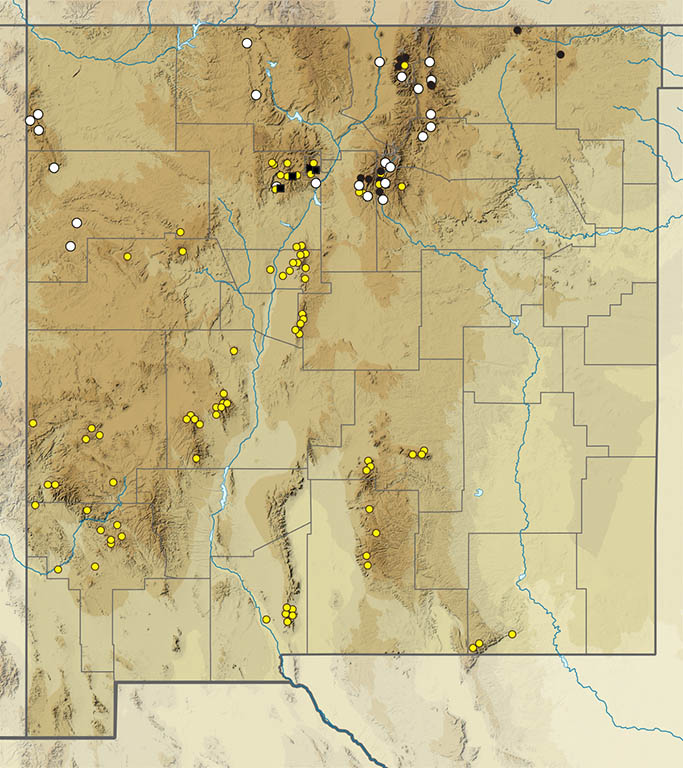
Celastrina lucia (W. Kirby 1837) Northern Azure (updated January 6, 2024)
Maybe we present as Celastrina . . . lumarco (leave the species out of it for now) given unknown relationships with lucia and sidara?
Description. Northern Azures, like their Mexican Azure cousins, are iridescent light blue above. The black FW margin is thin on males, but larger on females, though not as wide as on Echo Azure females. Fringe is white with dark checks at vein ends, darker than on Echo. Toward the dorsal FW apex, the marginal black bleeds into the white margin (less so on ‘Gray’ Echo Azure). Ventrally, ground color is gray, not white as in Echo, and spots are considerably darker, bolder than on faintly marked Echo Azure (Celastrina echo). Range and Habitat. Northern Azures live across northern reaches of North America, thence south through the Rocky Mountains as far as northern New Mexico (counties: Co,LA,Mo,RA,Sv,SJ,SF,Ta). They live in montane plant communities with a rich deciduous shrub component. Life History. Largely per Scott (March 2022:339-341), larval hostplants in Colorado include the following deciduous shrubs: Jamesia americana (Hydrangeaceae), Holodiscus dumosus (Rosaceae), Prunus virginiana var. melanocarpa (Rosaceae), Physocarpus monogynus (Rosaceae); Cornus (Swida) sericea (Cornaceae), Ceanothus fendleri (Rhamnaceae) and Humulus lupulus var. neomexicanus (Cannabaceae). S. Cary witnessed oviposition on Holodiscus dumosus (Rosaceae) in the Sangre de Cristo Mountains (SF). Flight. Northern Azure is single brooded with flight concentrated in spring to early summer (April – June). Infrequent late summer emergences do occur. Adults readily visit flowers, mud, scat, etc. Comment 1. West of the Rio Grande (counties: LA,MK,RA,Sv,SJ) we have ssp. Celastrina lucia lumarco J. Scott 2006, whose VHW exhibits a high frequency (up to 50%) of variants with coalesced submarginal dark spots (= form marginata) or dark irregular median blotches (= form lucia). East of the Rio Grande in northern NM (counties: Co,Mo,RA,SM,SF,Ta), Celastrina lucia has distinct ventral black marks that are (with rare exceptions) unbanded, unfused, unblotched; this is subspecies C. l. sidara (Clench 1944). Comment 2. Different authorities seem to disagree as to whether sidara belongs with C. lucia, C. echo or something else. Comment 3. The Hops Azure (Celastrina humulus J. Scott & D. Wright 1998) was also described from CO; NM specimens associated with hops (Humulus) should be closely examined to see if any are Hops Azures. Comment 4. Standard field and laboratory techniques for distinguishing similar species all seem to fail for many Celastrina blues. Even geneticists have not yet broken the code, if there is one. Some Celastrina “species” or “races” may be defined by their larval host choices rather than their DNA. Please stay tuned for future developments.
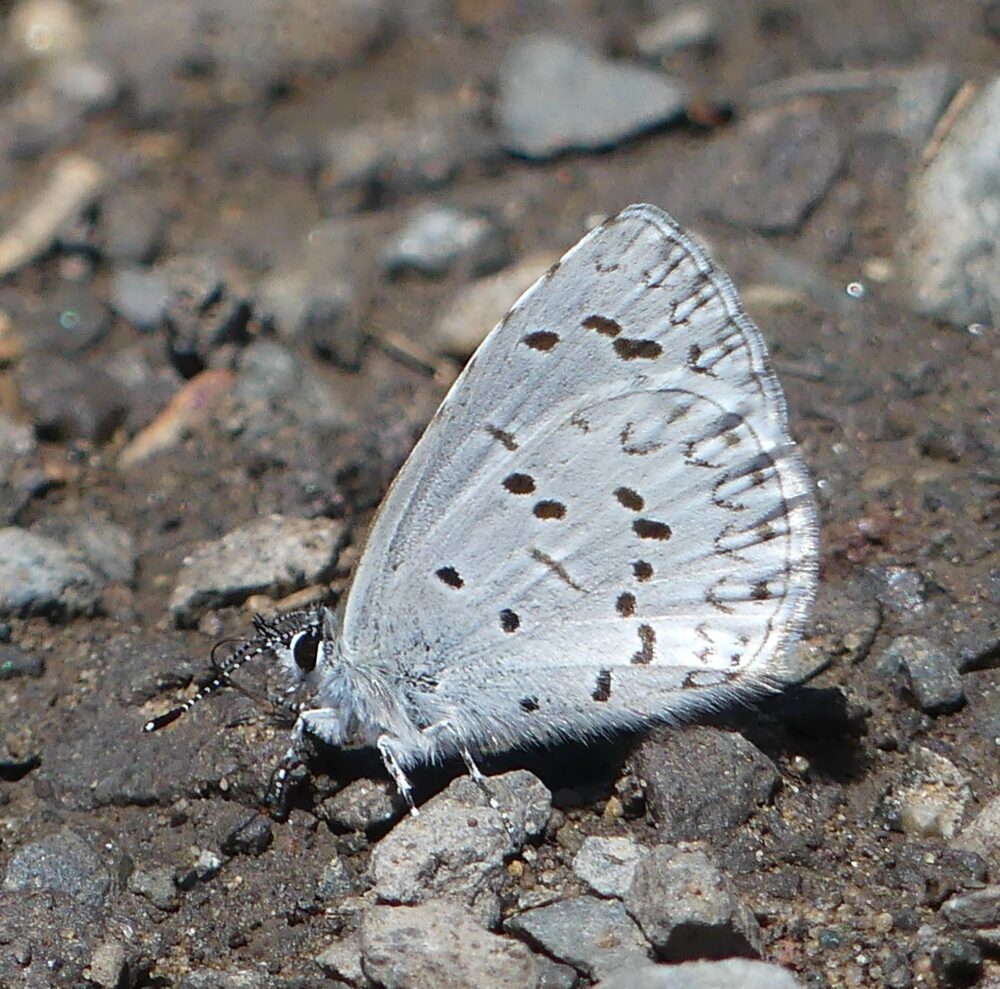
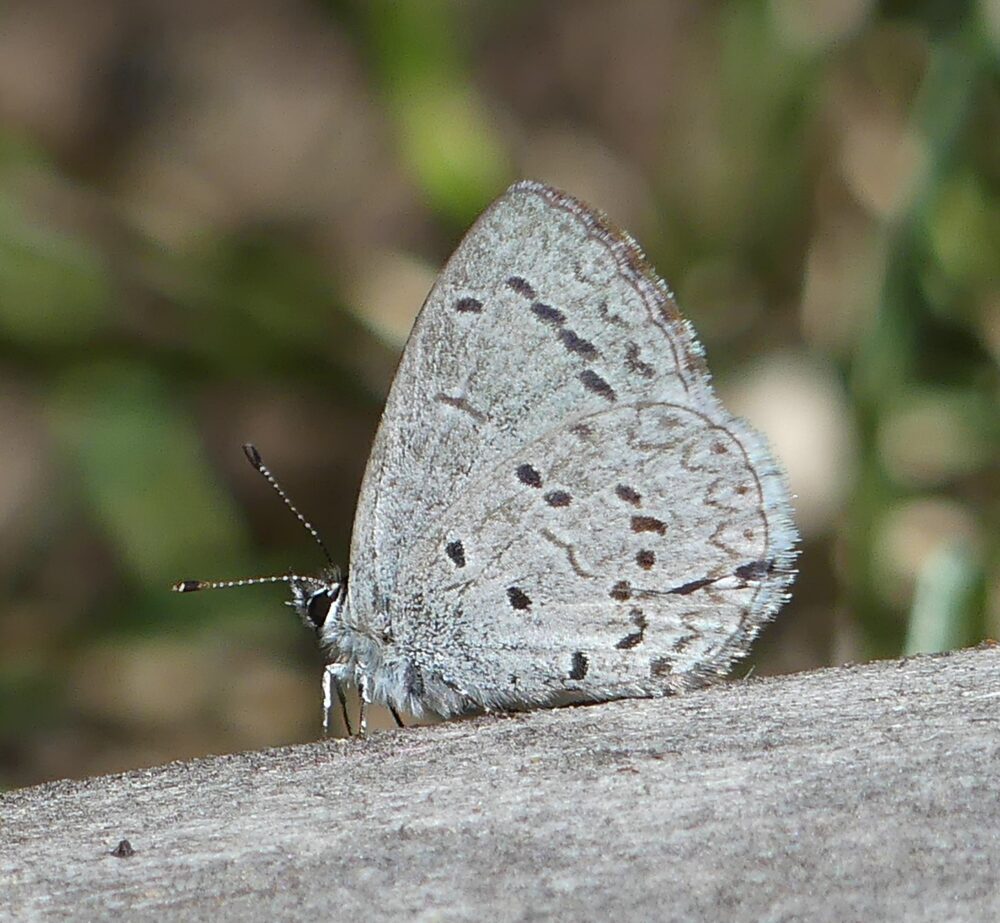
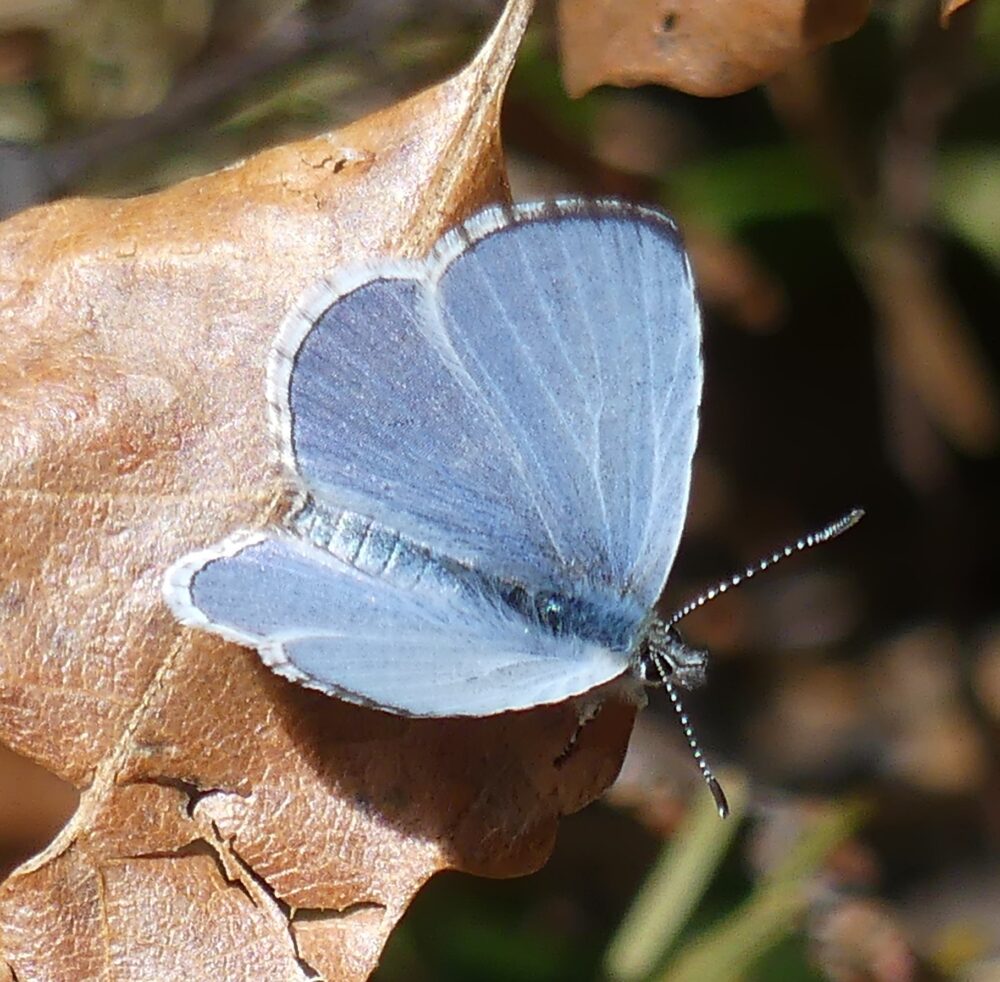
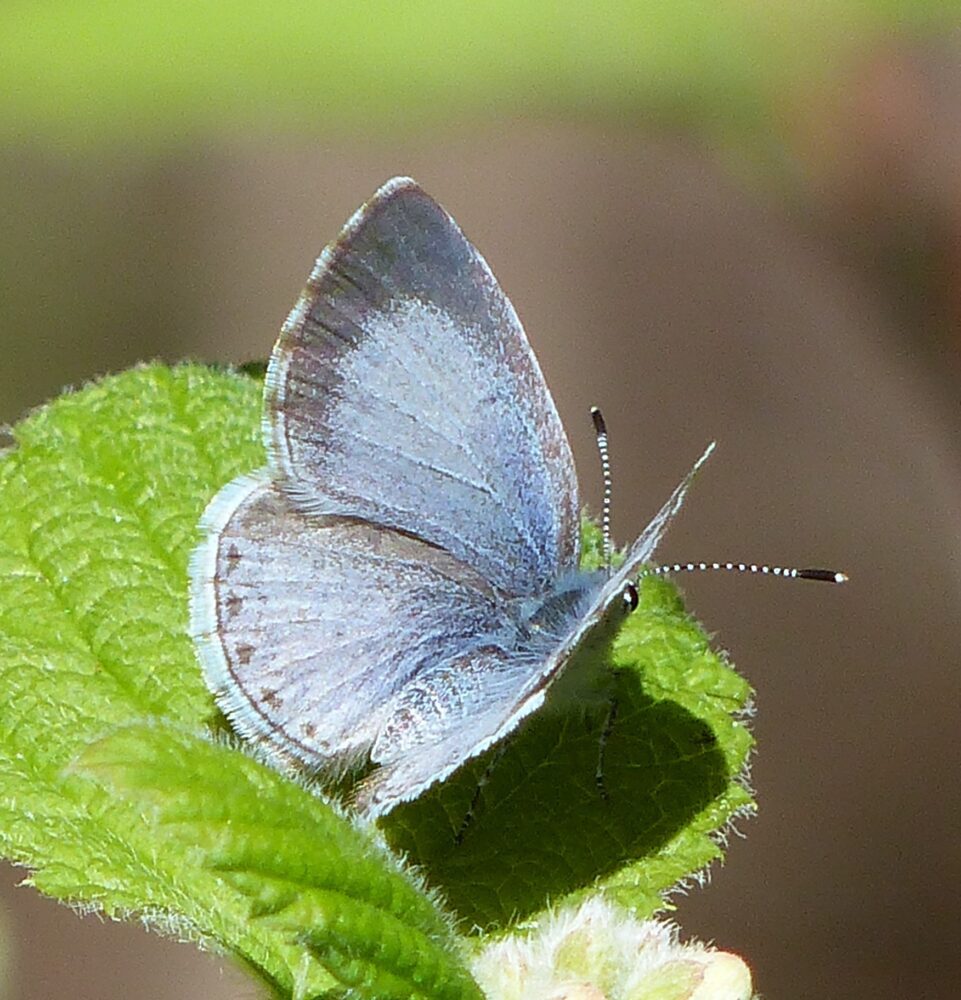
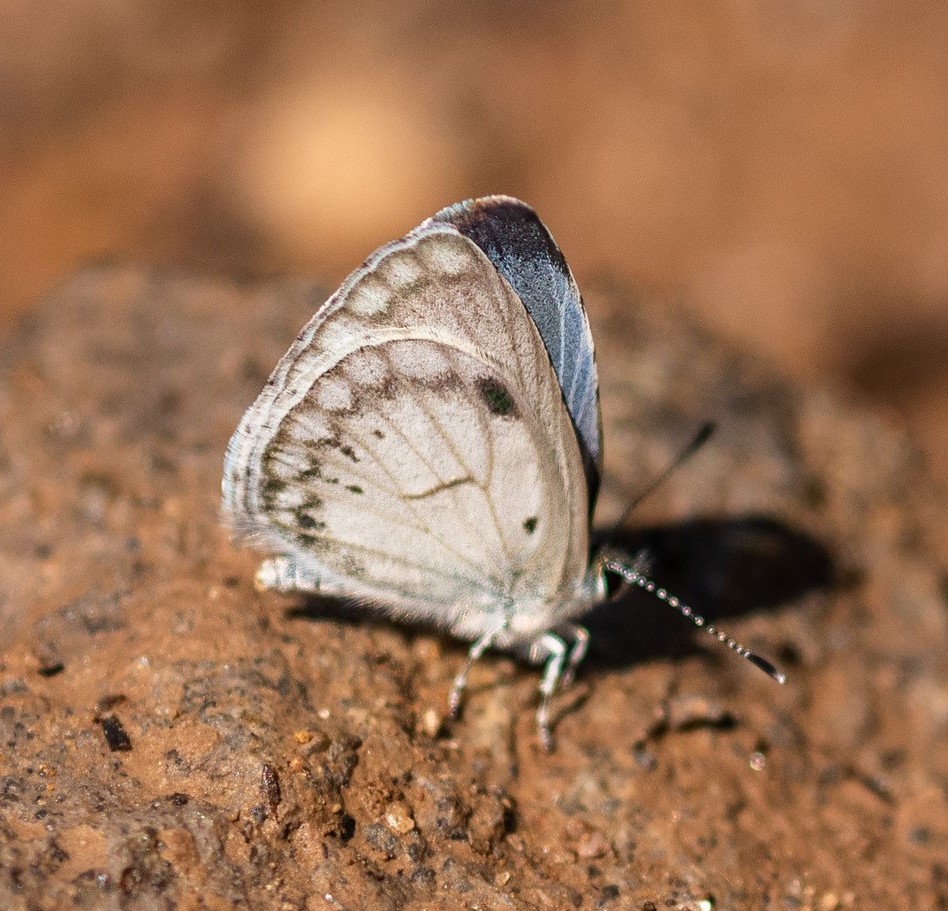
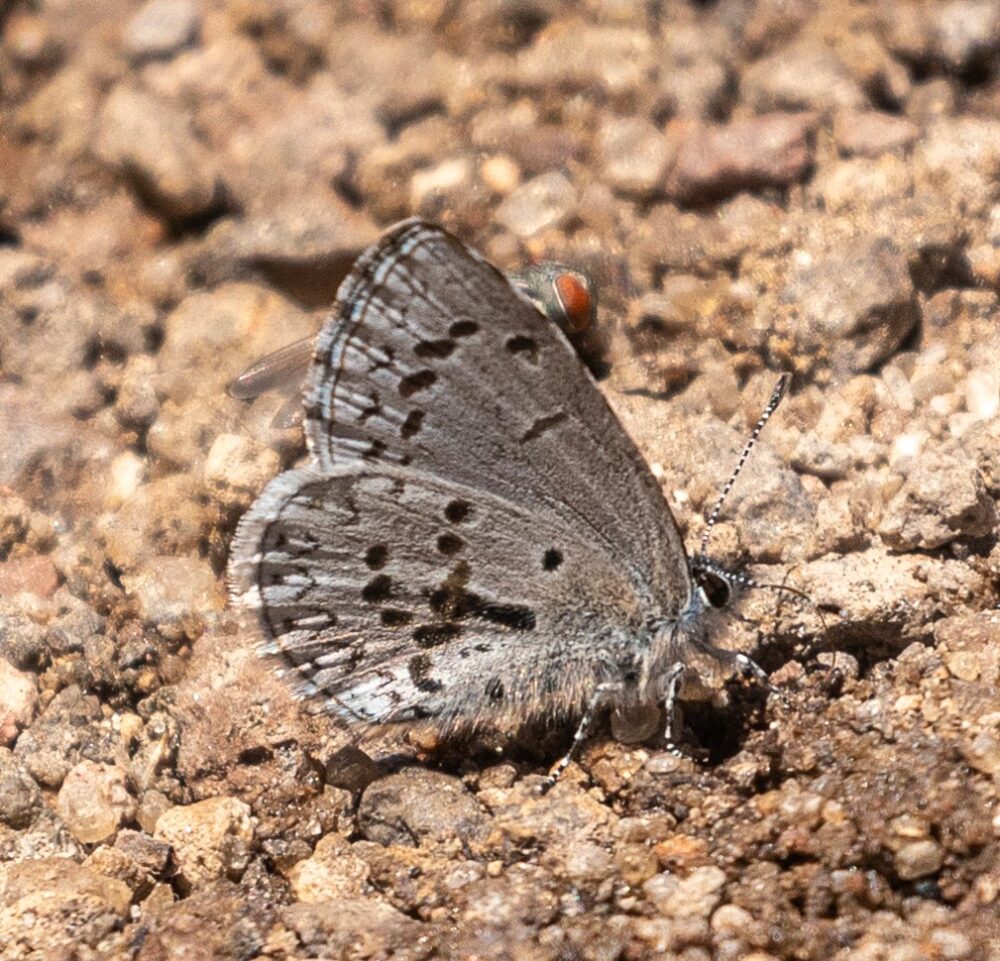
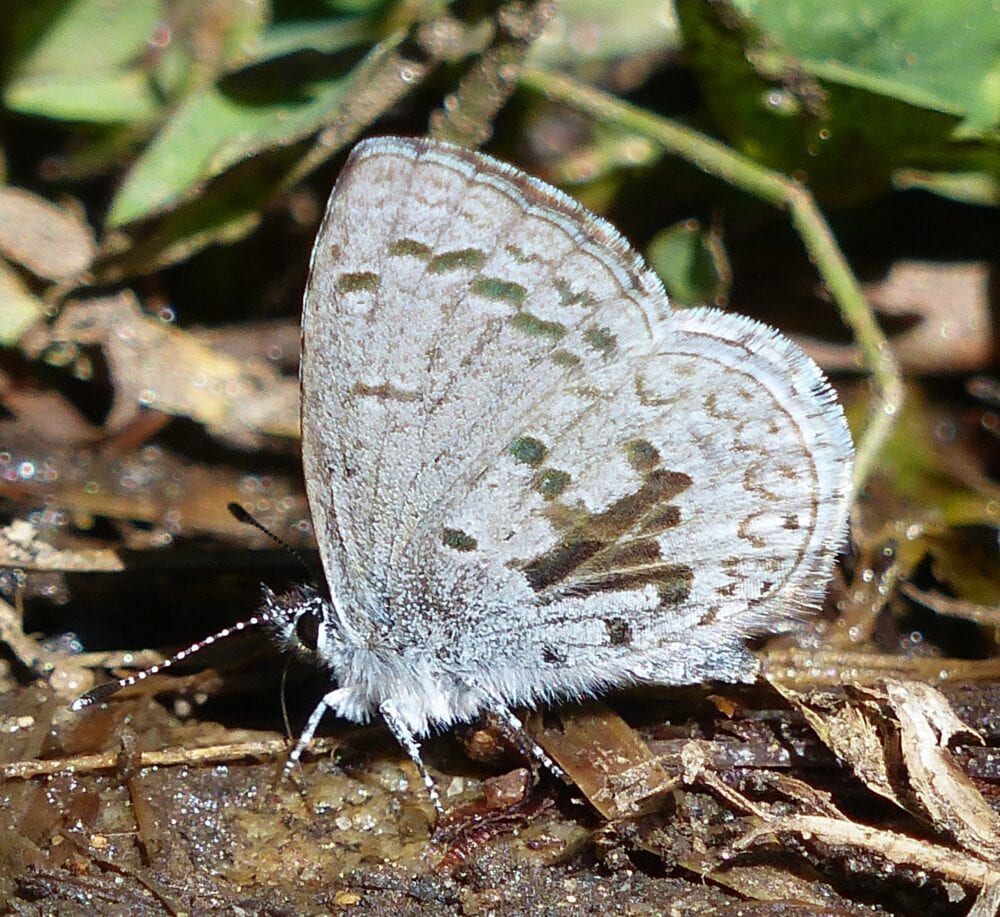
Celastrina neglecta (W. H. Edwards, 1862) Summer Azure (updated March 12, 2024)
Description. Perhaps the palest, whitest of azures found in New Mexico. The underside seems severely bleached, leaving a bare scatter of black marks, sometimes lacking the marginal chevrons entirely. Even the veins seem dark. Dorsally, fresh males are iridescent blue with heavy black checks in the white FW margin and with silver/white overscaling on the hindwing. Females have forewings that are bluish but with broad dark postmedian band. Hindwings above are dusty whitish between dark veins. Range and Habitat. Summer Azure is an insect of eastern North America whose range, like that of its larval host, reaches westward across the Great Plains, petering out in the shortgrass prairies. Strays, mostly females, occasionally wander upstream (westward) into eastern WY, western NE, eastern CO and northeastern NM. Life History. Eggs are placed on Amphicarpaea bracteata (Fabaceae) and Spiraea latifolia (Rosaceae), neither of which are native to New Mexico. Flight. Summer Azures are double-brooded back East, with spring and summer flights. To date, only the summer generation has produced wanderers to Colorado and New Mexico. Comments. One worn female collected by Richard Holland at Clayton Lake State Park, Union County, NM, was identified as this species by Andy Warren in his examination of NM Celastrina at Gillette Museum, CSU, in March 2024. This is the only known observation of this bug in NM, but it demonstrates that Summer Azure is an occasional vagrant to northeastern NM. Andy warren says 1990 and 1993 were particularly good summers for Summer Azure in the Colorado Front Range.
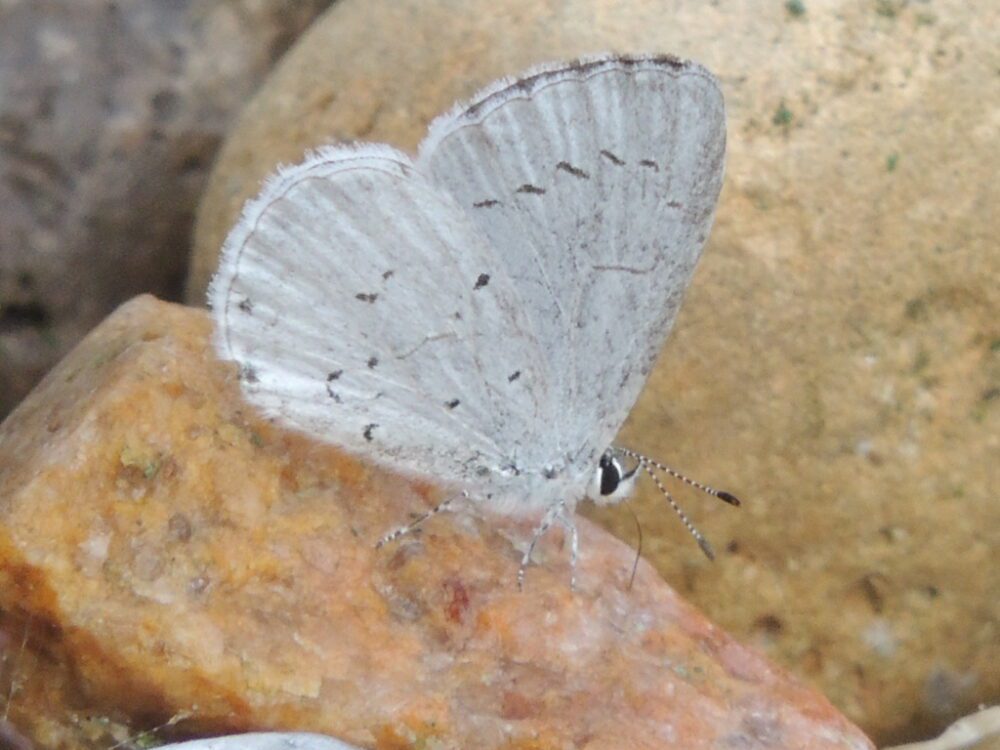
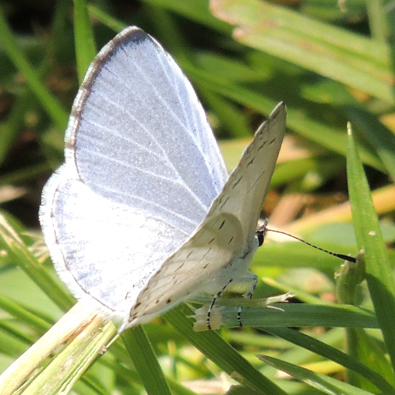
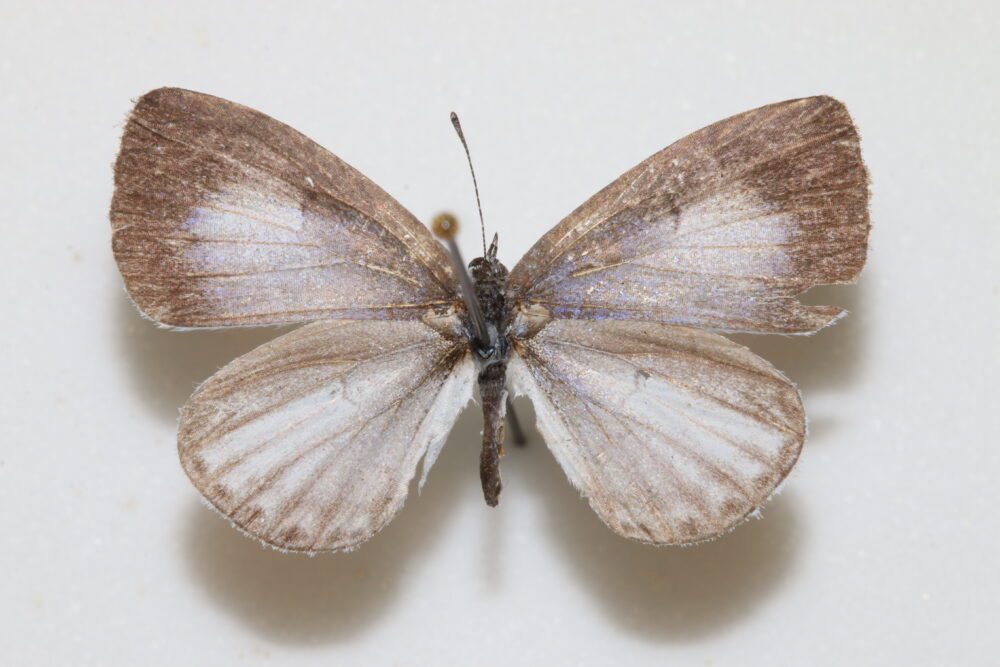
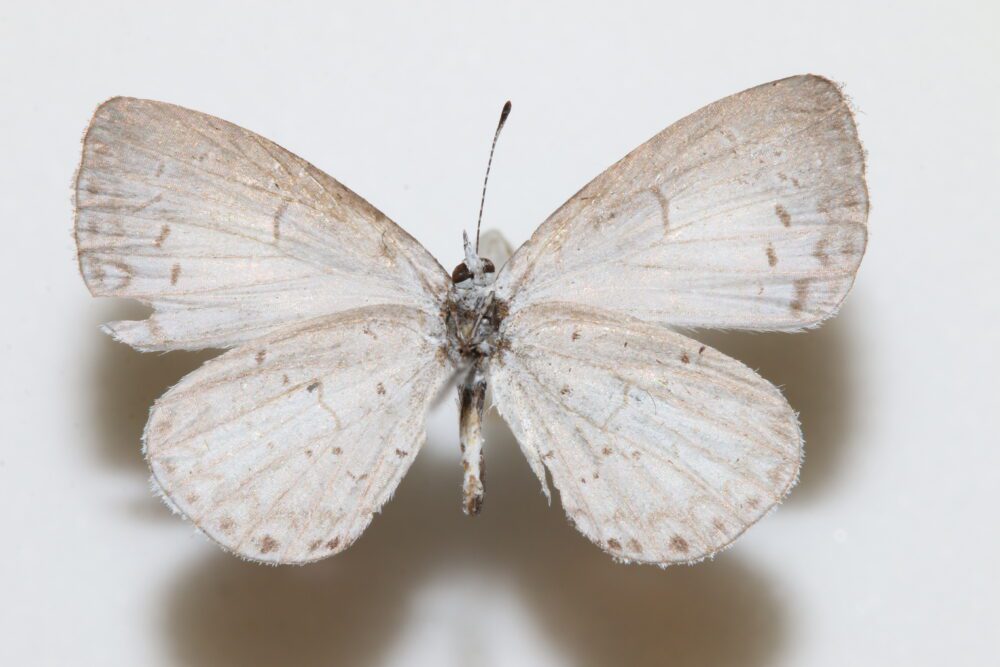
Tailed-Blues. The two species of Tailed-blues in North America are currently assigned to the genus Cupido Schrank and subgenus Everes Hübner. Eastern (Cupido comyntas) and Western Tailed-blues (Cupido amyntula) look alike. Phenotypic characters exhibit sufficient variability within each species, and overlap between the two species, such that photographs alone may not be determinable to species. Ferris and Brown (1981) indicated that microscopic examination of genitalia may be the only sure way to tell one from the other. More recently, Glassberg (2017) echoed that there is no sure way to separate Eastern and Western in the field. Those challenges are irrelevant in vast areas where only one or the other exists. In the American Southwest, however, we are fortunate to have both and so we make our best effort to determine which is which. Key characters to look for include: (1) width of the black margin on dorsal forewings of males; (2) extent of basal blue scaling on dorsum of females; (3) development of orange spots/lunules, dorsal and ventral, near the hindwing tail; (4) orientation of line connecting two uppermost black postmedian spots (Bailowitz & Brock 2022); and (5) straight vs. rounded forewing apex and edge. (6) Higher elevation sites above 8000′ elevation generally produce Westerns while Easterns seem largely limited to sites below 6000′.
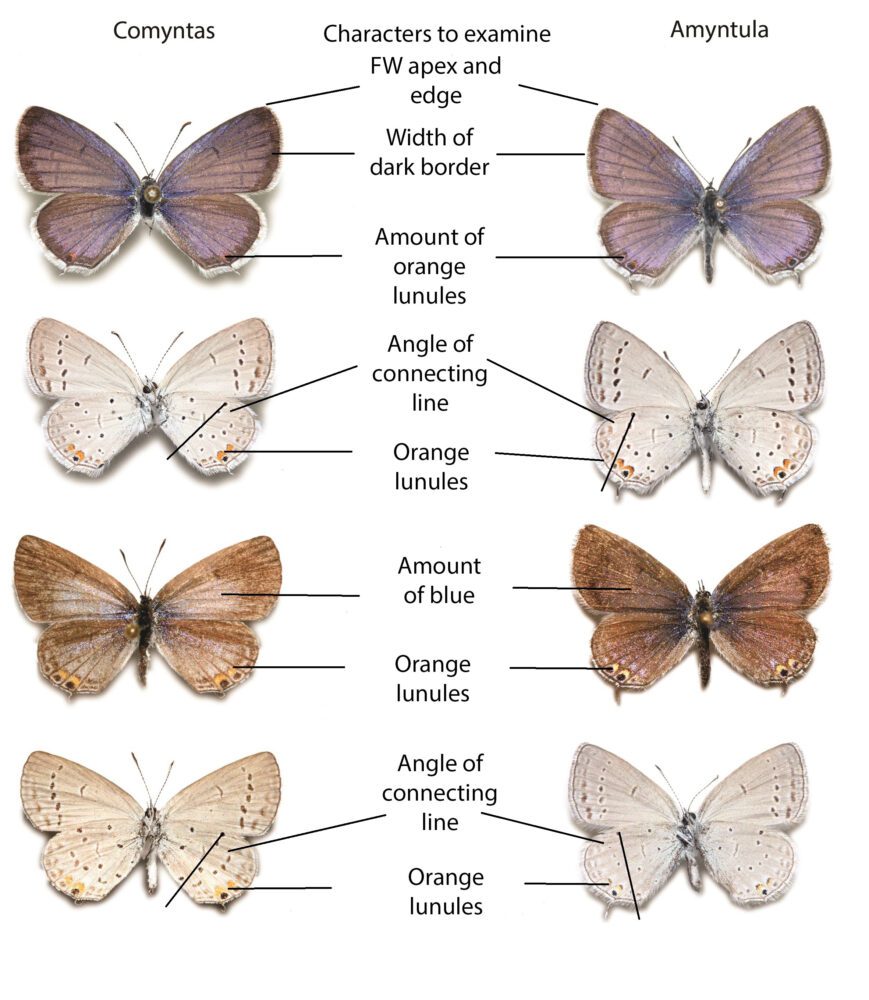
Cupido comyntas (Godart [1824]) Eastern Tailed-blue (updated January 9, 2024)
Description. Eastern Tailed-blues usually have well-developed orange spots or lunules near the HW tail, on males and females, dorsally and ventrally. Dorsally, male Eastern Tailed-blue is blue with a broader (>2mm) black margin on the forewing compared to Western. Females are gray-brown with blue over-scaling covering the inner half of the wings, with more blue in spring than in subsequent broods. Range and Habitat. Eastern Tailed-Blue is a meadow and field denizen in the eastern US. Colonies also occur farther west in the Sierra Nevada, northern Mexico, and from southern Arizona to west Texas. In New Mexico (counties: Ca,DA,Ed,Gr,Hi) it likes moist areas below 6000′. Life History. Legumes (Fabaceae) are hosts for larvae; clovers (Trifolium spp.) may be preferred. Specific New Mexico hosts have not yet been elucidated. Flight. Cupido comyntas completes two or more broods annually in southwest New Mexico. In Animas Valley cienegas (Hi), adults fly continuously between March 5 and October 24. Adults fly near the ground, gather nectar and sip moisture. Comments. Knowledge of this species in New Mexico may be masked by its similarity to the more widespread Western Tailed-blue. Recent reports from northern New Mexico (counties: MK,Ci,Ta,SM) challenge traditional views of Eastern Tailed-blue in New Mexico. They may represent misidentifications or, if correctly identified, may have originated as accidental introductions in alfalfa hay imported from other states. For example, during the American frontier period when places like Fort Wingate (Cibola County), Fort Stanton (Lincoln County, and Las Vegas (San Miguel County) may have received much livestock feed shipped in from eastern sources.
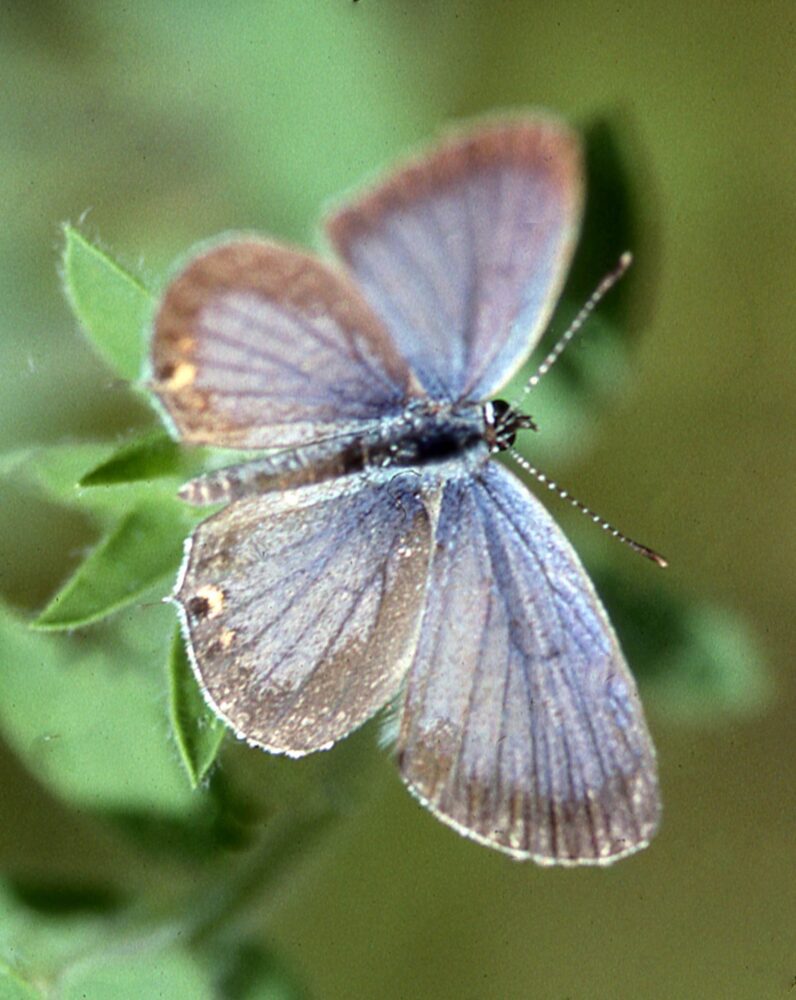
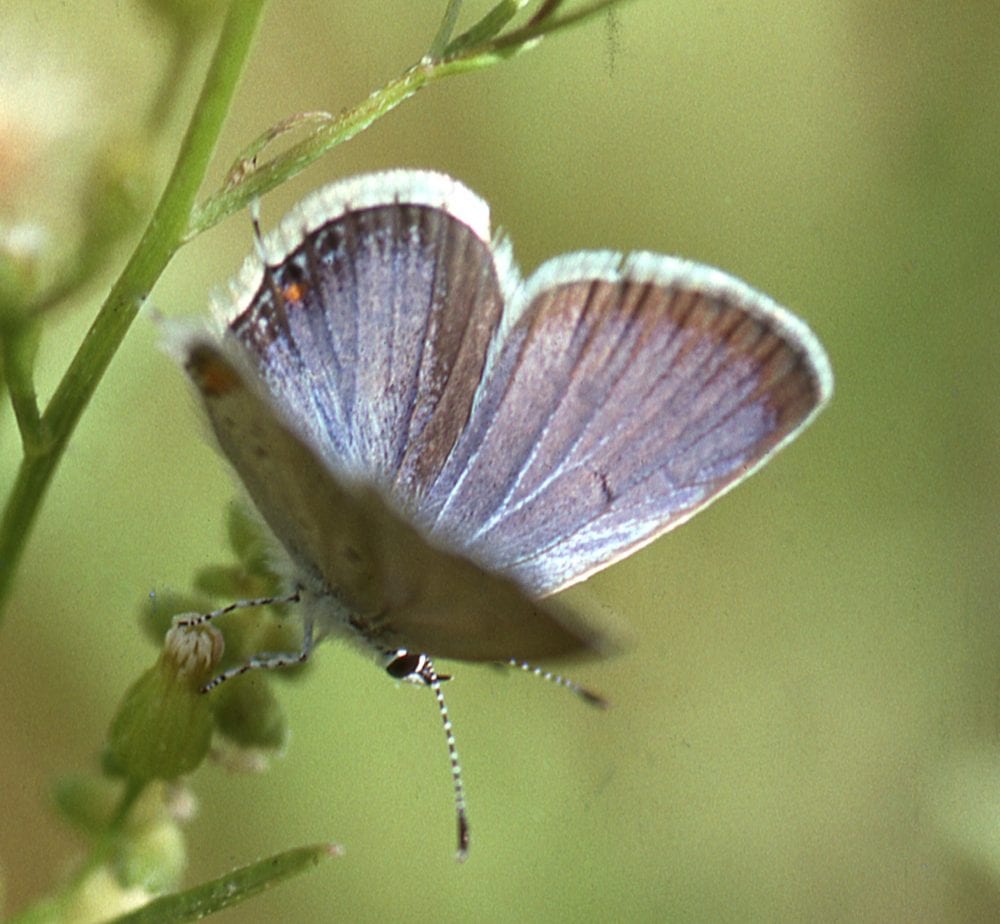
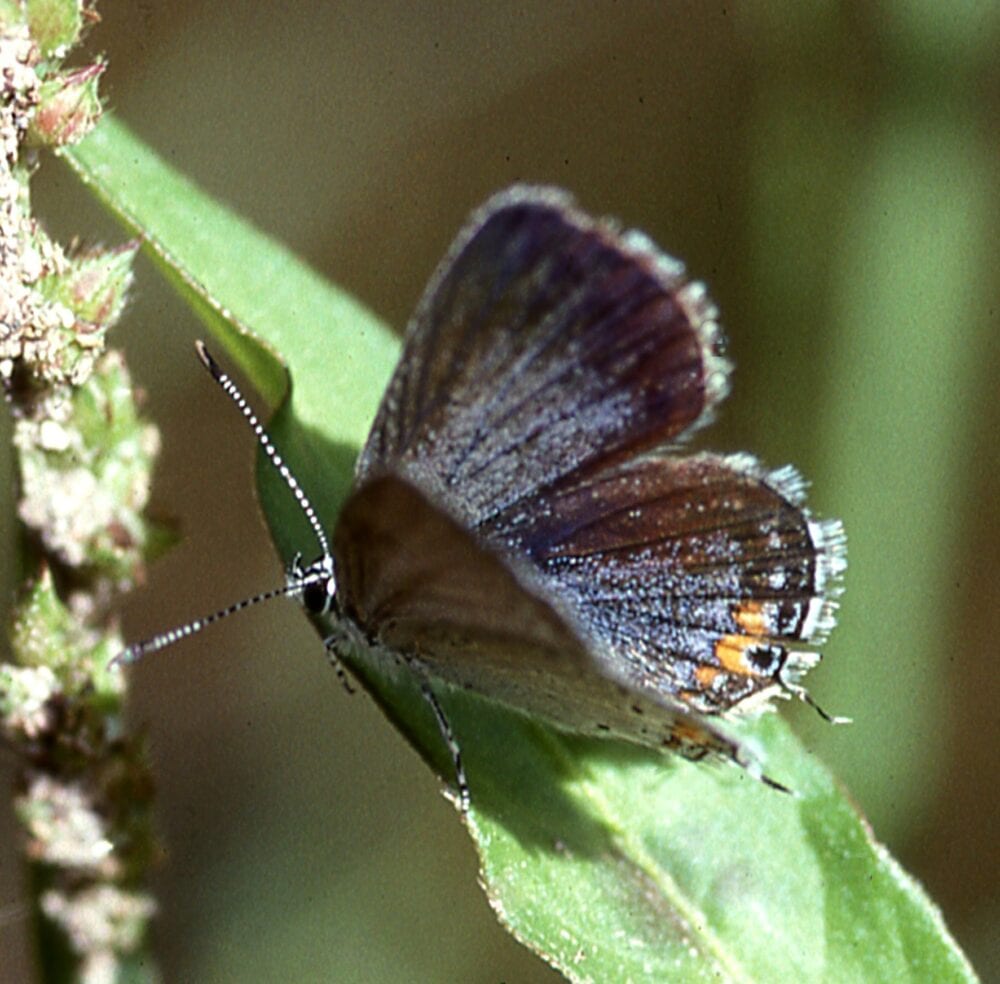
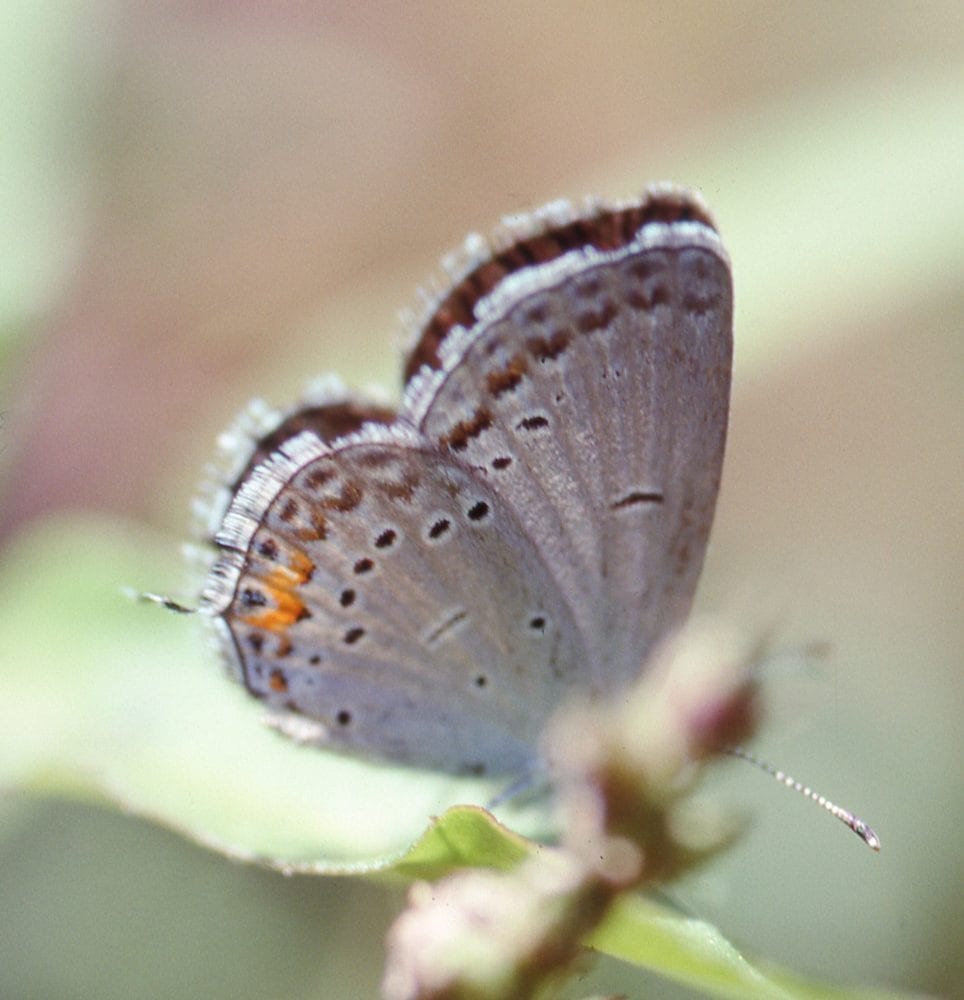
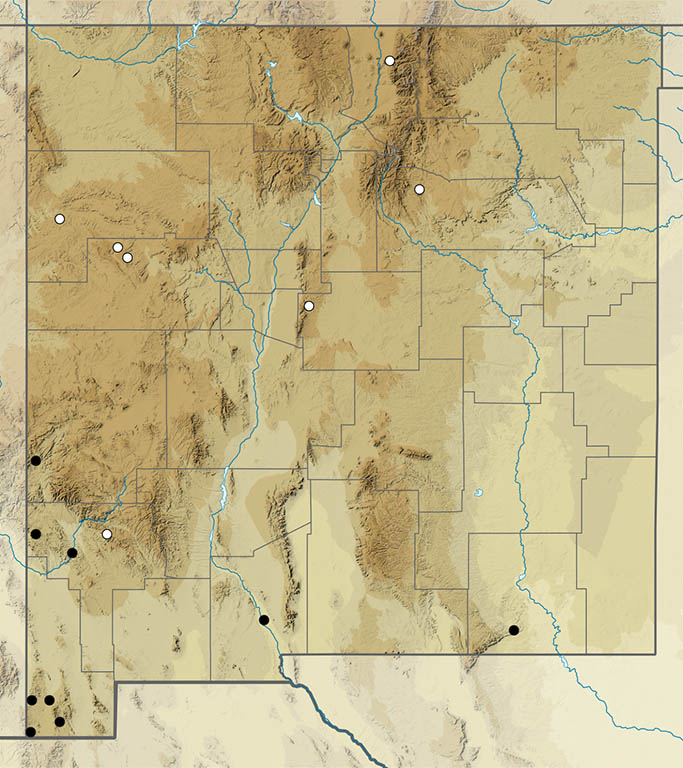
Cupido amyntula (Boisduval 1852) Western Tailed-Blue (updated September 3, 2023)
Description. Cupido amyntula males are bright blue above with a narrow (~1mm) black margin. Males have hindwing tails and associated black dots with a range of orange caps or lunules: no orange lunules, one small orange lunule, or one full plus one small orange lunule. Females are dark grey above with basal blue overscaling of variable extent and some orange near the tail. Underside tail toppers for both sexes usually include two orange hats, one full and one reduced. Cupido amyntula usually has a straighter FW outer edge than Cupido comyntas. Range and Habitat. Western Tailed-Blues live from Alaska to the Great Lakes, south to California, Arizona and New Mexico, where they occupy montane woodlands and savannas (counties: Be,Ca,Ci,Co,DA,Gr,Hi,Li,LA,Lu,MK,Mo,Ot,RA,Sv,SJ,SM,SF,Si,So,Ta,To,Un,Va), 6500’to 9000′. Life History. Larvae eat legumes (Fabaceae) such as Astragalus flexuosus, Lathyrus spp., and Vicia americana. Larvae overwinter. Flight. Cupido amyntula is univoltine in north-central New Mexico, peaking in June. It completes two generations in our southern mountains, spanning April 19 to September 30, peaking in May and August. Comments. New Mexico Western Tailed-blues fall on the phenotypic spectrum between northern Rocky Mountain subspecies Cupido amyntula albrighti (Clench 1944) and southeastern Arizona subspecies C. a. herrii (F. Grinnell 1901). Aberration jemezensis Gunder was described from Jemez Springs (Sv) in 1927. Given the uncertainty of identifications of this species and C. comyntas, we have included all reports of C. amyntula on our map, with the caveat that some of these records are tentative. The only way to firmly establish the distribution limits or boundaries of this species and C. comyntas in New Mexico will be to examine genitalia from specimens from many localities in the state. Meanwhile, the elevation criterion is expected to work for field identification in more than 90 per cent of situations.
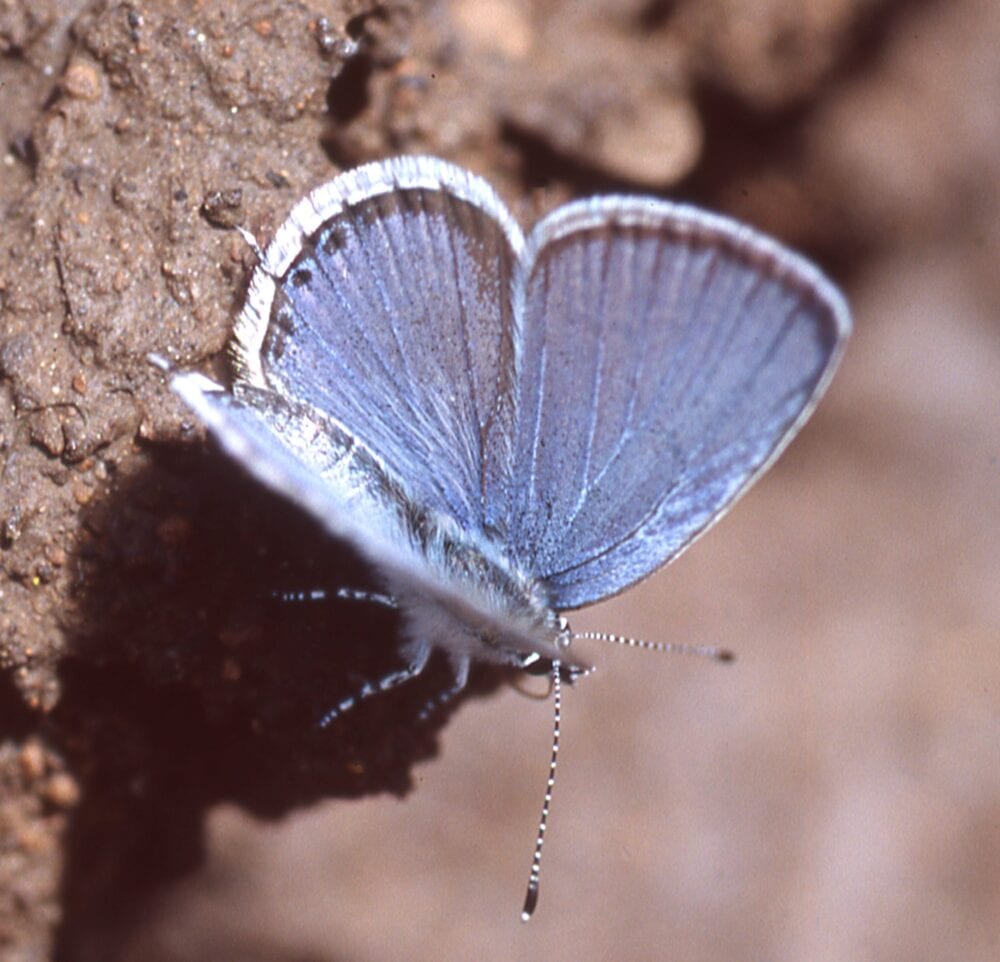
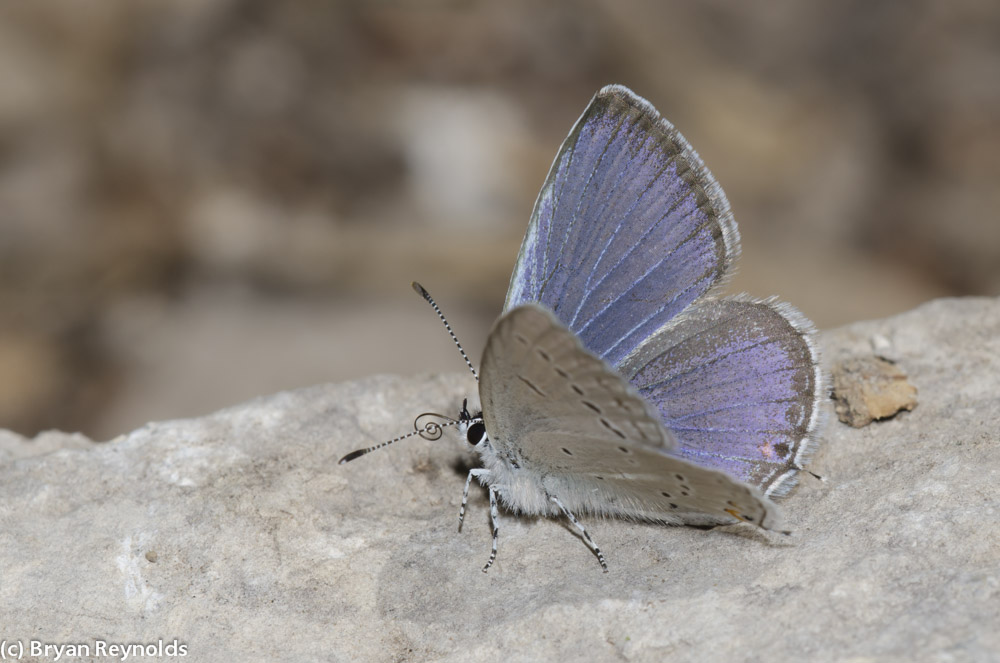
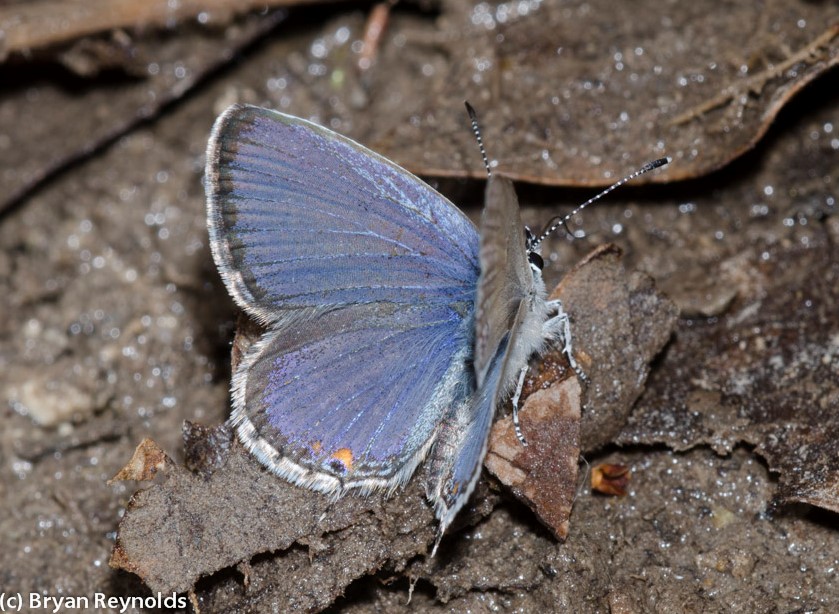
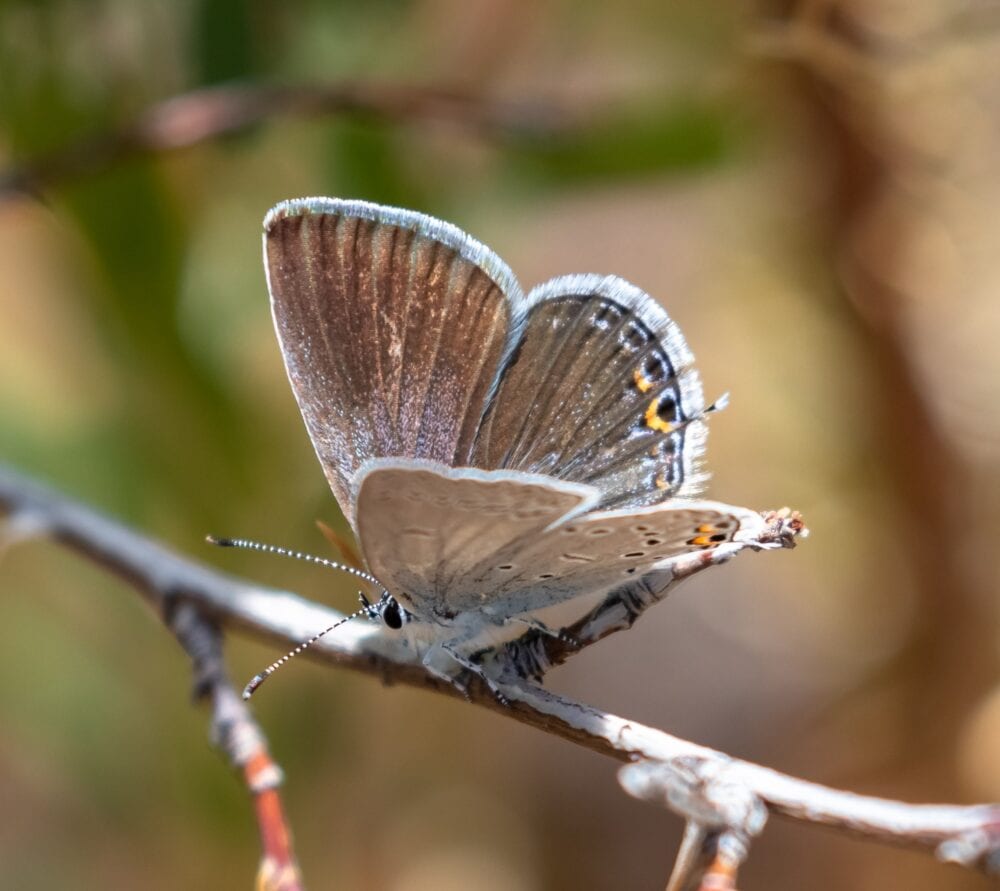
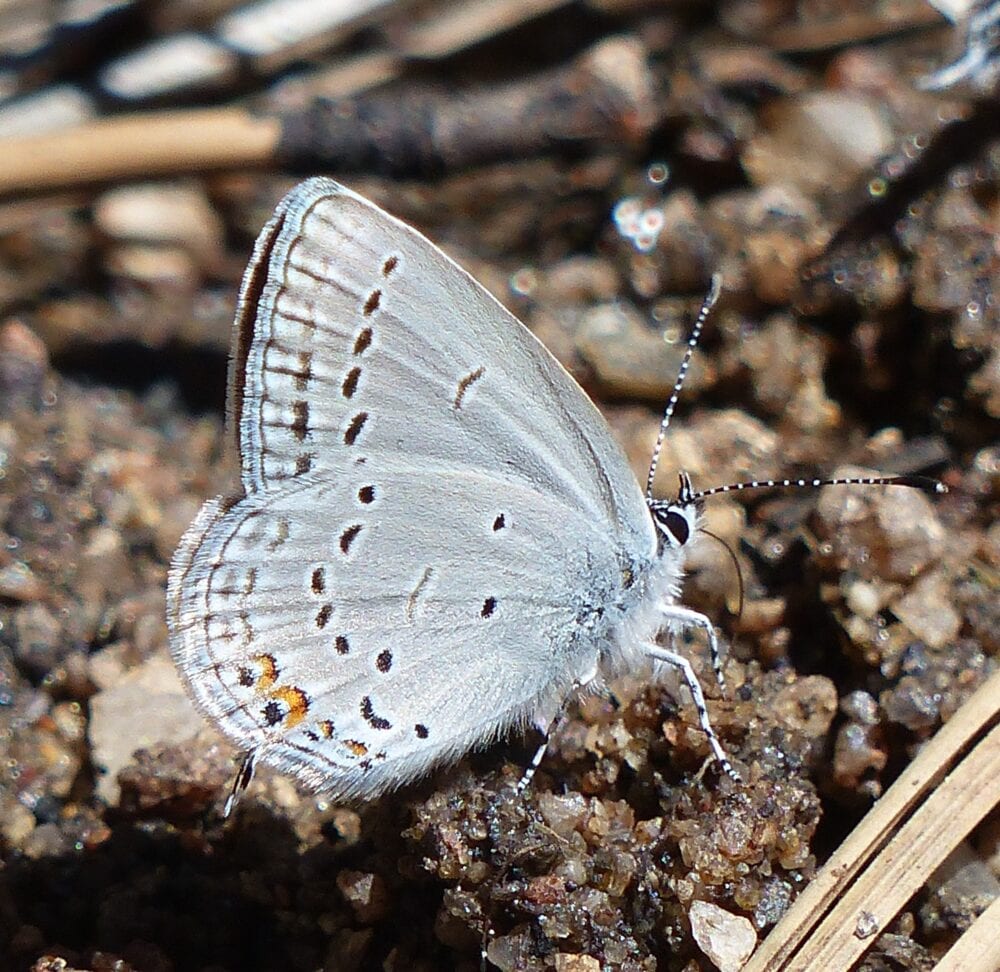
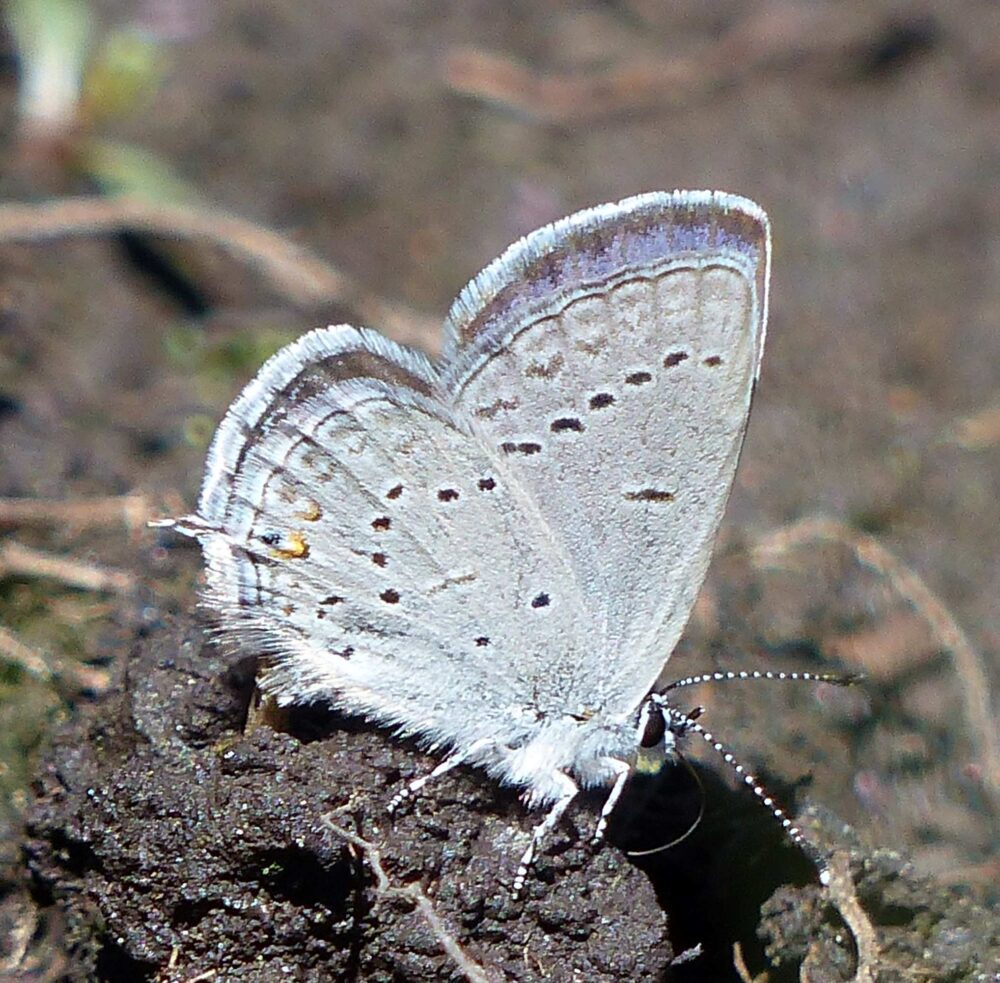

Hemiargus ceraunus (Fabricius 1793) Ceraunus Blue (updated July 5, 2022)
Description. Ceraunus is gray or tan below with slightly darker bands on the forewing beneath but lacking the prominent row of dark spots sported by Reakirt’s Blue. The hindwing underside has dark ocelli near the tornus, with white and light brown marks elsewhere. Above, males are iridescent light blue, while females are brown with basal blue iridescence. Range and Habitat. This tropical butterfly breeds along Atlantic and Pacific coasts of Mexico and Central America, then north as far as south Florida. Vagrants and strays regularly invade the southwestern US, including New Mexico (counties: Be,Ca,Ch,Cu,DB,DA,Ed,Gr,Gu,Ha,Hi,Li,LA,Lu,MK,Ot,Ro,Sv,SM,SF,Si,So,To,Va). It establishes seasonal breeding colonies in southern New Mexico, but they do not survive our winters. Less common and less widespread than the similar Reakirt’s Blue, which is a breeding resident statewide, Ceraunus is reported most often from under 7,000′ elevation. Life History. Larvae feed on a variety of legumes (Fabaceae), such as Medicago, Cassia, Lotus and Prosopis. Seasonal reproduction is likely in southern New Mexico. Flight. Ceraunus adults are recorded from May 13 to October 31, peaking in July to September. They go to nectar and moist earth. Comments. Our populations are subspecies Hemiargus ceraunus gyas (W. H. Edwards 1871).
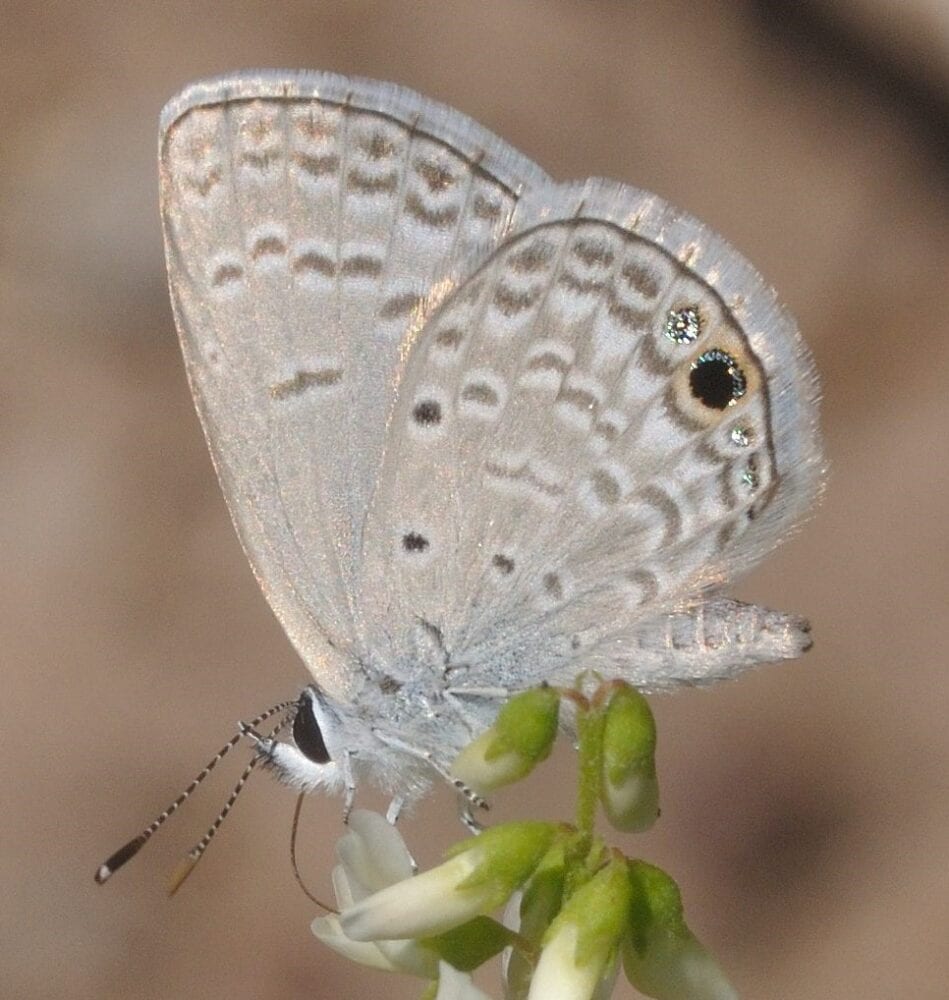
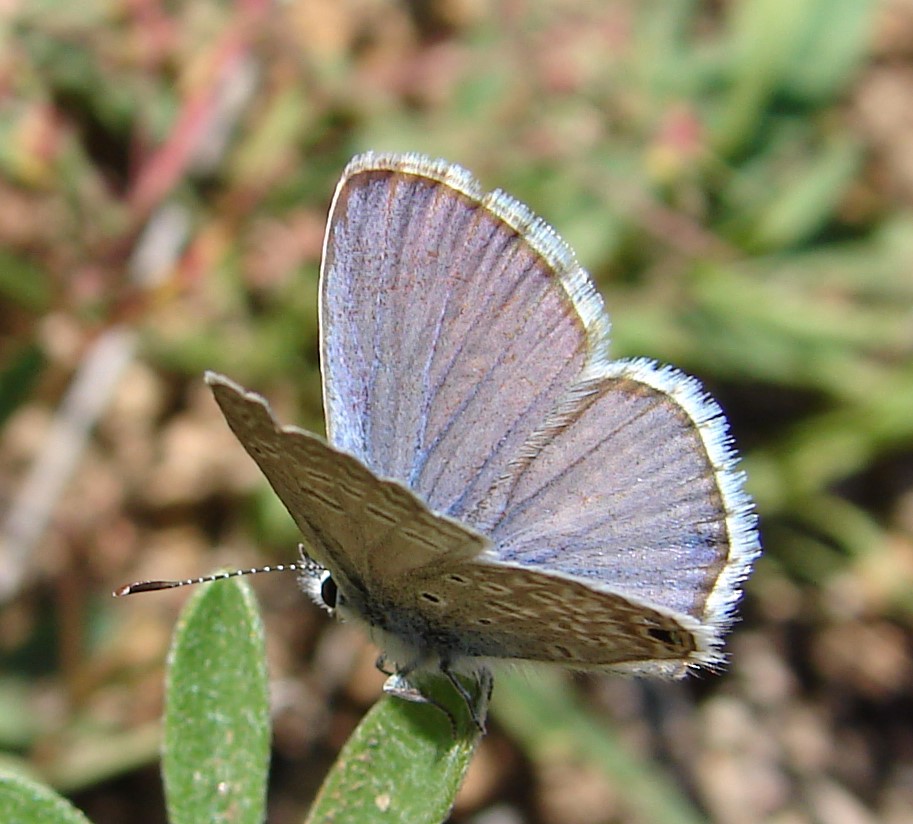
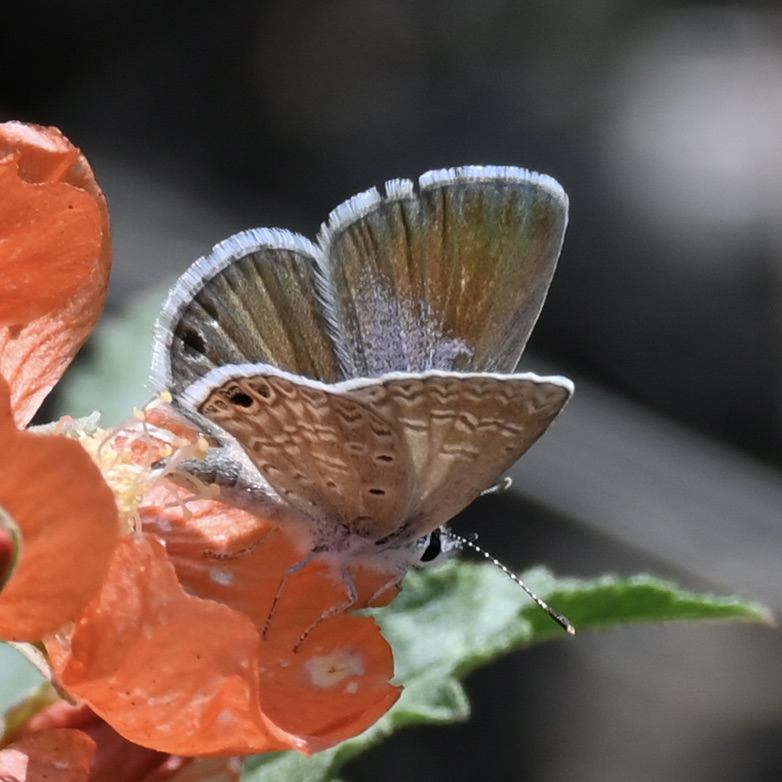
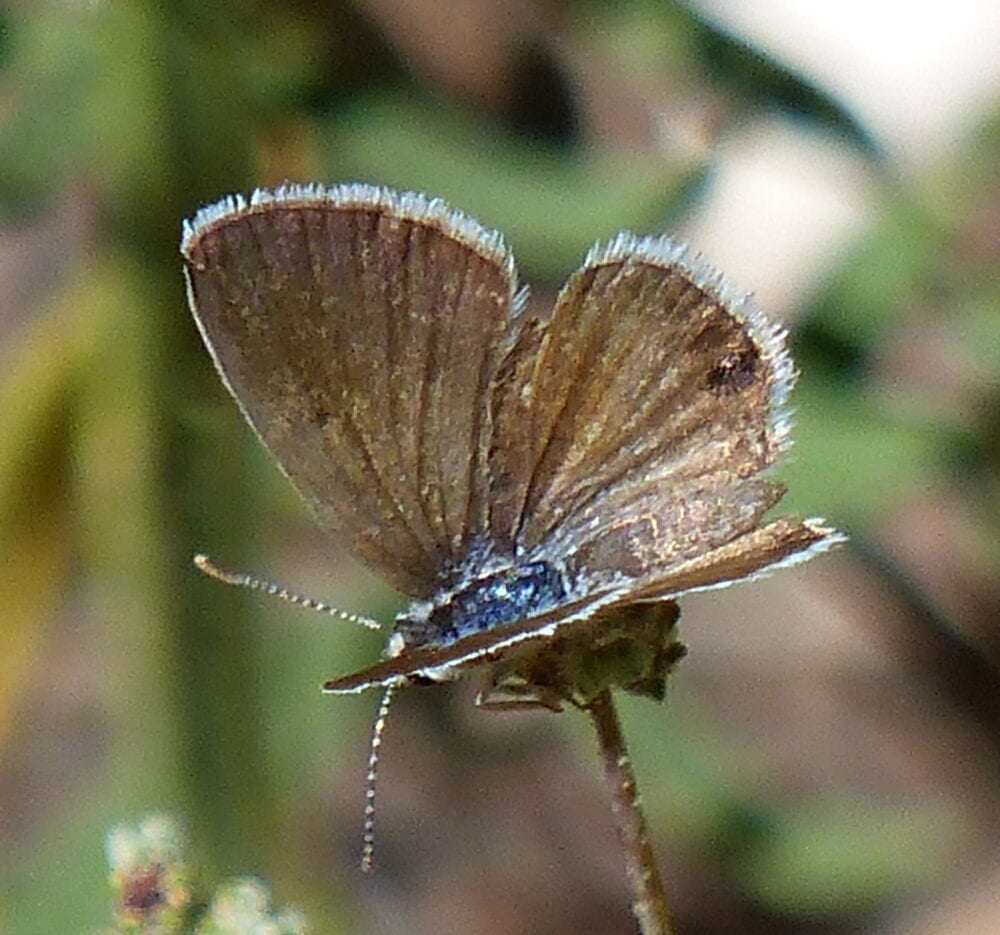
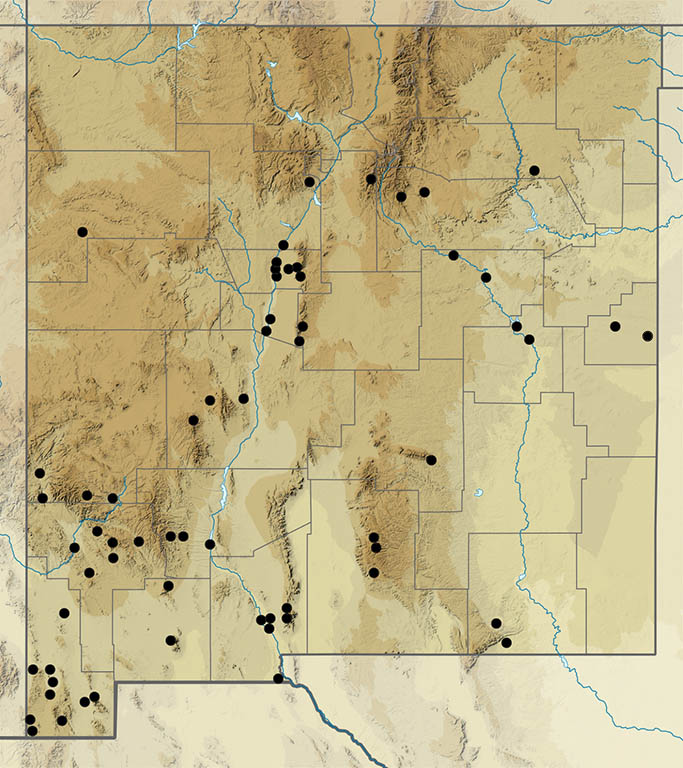
Echinargus isola (Reakirt) Reakirt’s Blue (updated July 10, 2022)
Description. Reakirt’s looks like Ceraunus, but the forewing underside has a prominent band of white-ringed, dark spots. If these blues were larger, this difference would be obvious, but their small size dictates that observers take a close look to get a correct identification. Range and Habitat. A variety of habitats in Mexico, Central America and the southwest US are core breeding areas for this butterfly. It has been one of our most common and widespread butterflies (all counties), 3000 to 10,800′ elevation. Life History. Many legumes are hosts, including species of Melilotus, Medicago, Mimosa, Astragalus, Acacia, Prosopis, and Trifolium. Larvae eat flowers and fruits and are attended by ants. Flight. As one might expect from a common species with many hostplant choices, E. isola is multivoltine and common much of the warm season. In New Mexico it has been found between January 1 and December 30, so basically year-round, though mid-winter observations are scarce. Adults fly near the ground to find nectar, dung and moist earth. Comments. Reakirt’s Blue has been a known part of our fauna since at least 1880, but it may be more widespread now due to anthropogenic proliferation of weedy and agricultural legumes. It occasionally strays far to the north and east of New Mexico (Michigan, Minnesota, Ohio, etc.).
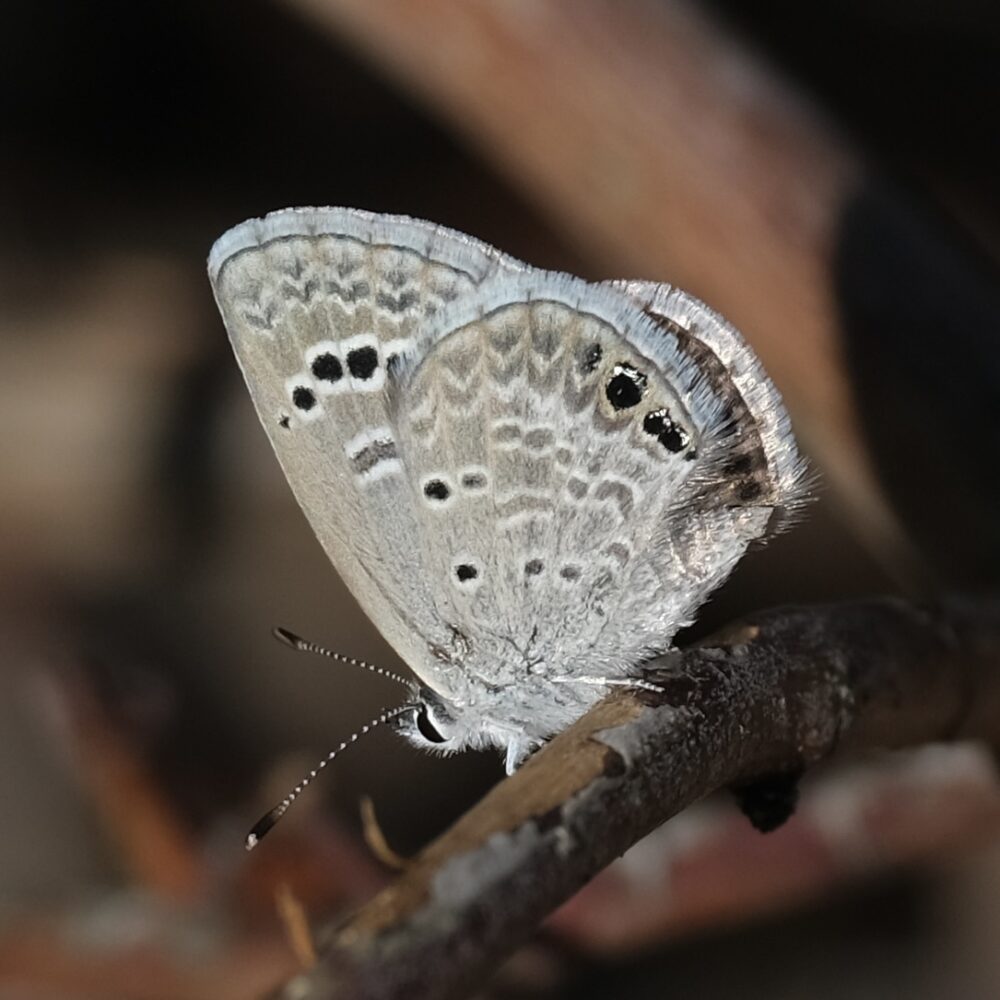
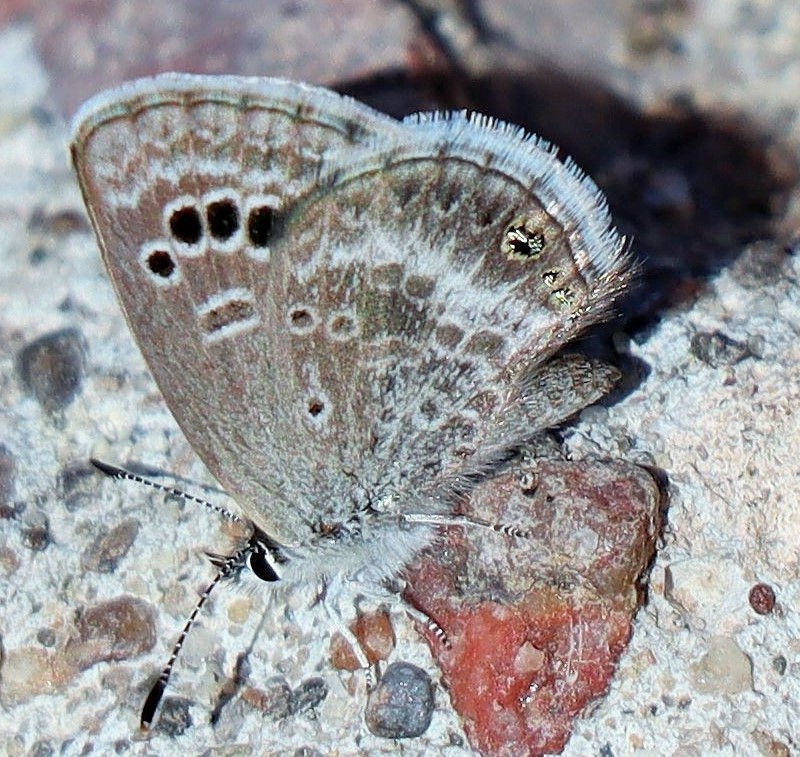
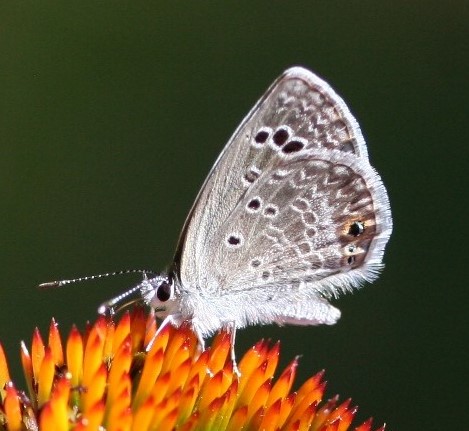
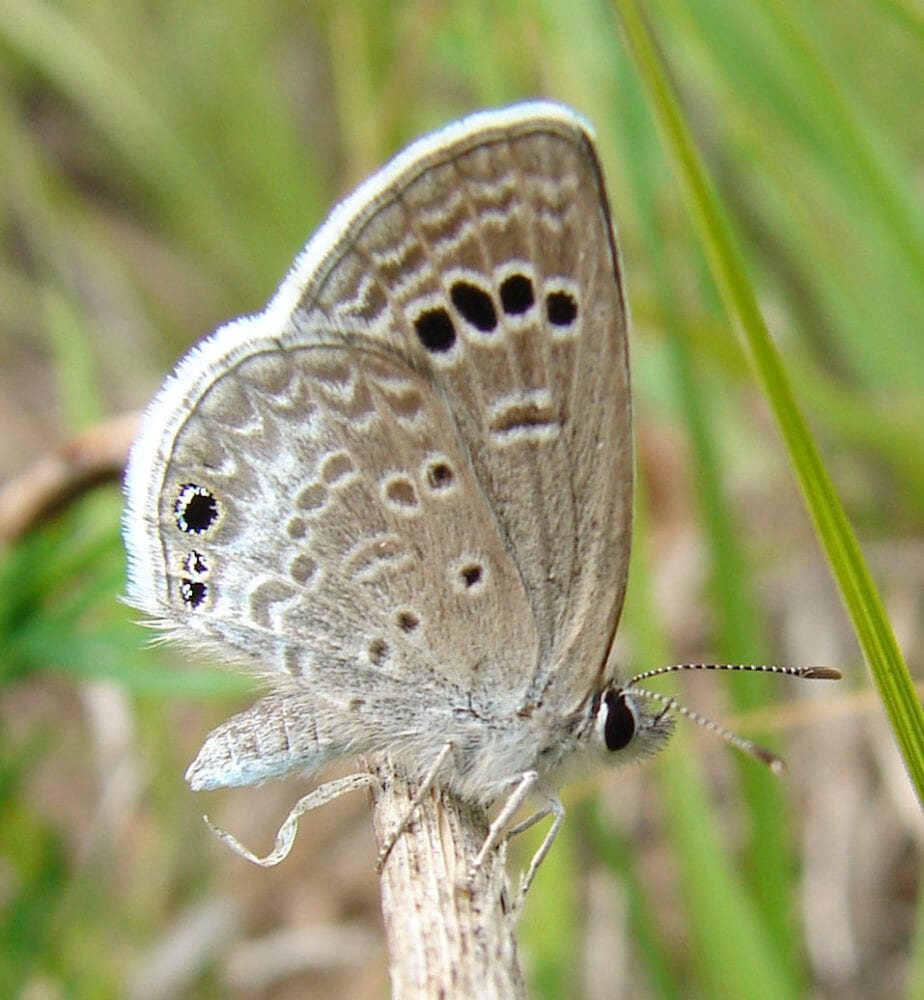
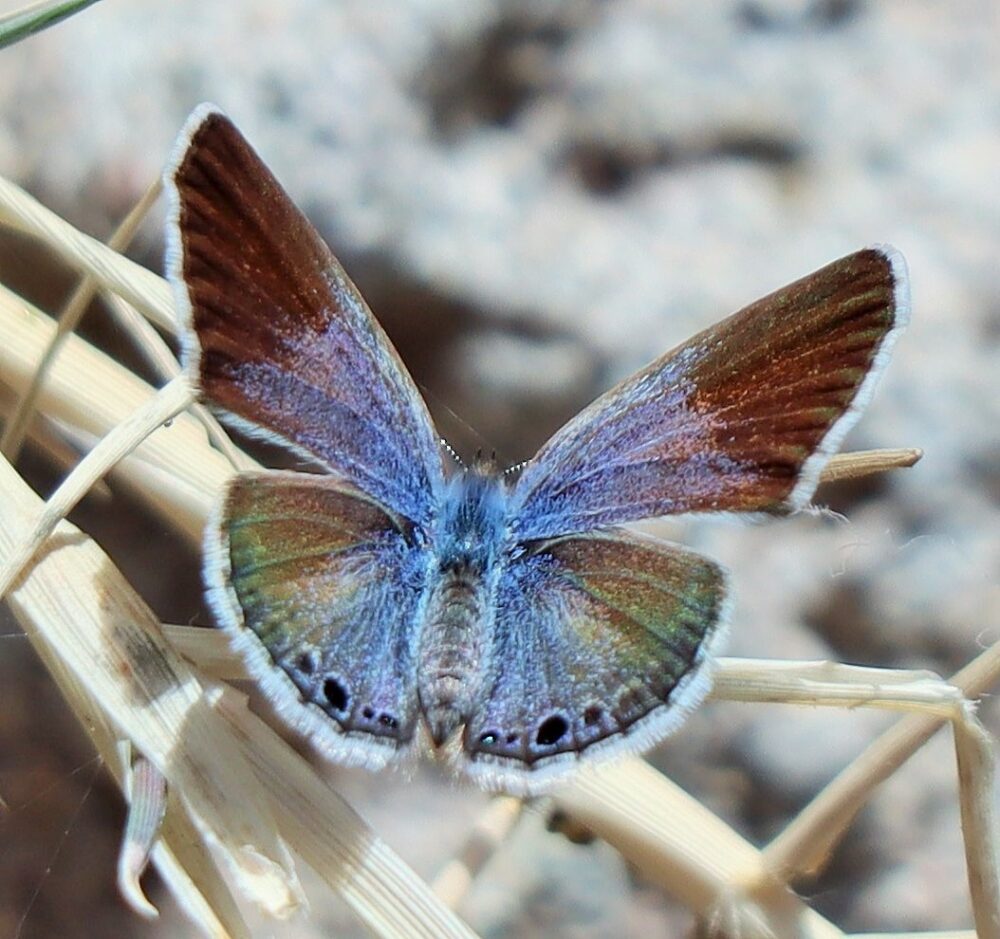

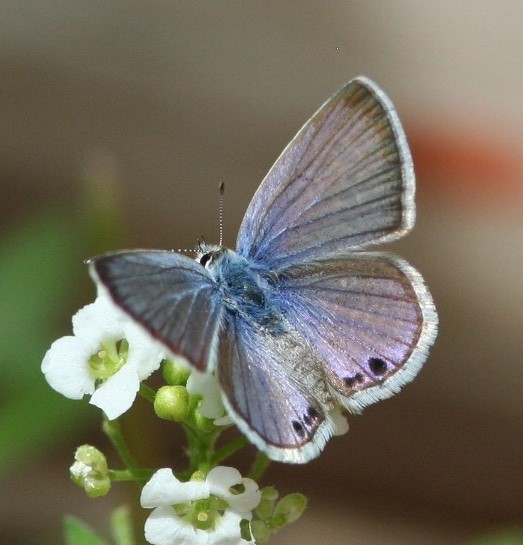
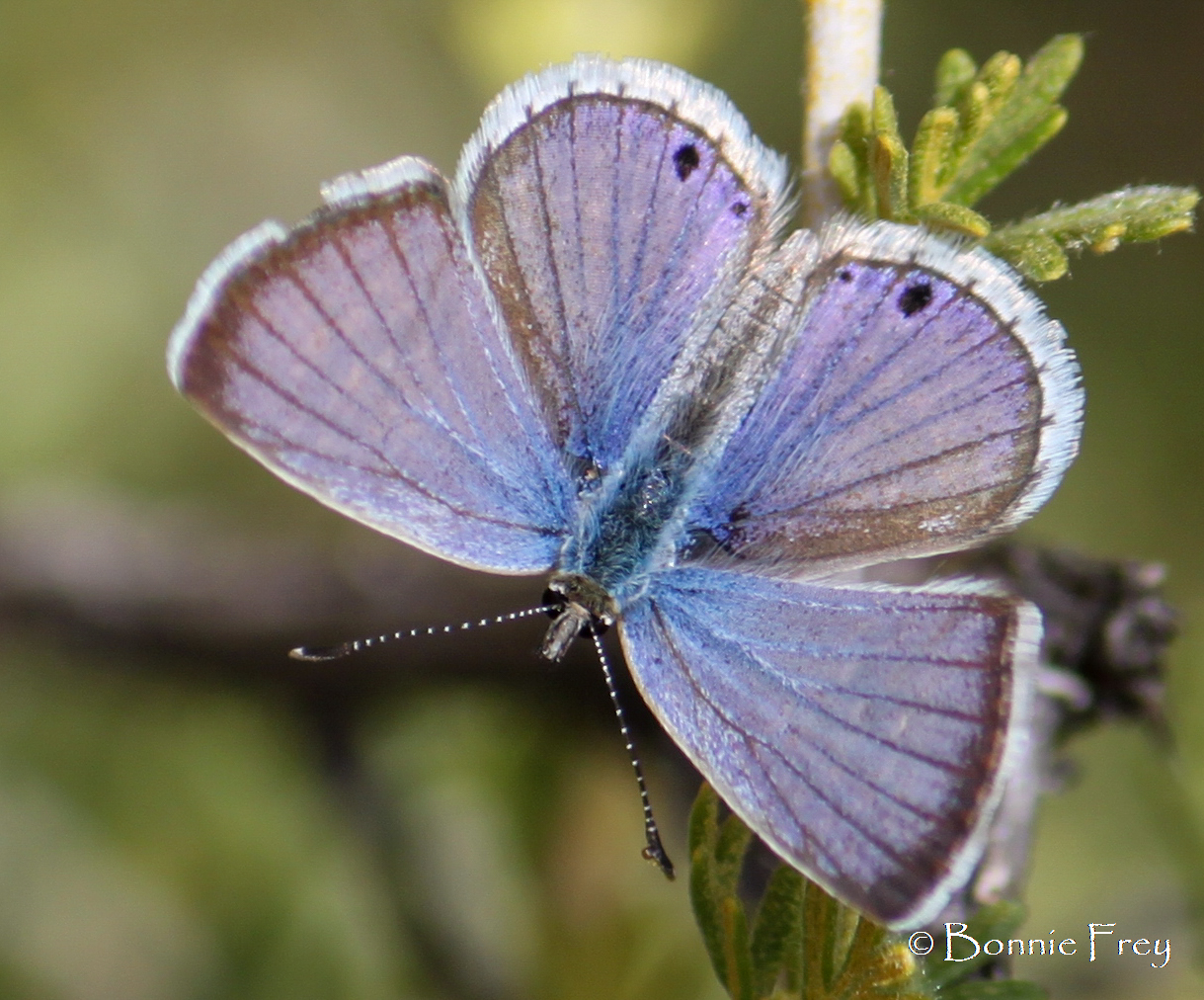
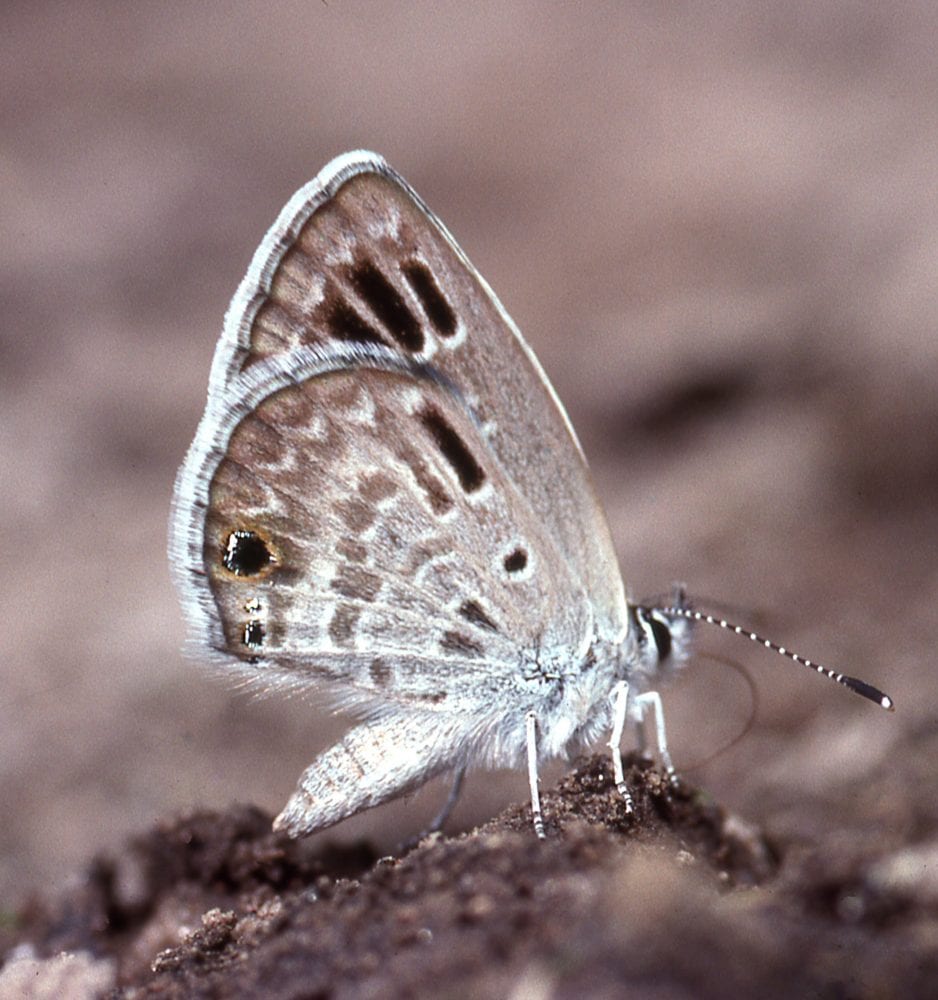
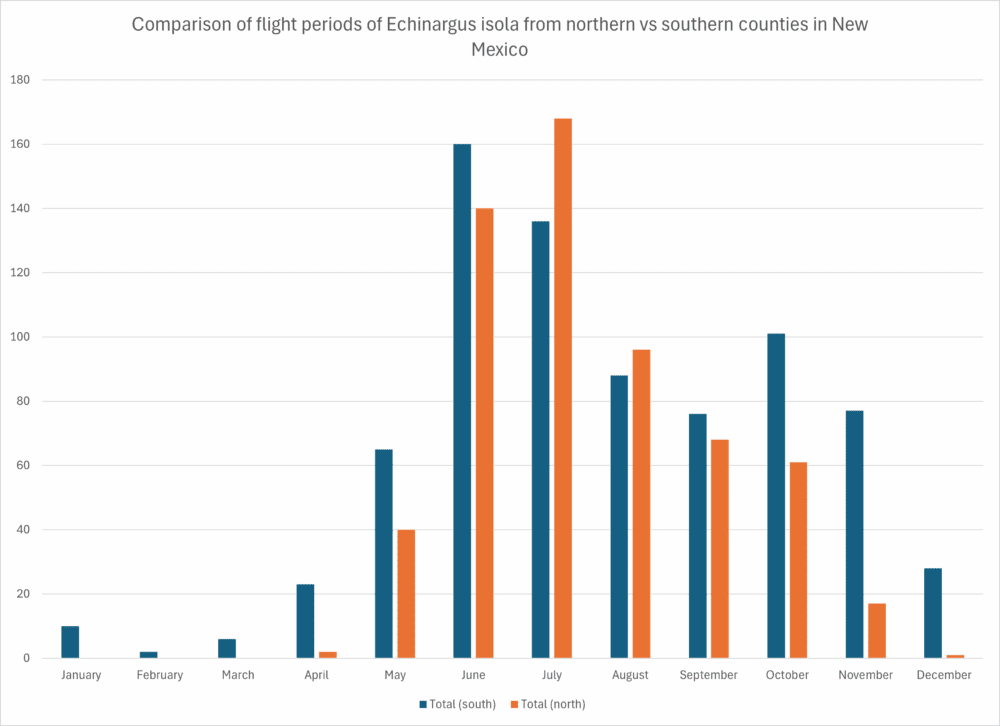
Icaricia lupini (Boisduval 1869) Lupine Blue (updated July 8, 2022)
Description. Iridescent green-blue spangles accent ventral hindwing submarginal orange bands of Lupine blues. These scintillae distinguish Lupine blues from all Buckwheat Blues, which lack them. Melissa Blues have scintillated orange bands on ventral forewing and hindwing. On uppersides, Lupine males are blue, while females are dark grey/brown with various degrees of blue overscaling; both sexes have dorsal hindwing orange bands with black centers. Range and Habitat. Lupine lives from southwest Canada across the western US to Mexico, from coast to the high Plains. In New Mexico (all counties) Lupine is widespread from deserts to treeline. Life History. Ironically and perhaps humorously, larvae of Icaricia lupini apparently do not eat lupines; they eat wild buckwheats (Polygonaceae) such as Eriogonum corymbosum, E. annuum (RA), E. cernuum and E. wrightii (Ca). S. J. Cary witnessed an oviposition on E. jamesii var. wootonii on 1 July 2000 (Li) and that observation is now presumed to have involved a female Lupine Blue. Lupine Blue larvae may also feed on some Fabaceae; we won’t know for sure until species limits in this group have been firmly established. Adults feed at nectar, dung and wet sand. Flight. Lupine Blue is multivoltine; adults have been found all months of the year as far north as Albuquerque (Be). High altitude observations may be of a related species, Icaricia cotundra (J. Scott & M. Fisher 2006). Comments. We may have subspecies Icaricia lupini texanus Goodpasture 1973, at least in southwest NM. Northern counties may have Icaricia lupini lutzi (dos Passos 1938). Lupine Blue is a member of a complex of very similar species. Challenges within this multi-species group reveal the inadequacy of photographs when genitalic examination or DNA analysis is ultimately required to distinguish one from the others. There are multiple reports of Icaricia acmon (Westwood [1851]) from New Mexico; that species is now thought to be mainly a Pacific Coast beast, but who knows? Mother Nature does not always fit her creatures into convenient boxes for us humans. For now, all New Mexico reports of I. acmon are treated here as I. lupini.
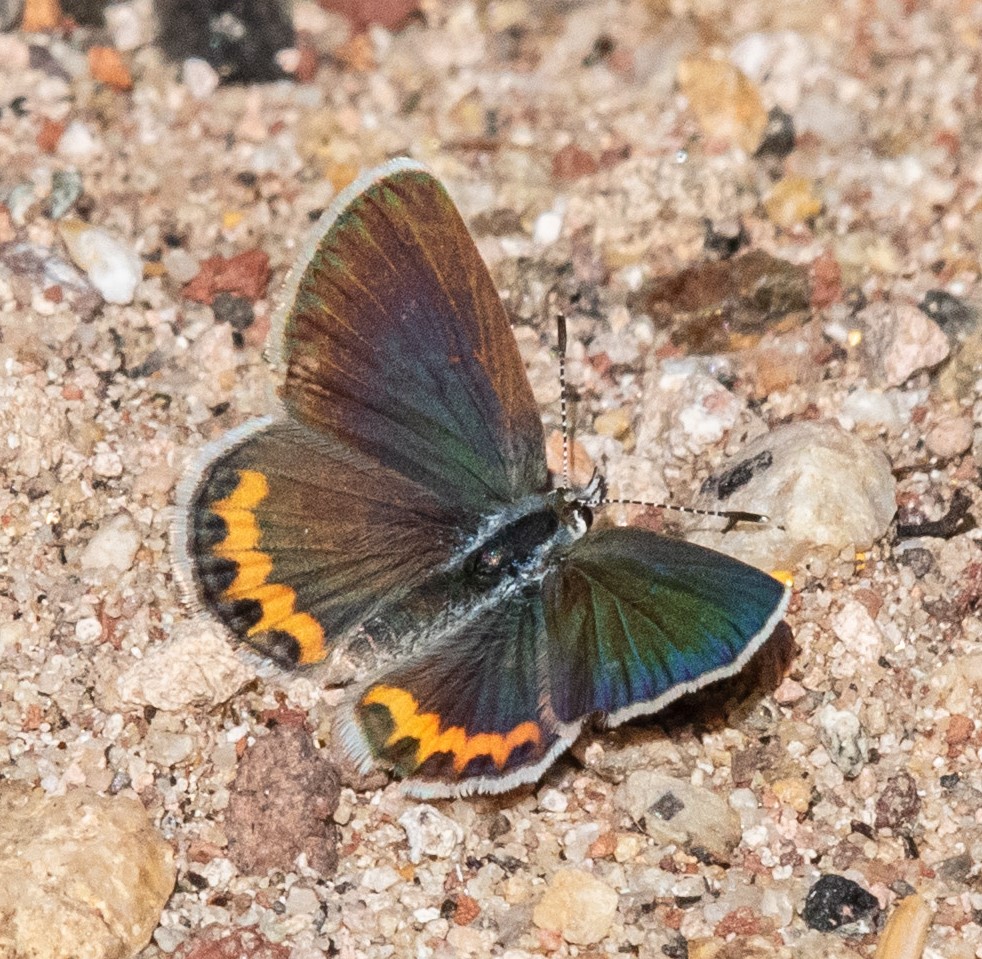
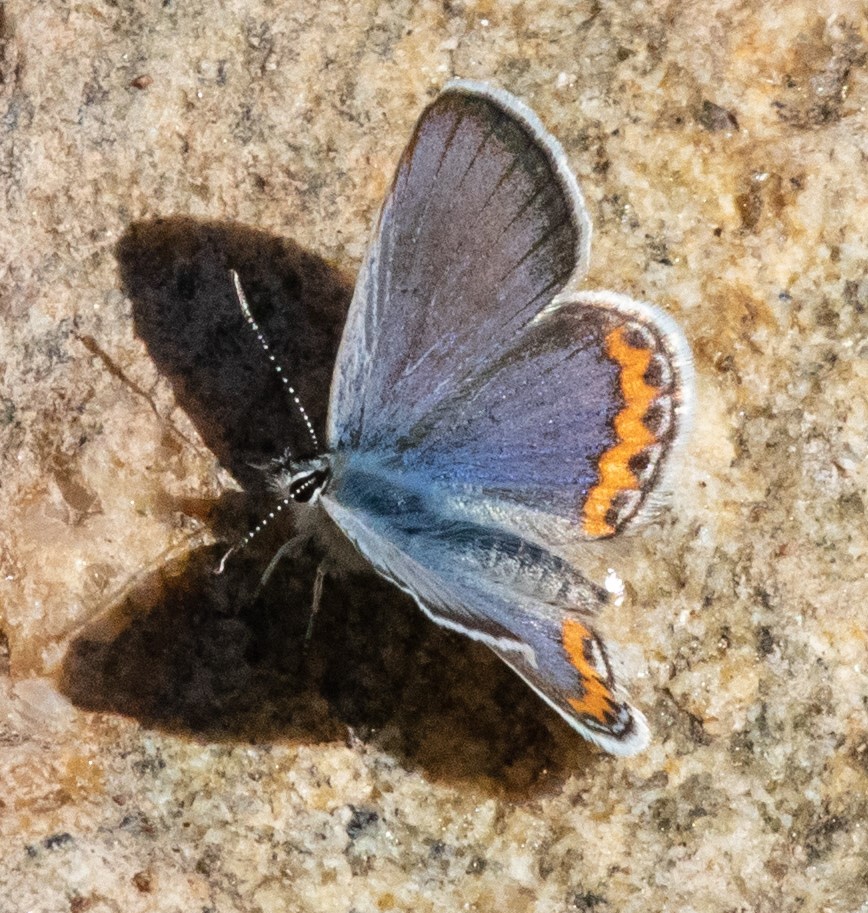
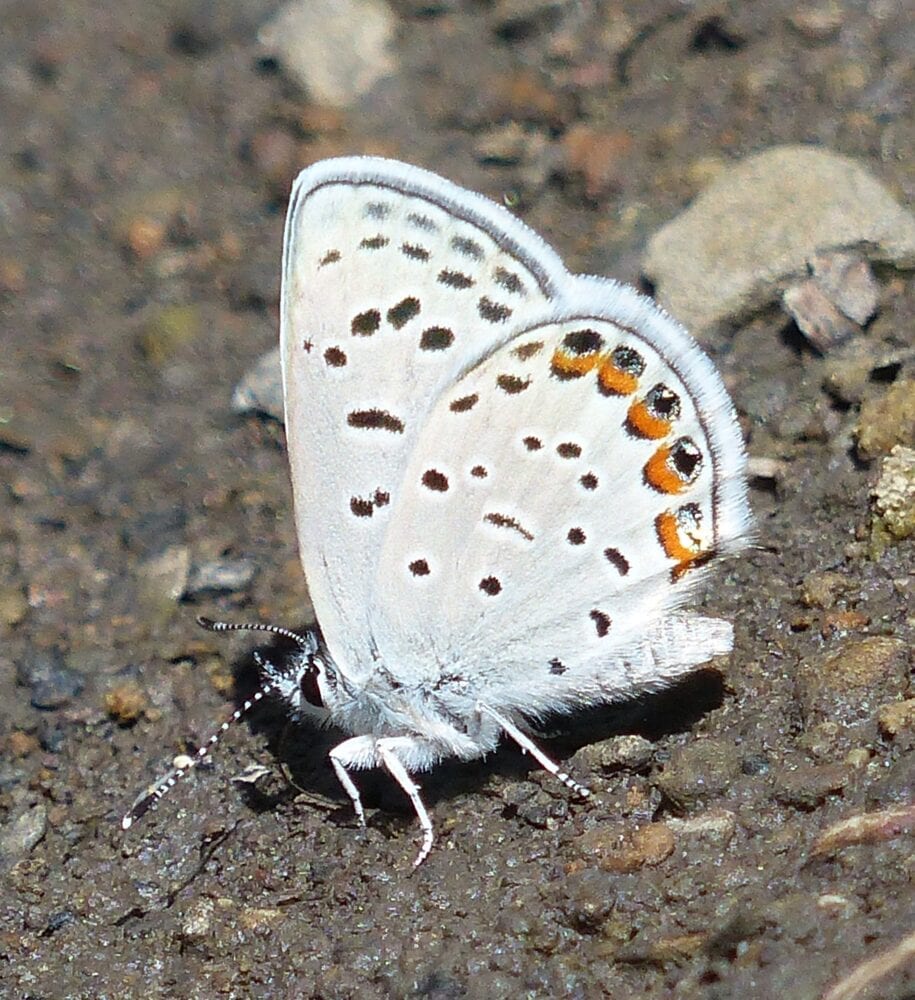
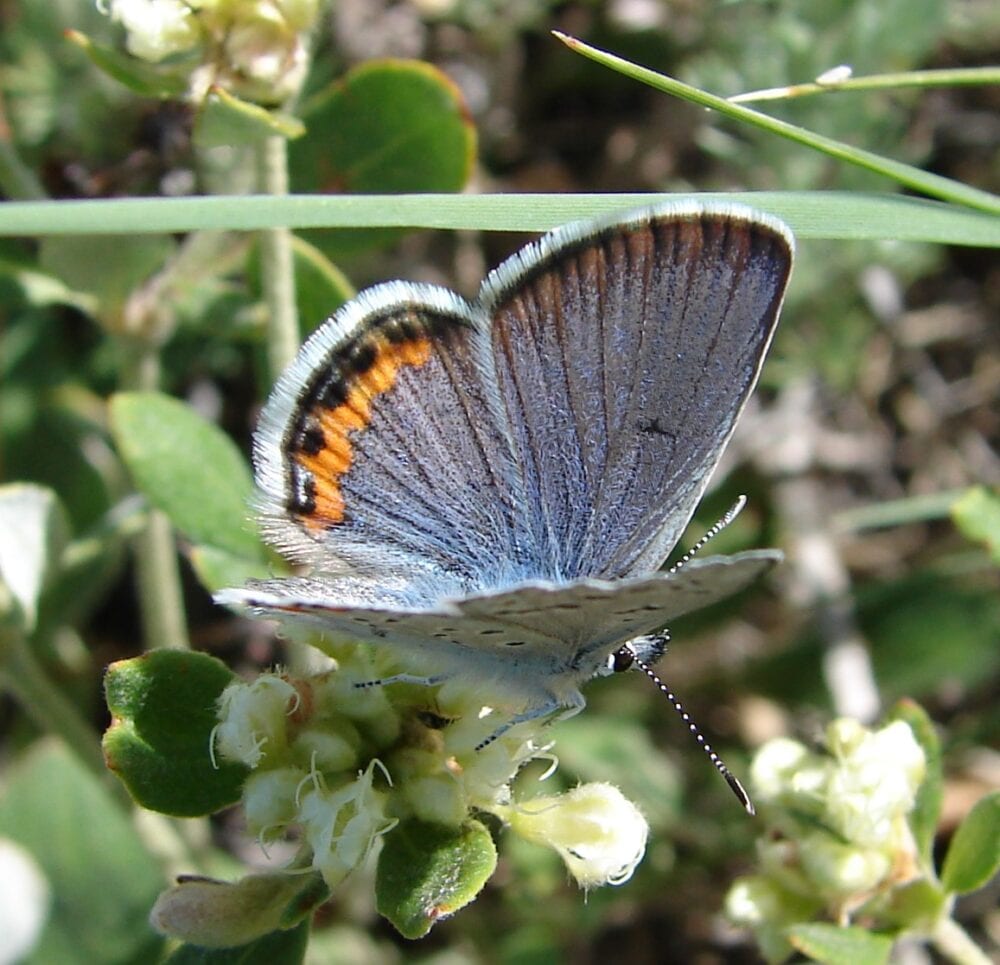
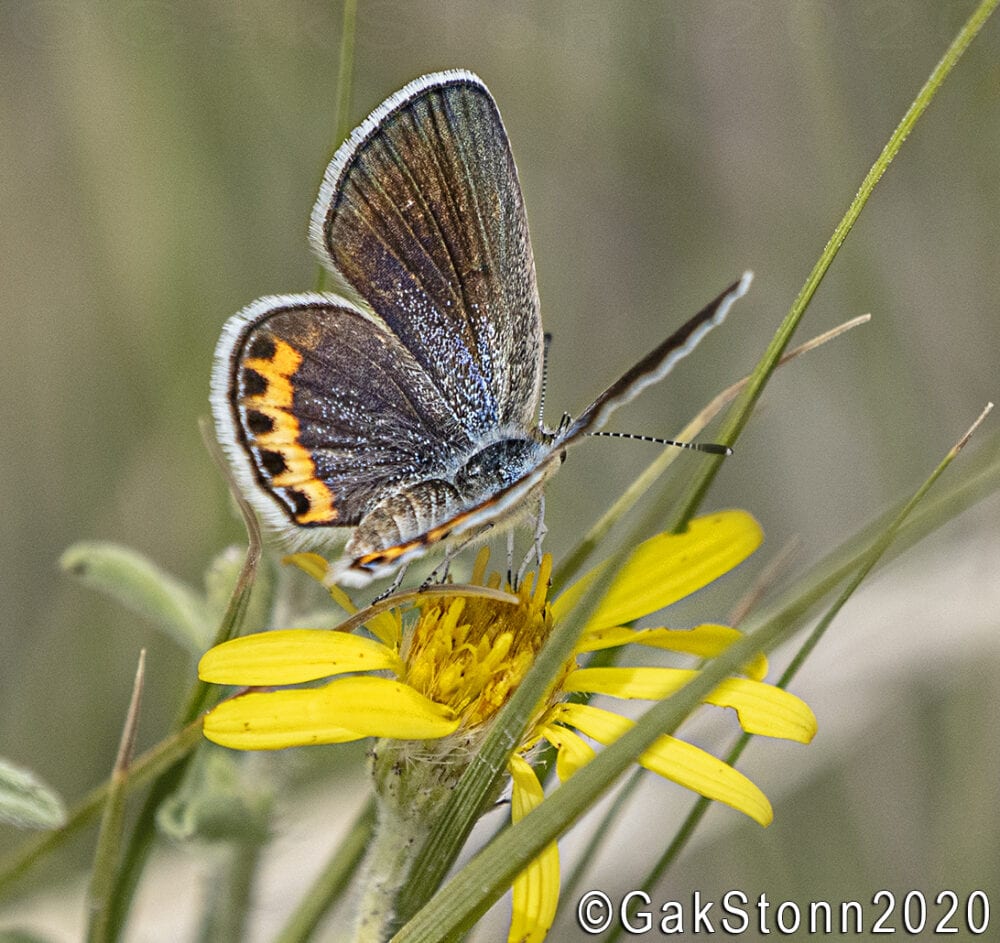
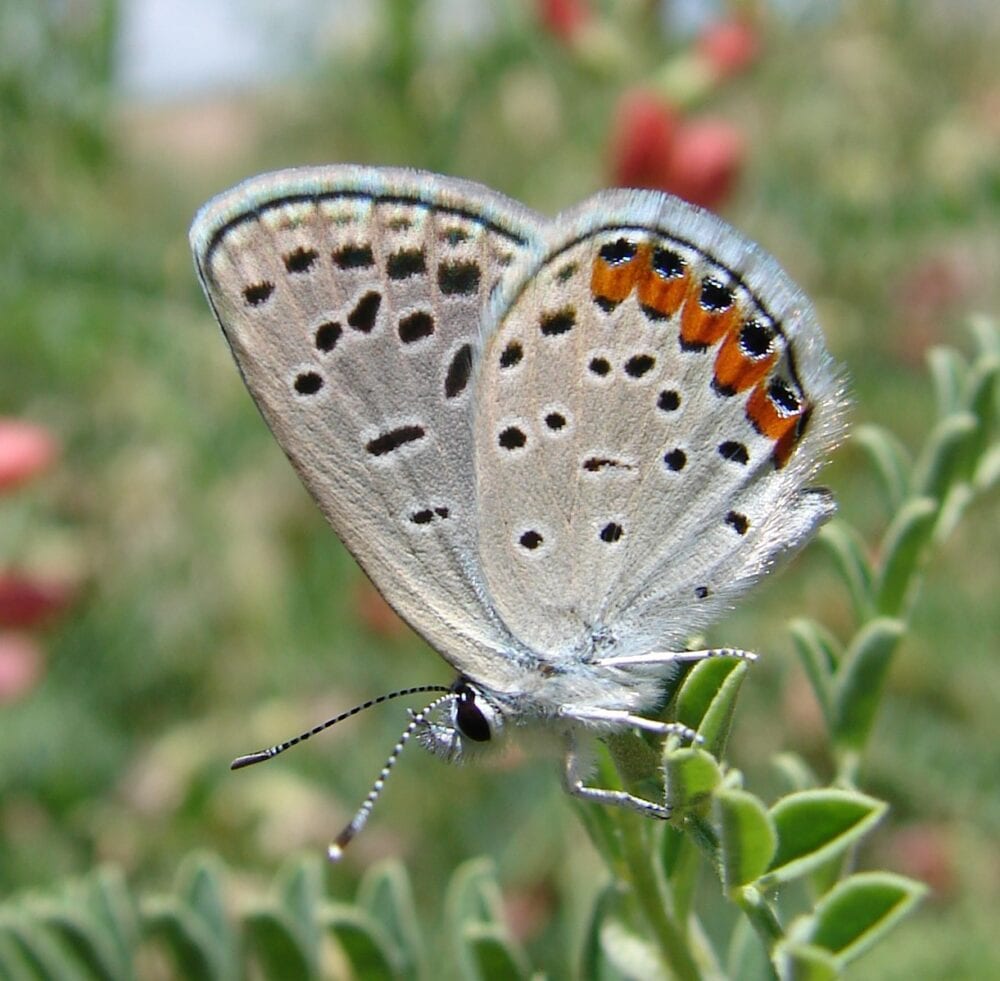
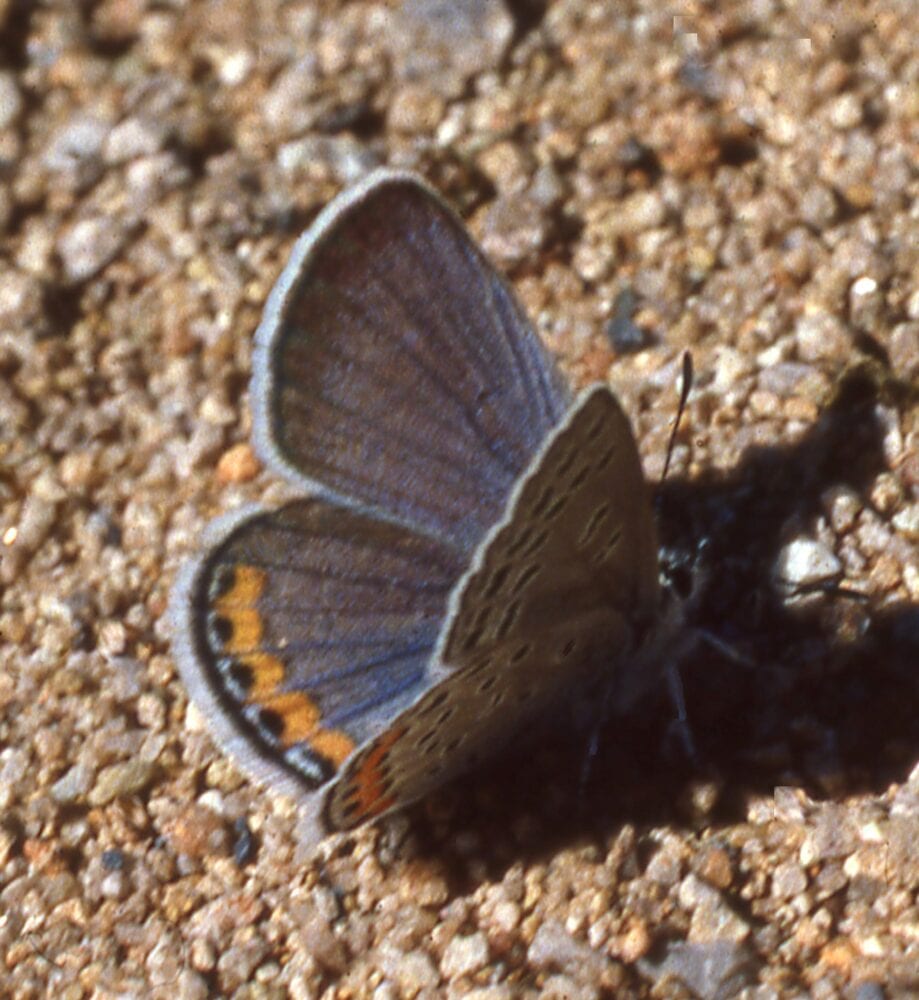
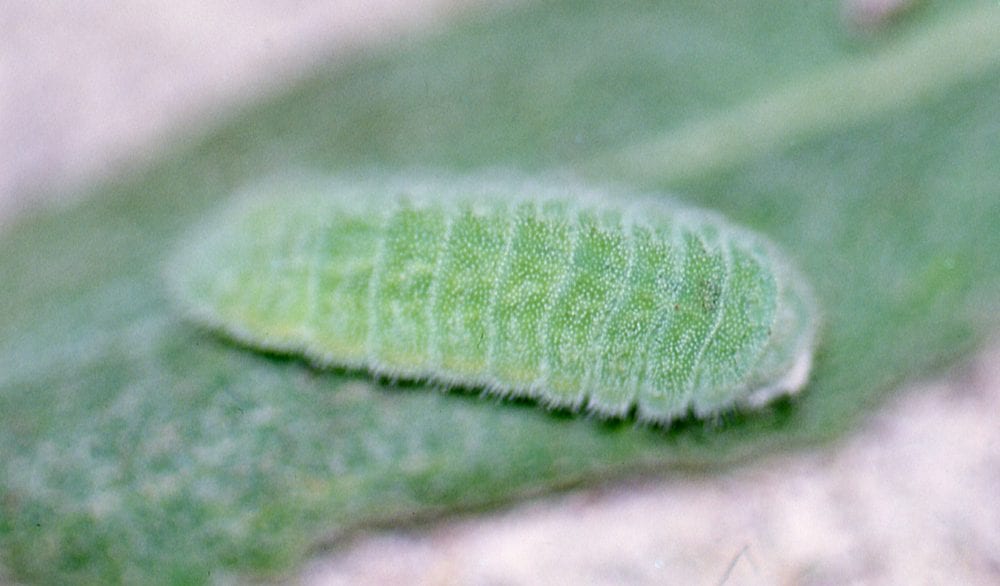
Icaricia saepiolus (Boisduval 1852) Greenish Blue (updated July 15, 2022)
Description. Greenish Blue males are glossy blue above with a cell-end black bar. Females are iridescent blue-brown. Below, they are tan or grey with a postmedian row of white-rimmed black spots, a submarginal row of double spots (this is diagnostic), and a definite hint of orange at the ventral hindwing tornus. Range and Habitat. Boreal Canada and the Rocky Mountains harbor this species. It occupies the higher mountains in New Mexico (counties: Ca,Co,LA,Mo,RA,Sv,SJ,SM,SF,Ta), generally 7500 to 12,500′. Life History. Larvae eat legumes (Fabaceae) such as Trifolium spp. (clovers) and Astragalus spp. Larvae overwinter. Flight. Adults fly in one mid-summer generation. New Mexico records fall between May 28 and September 2, with peak numbers in July; there is an odd October 3 record. Adults fly near the ground, nectar at clovers and sip at wet sand. Comments. We have Rocky Mountain Icaricia saepiolus whitmeri (F. Brown 1951), whose females are brown above. The Mogollon Rim (Ca) has the smaller I. s. gertschi dos Passos 1938, whose females are blue above. The species is (apparently) curiously absent from the higher mountains in central New Mexico.
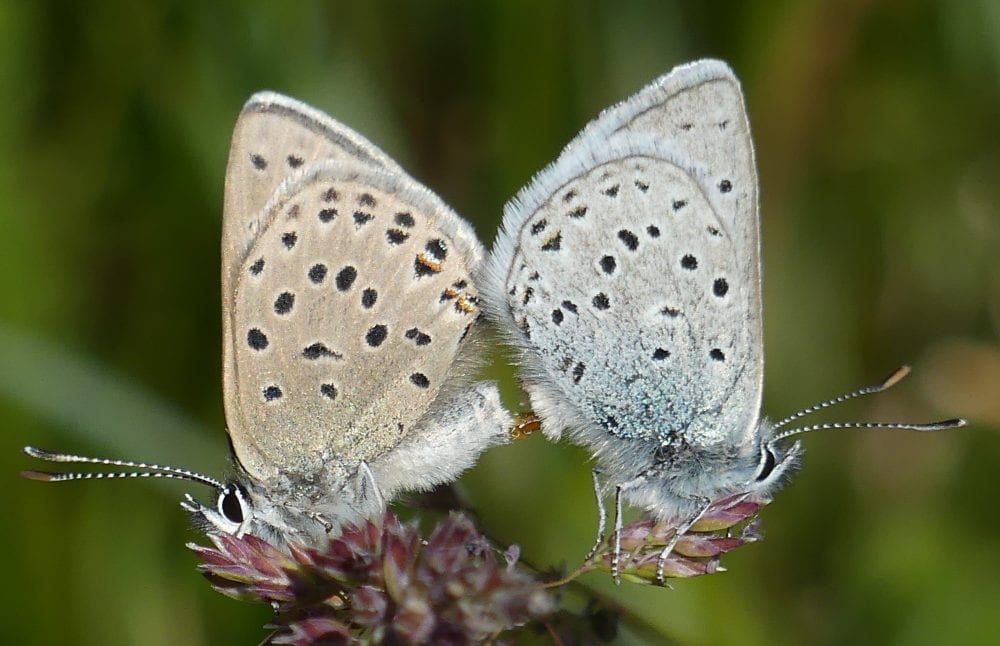
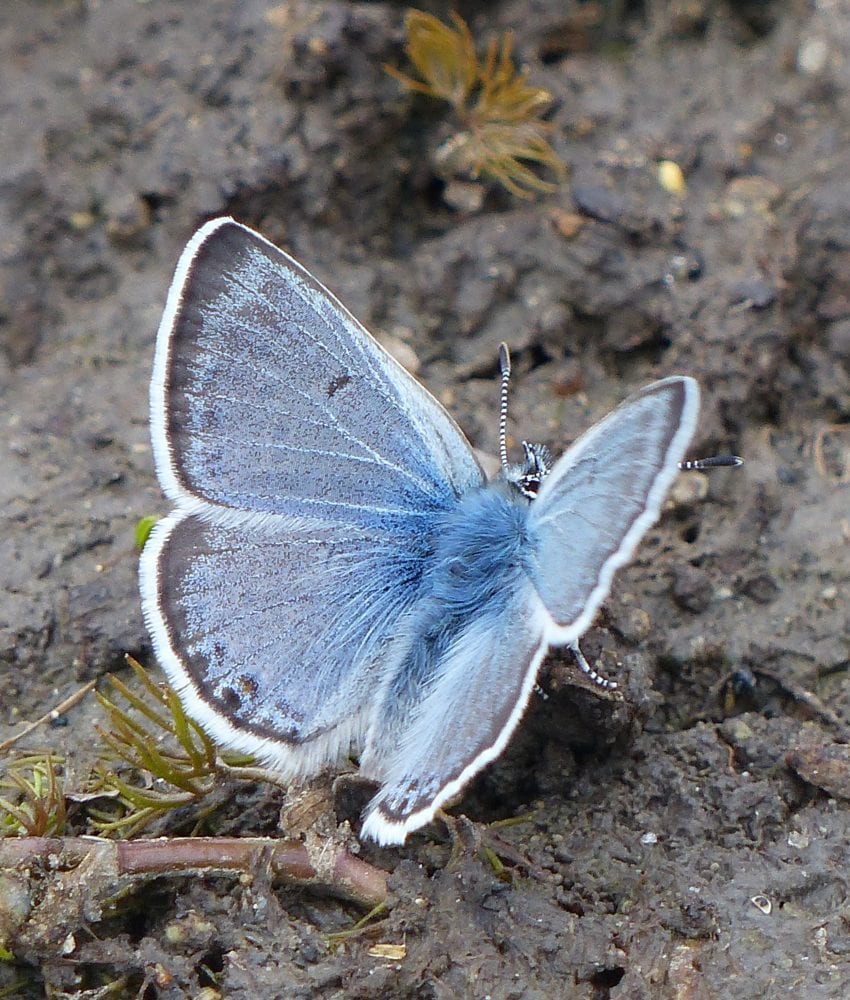
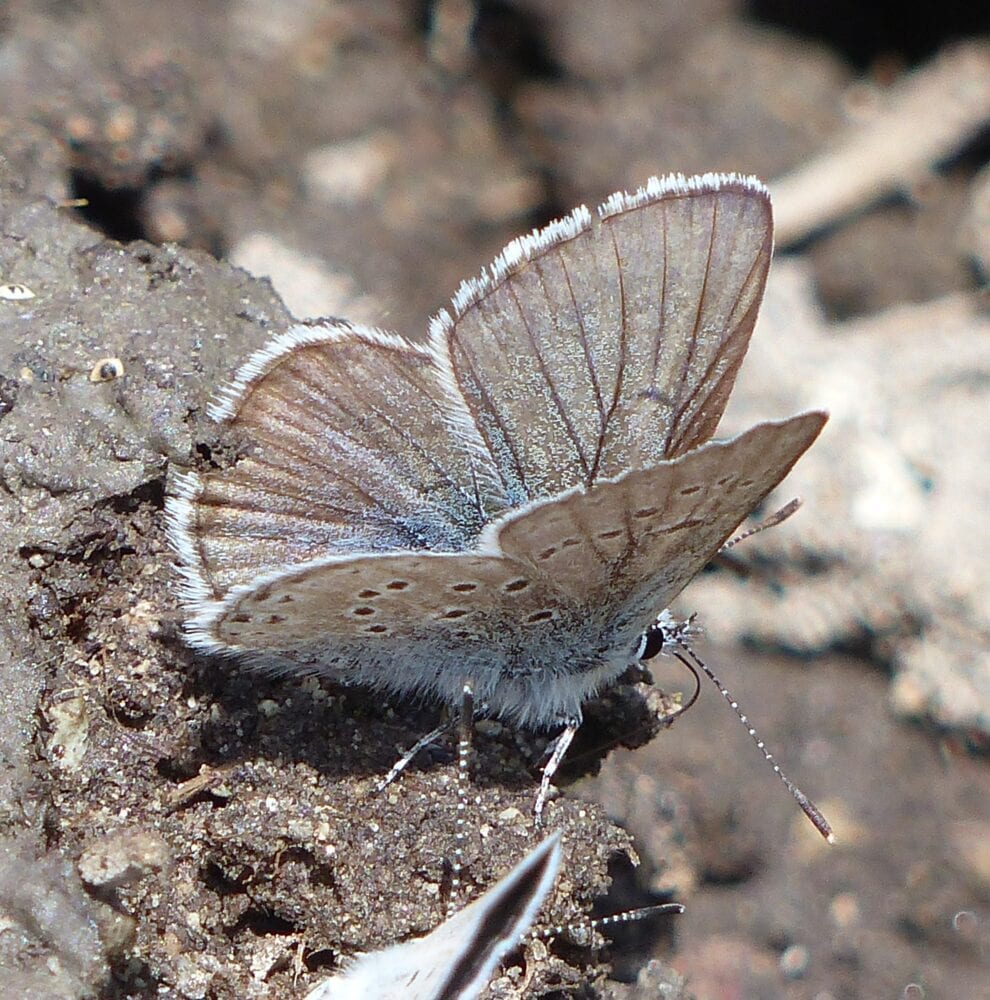
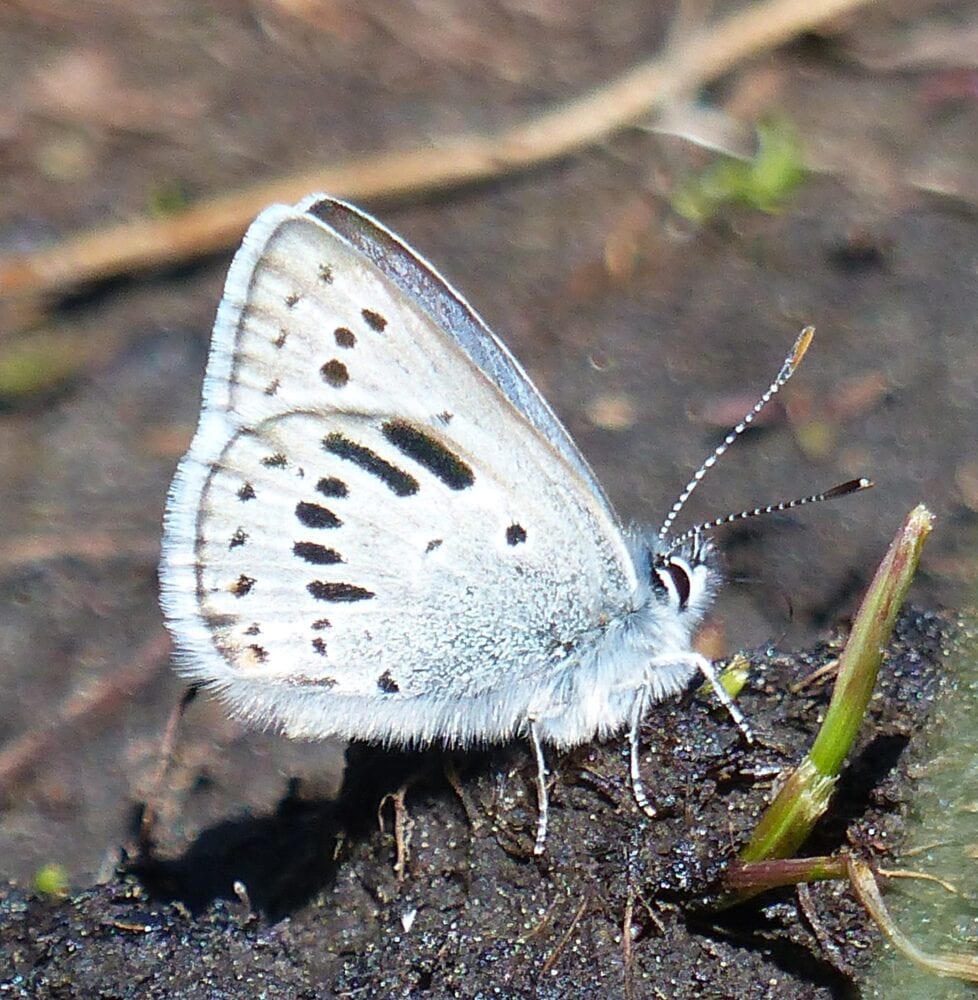
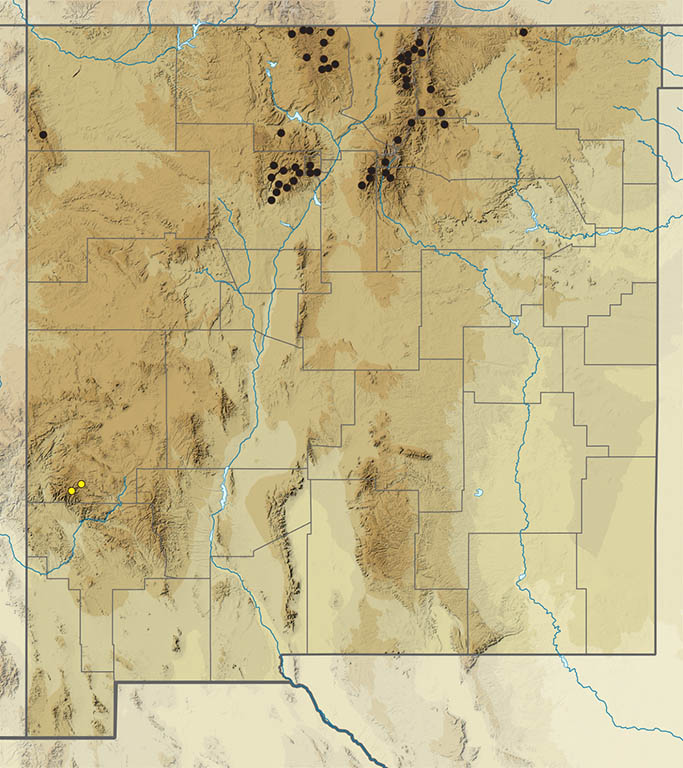
Icaricia icarioides (Boisduval 1852) Boisduval’s Blue (updated July 13, 2024)
Description. Boisduval’s is our largest blue, but still not very big. Males are iridescent sky blue above with black edging. Females are dark gray above with blue basal scaling. Beneath, the forewing has a bold postmedian band of white-ringed black spots and a similar cell-end bar. The hindwing underside is gray with small, dark submarginal chevrons and a postmedian band of white-ringed black spots. There is a gap between submarginal chevrons and postmedian band. Range and Habitat. Icaricia icarioides lives throughout the western US, occupying habitats from sea level to Hudsonian Zones. New Mexico populations prefer Transition and Canadian Zone montane savannas and meadows (counties: Ca,Ci,Co,Gr,Li,LA,MK,Mo,Ot,RA,Sv,SJ,SM,SF,Si,Ta,Un) with stands of the host plant, generally 7500 to 12,500′. Life History. Larvae of Boisduval’s Blue eat various Lupinus spp. (Fabaceae). Of the many lupine species in New Mexico, Lupinus argenteus is favored in the north. Mike Toliver saw oviposition on this lupine at Capulin Mountain (Un), 20 June 1971. It also is the primary host on Burnt Mesa in Bandelier National Monument (LA) and in the Raton Mesa complex (Co). Other lupines may be acceptable as well. Part-grown larvae hibernate. Flight. Icaricia icarioides is univoltine here. New Mexico records fall between May 6 and August 20, with peak numbers in June and July. Adults seek nectar (e.g., Amorpha canescens, Eriogonum racemosum) and wet soil. Males perch on host lupines to watch for females. Comments. Great geographic variation in this species has resulted in proliferation of named subspecies by taxonomists (25, by our last count). Most New Mexico populations are grouped with central Rocky Mountains race Icaricia icarioides lycea (W. H. Edwards 1864), which has bold ventral hindwing black cell spots. Colonies on the Mogollon Rim and nearby areas (Ca,Gr,Si) belong to ssp. I. i. buchholzi dos Passos 1938, whose males have a wide black border on the upperside. Populations in the Raton Mesa Complex (Co,Un) has females that are glossy black above, with few if any basal blue scales, and are subspecies I. i. nigrafem (R. Holland 2011). Populations in the Sierra Blanca complex (Li,Ot) colonize the endemic Lupinus sierrae-blancae and are subspecies I. i. sacre (R. Holland 2011), which is now recognized by Pelham (2024).
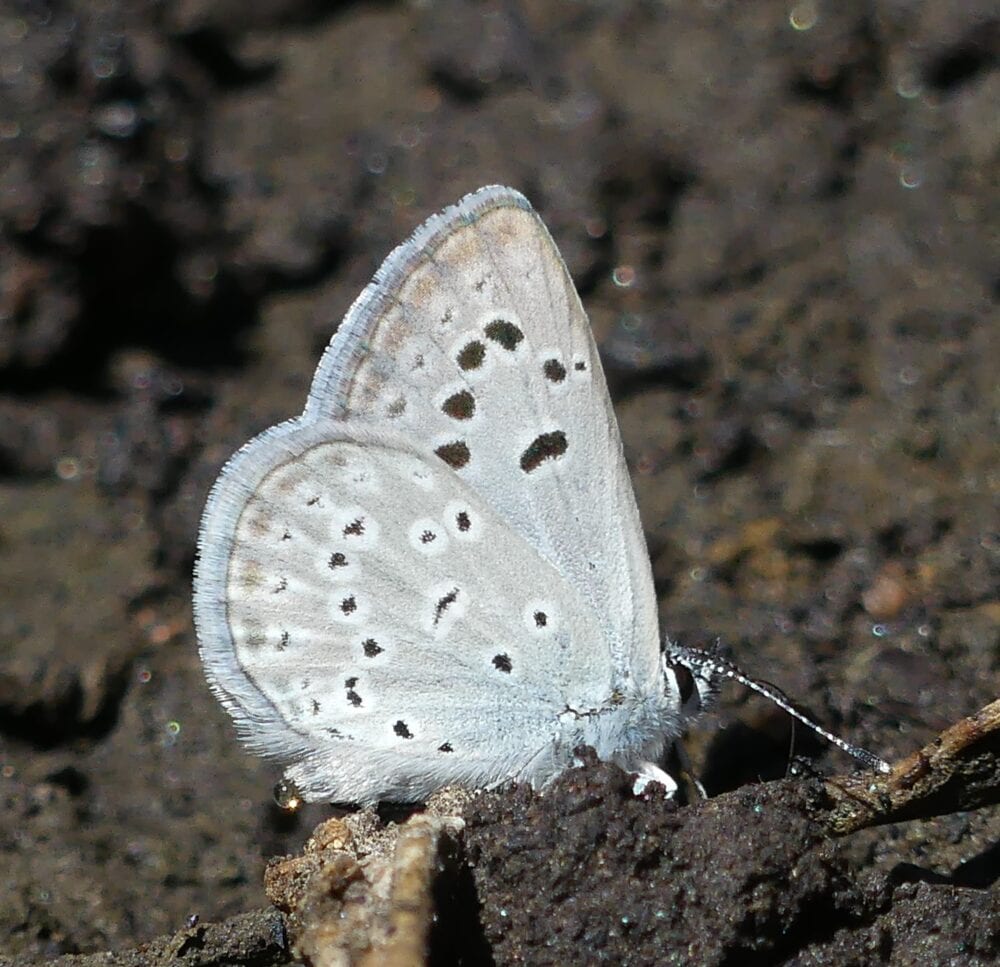
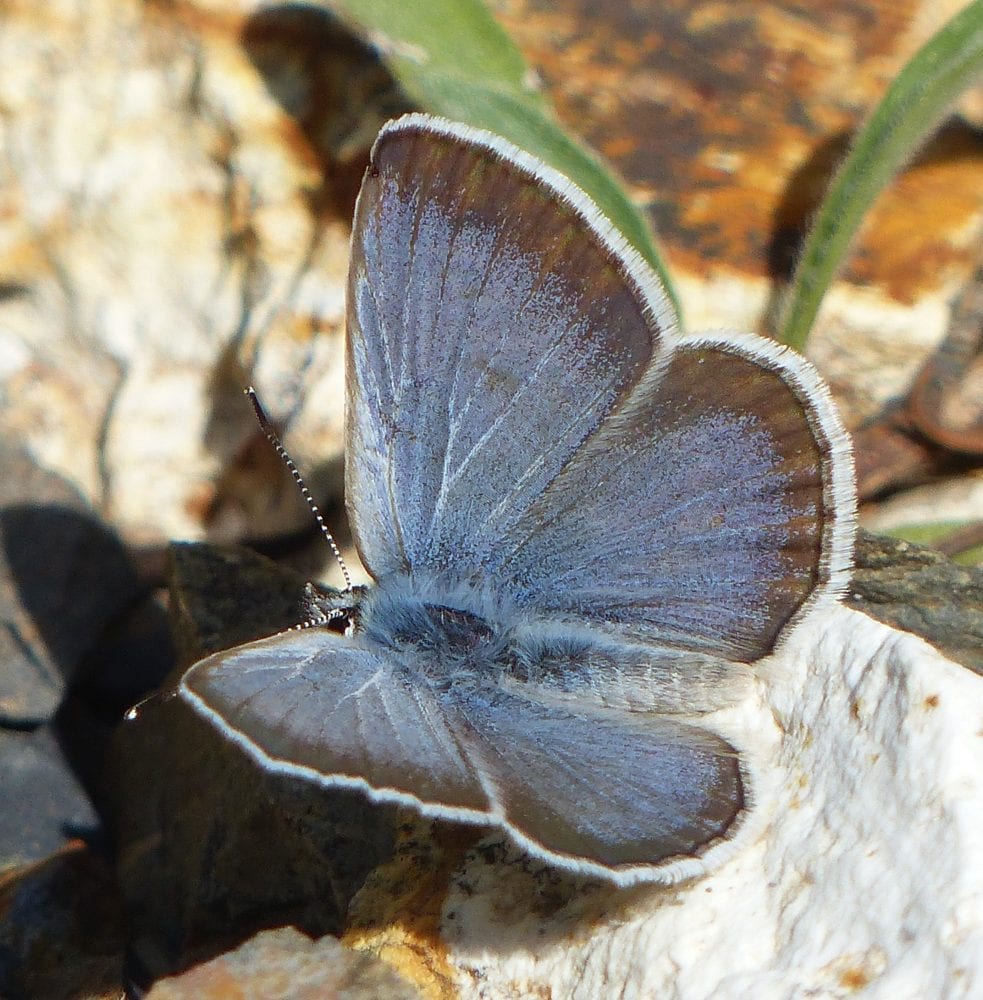
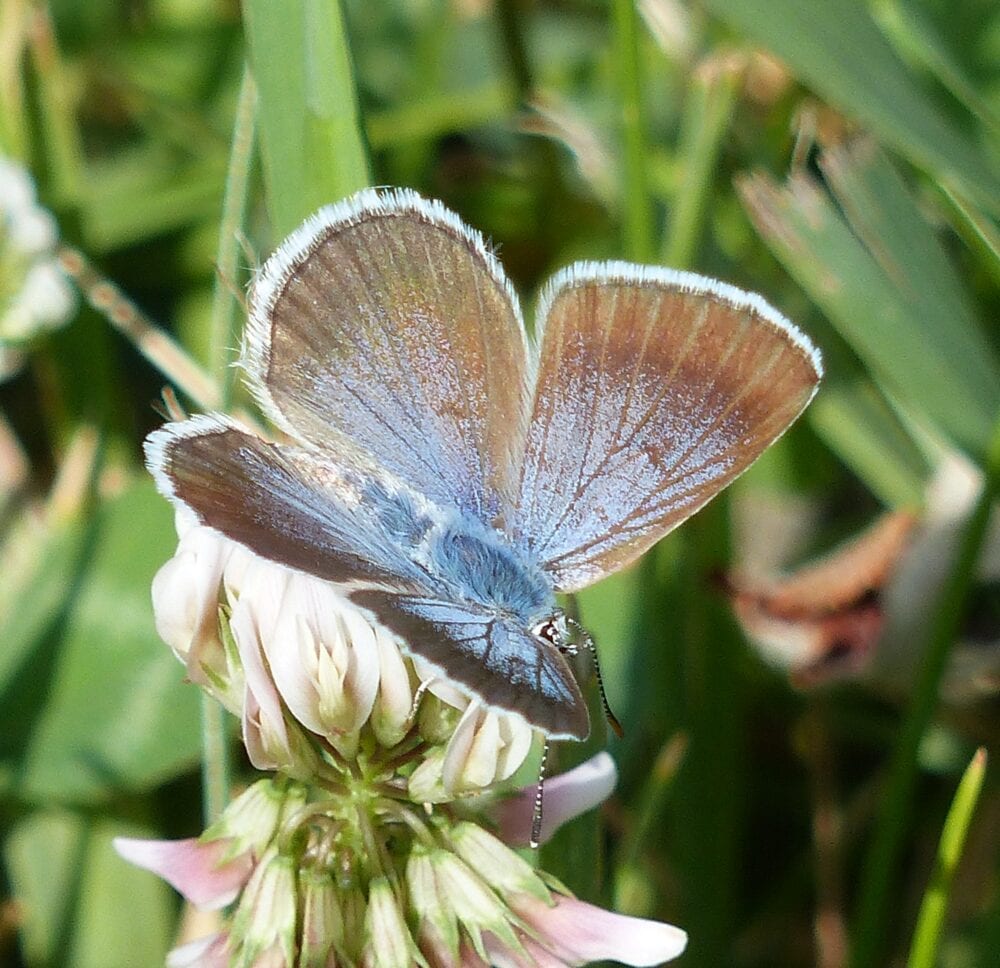
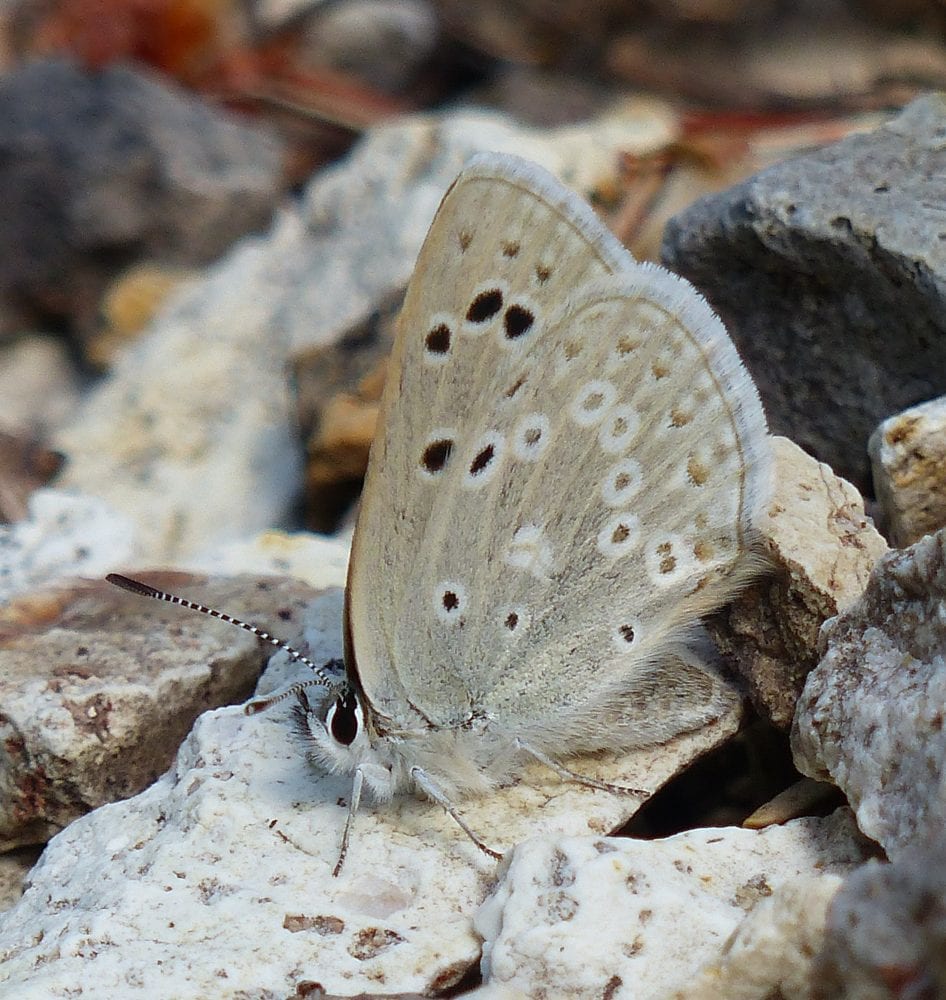
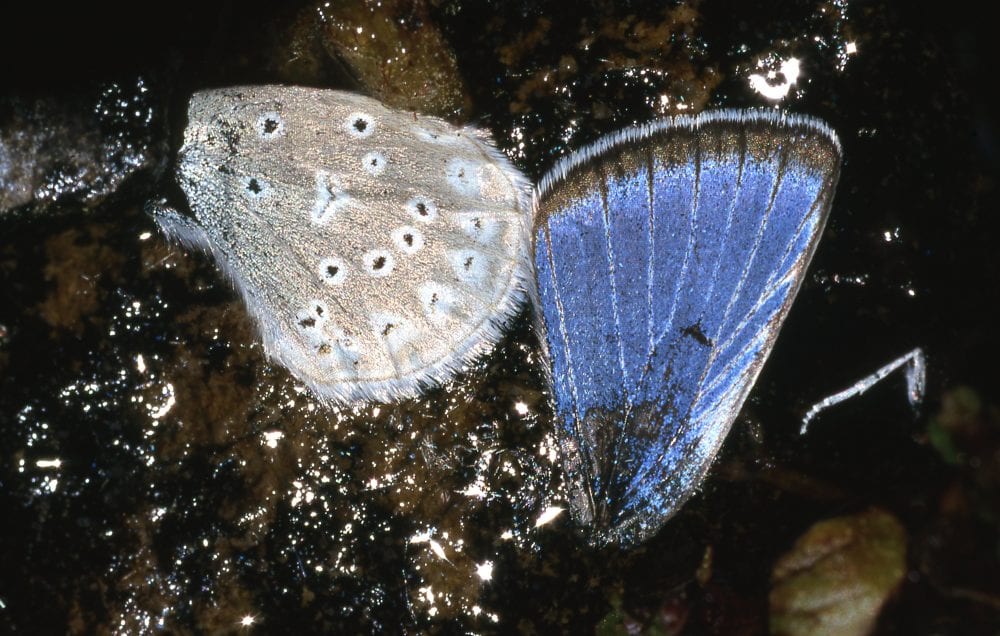
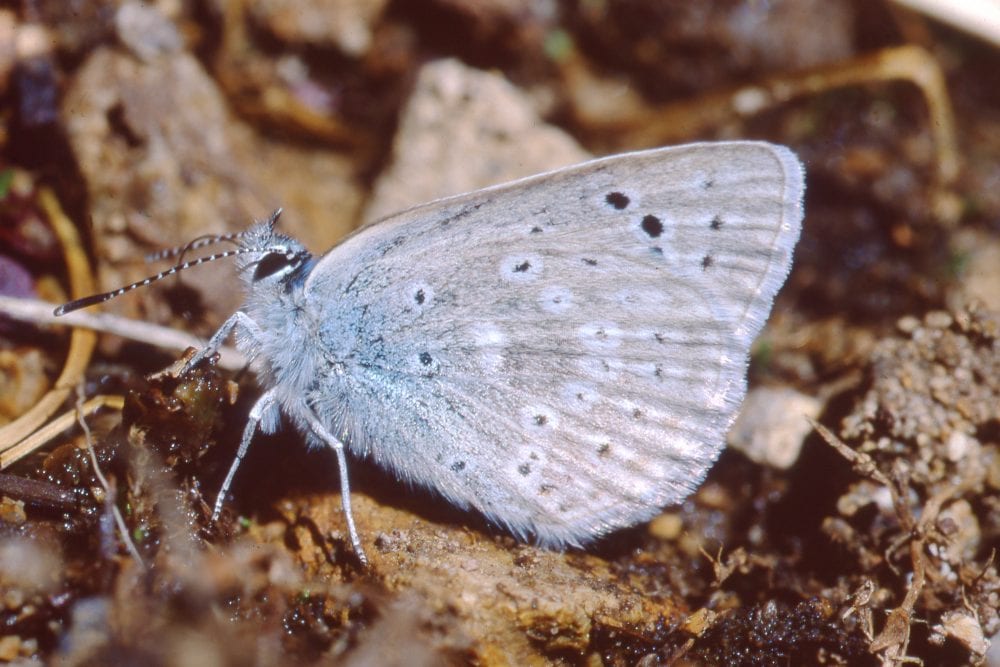
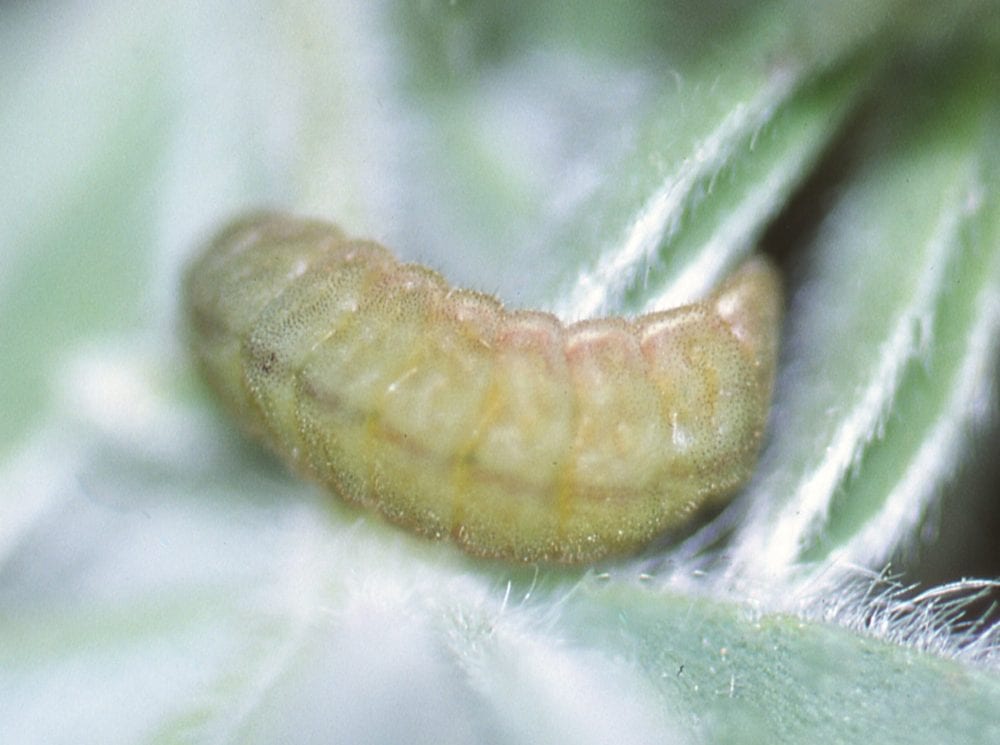
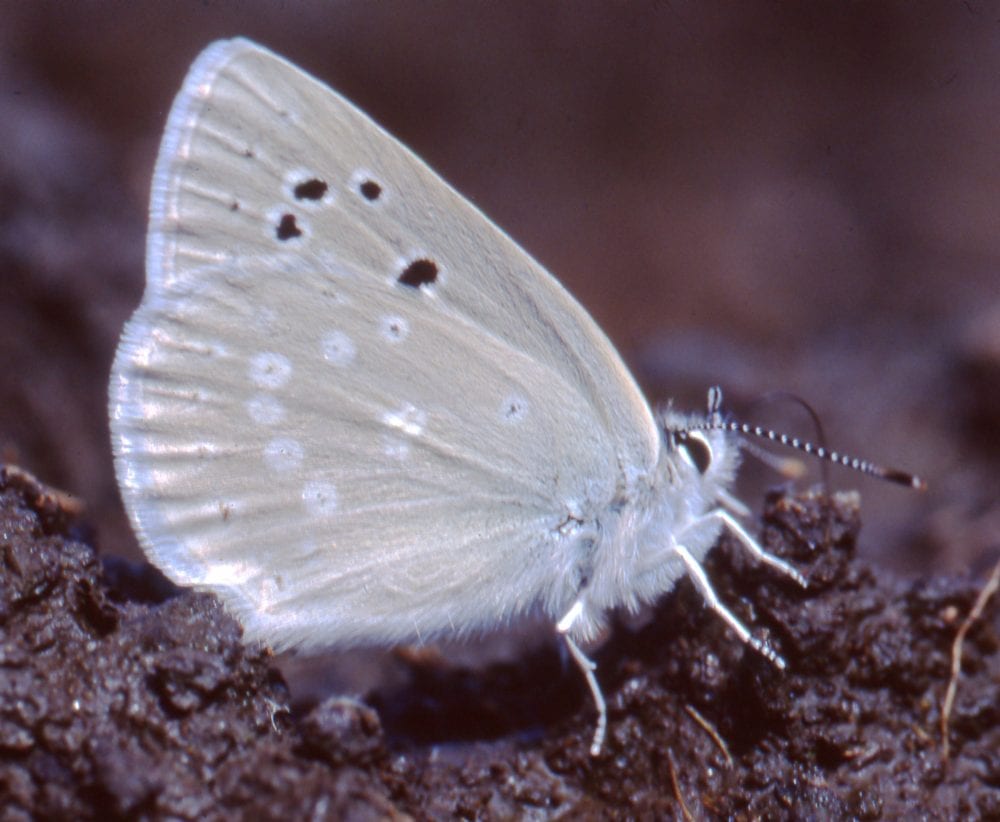
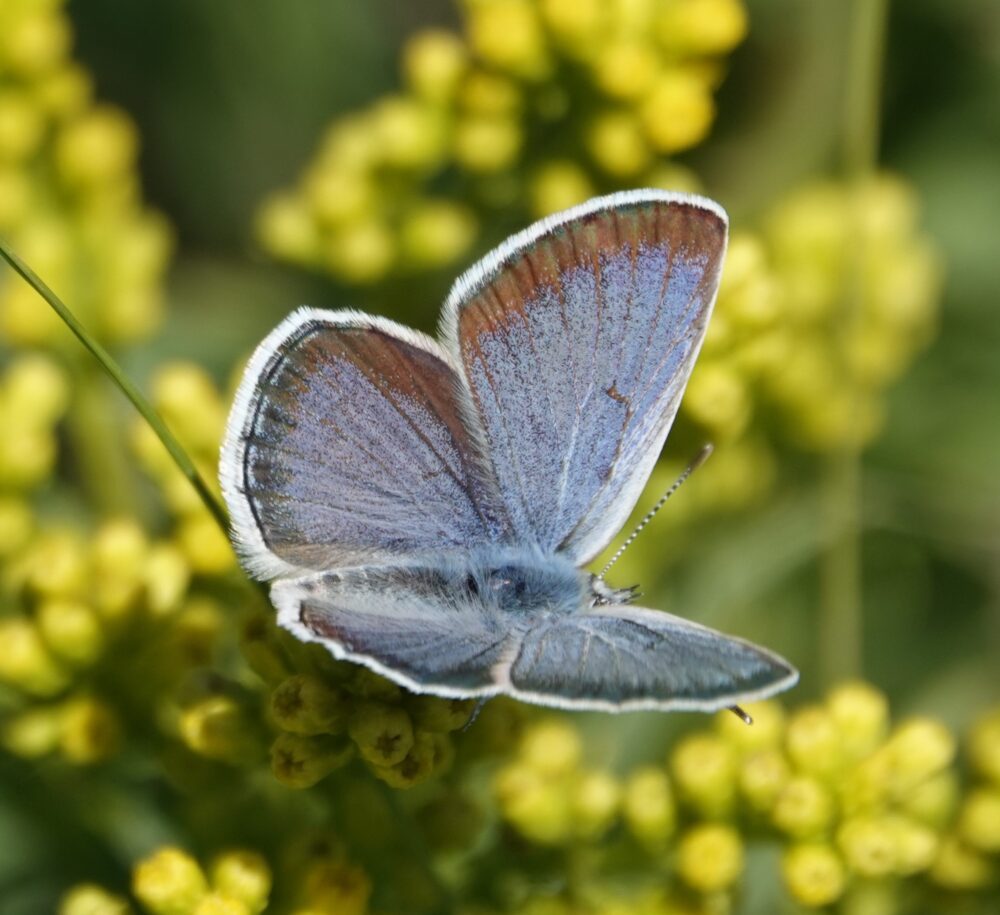
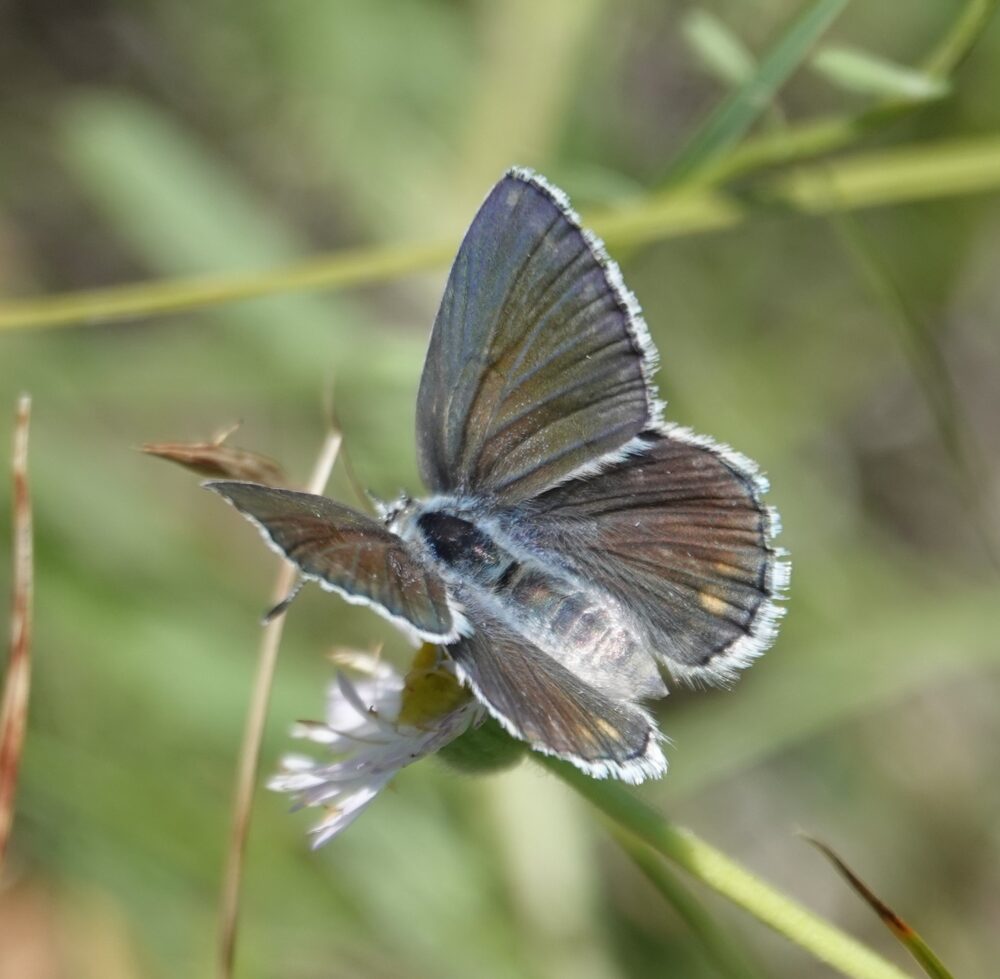
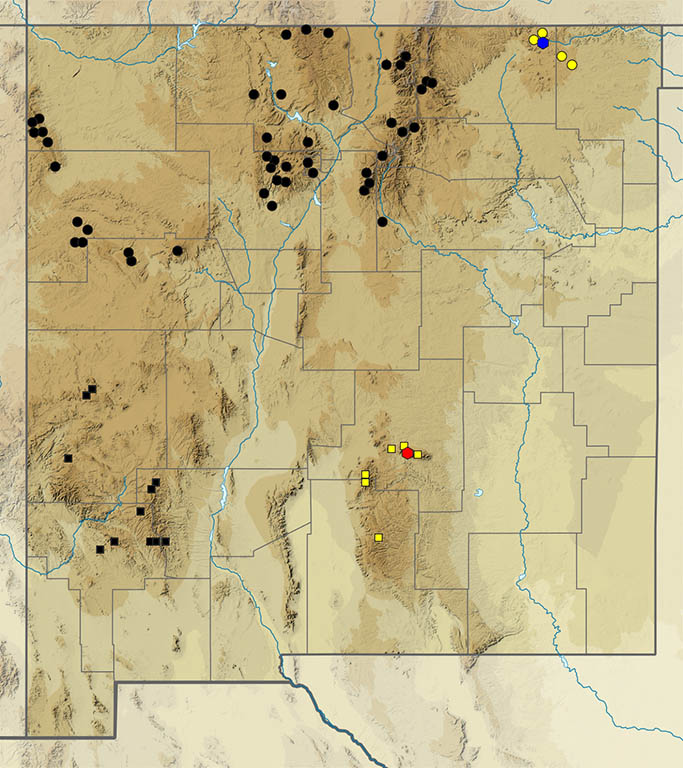
Agriades glandon (de Prunner 1798) Arctic Blue or High Mountain Blue (updated July 20, 2022)
Description. Male High Mountain Blues are variably shimmering silver-blue above with dark margins, black cell-end bars and black hindwing marginal spots. Females are brown. High Mountain Blues’ gray-tan underside has forewing black spots and distinctive hindwing white spots. The female ventral hindwing margin has hints of orange. High Mountain Blues resemble Boisduval’s but the hindwing underside has a postmedian spot band that is pushed out toward the submarginal spot band. Range and Habitat. Agriades glandon or its kin occur across arctic and subarctic regions of the northern hemisphere. It occupies most of Canada and extends southward in cold Rocky Mountain habitats as far as New Mexico (counties: Be,Ca,Ci,Co,LA,MK,Mo,RA,Sv,SJ,SM,SF,So,Ta,To), 8000 to 12,500′. Life History. Hosts in the Rocky Mountains are Primulaceae such as rock jasmines Androsace septentrionalis and A. chamaejasme. Flight. Agriades glandon is univoltine with adults in flight during summer. New Mexico records fall between May 11 and October 3, clustering in June and July. Adults fly near the ground, perching, basking, nectaring and puddling. Comments. Some workers consider Agriades to be a subgenus within the genus Plebejus. North-central New Mexico populations are Agriades glandon rustica (W. H. Edwards 1865). Those in the south-central to southwestern mountains (Ca,So) are tentatively placed with Agriades glandon punctatus Austin 1998.
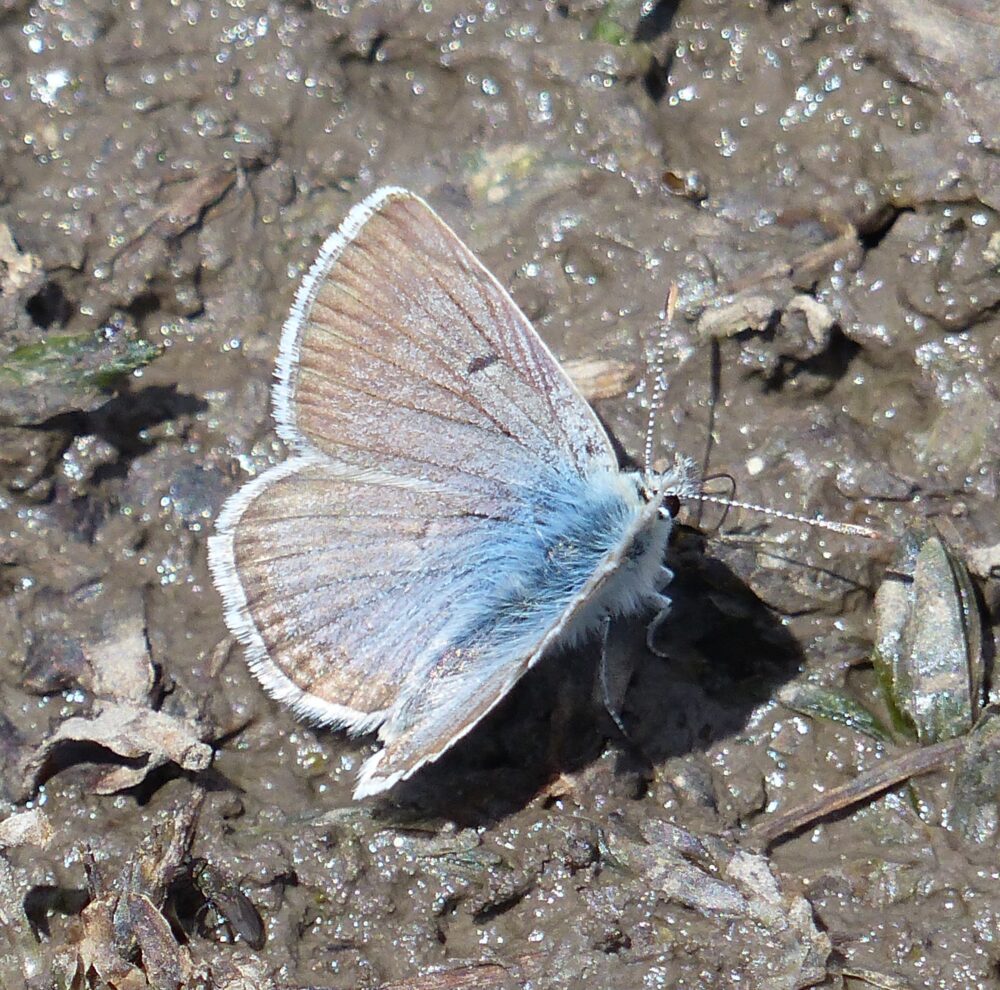
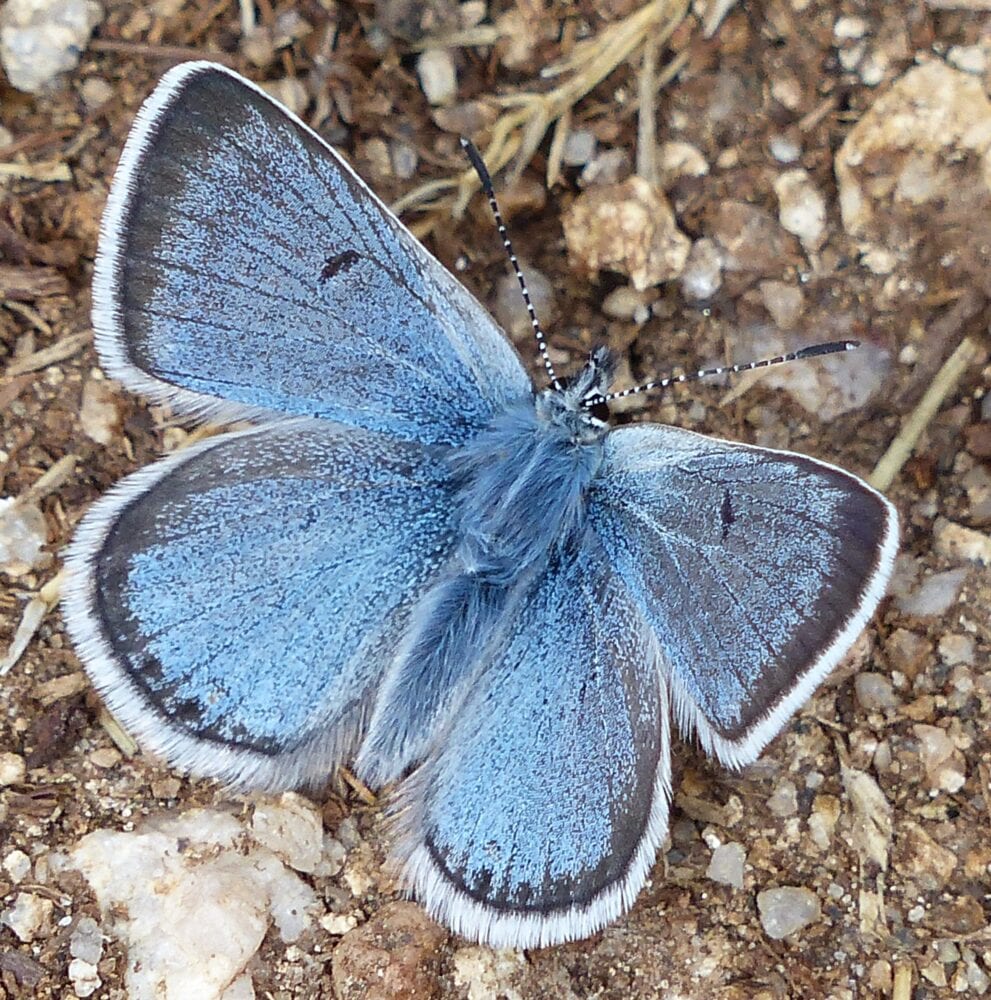





Plebejus melissa (W. H. Edwards 1873) Melissa Blue (updated July 3, 2022)
Description. Male Melissas are bright iridescent blue above; females are brown with orange submarginal bands. Below, both sexes are gray-white with dark marks; submarginal bands of orange spots are capped by black dots packed with iridescent blue scintillae. This distinguishes them from the similar Spalding’s Blue (Euphilotes spaldingi). Range and Habitat. Melissa Blues occur from western North America east to New England in varied habitats. In New Mexico it prefers disturbed areas, agricultural margins and riparian corridors (all counties but Hi,Lu), 3300 to 10,000′. Life History. Host legumes (Fabaceae) in New Mexico are often Astragalus spp., but Lupinus, Vicia, Medicago, Lotus and Hedysarum also are used. Larvae ate blooms of Oxytropis sericea near Capulin Mountain (Un), 27 May 1972 (Mike Toliver). Adults perched on Glycyrrhiza lepidota at the Pecos River (Ch), 3 August 1997 (S. Cary). Ova overwinter. Flight. Plebejus melissa is bivoltine in southern New Mexico and at low elevations; records span March 29 to December 1, with peaks in May to June and September to October. Upward and northward, it is univoltine, with maximum numbers in from June to August. Adults seek nectar and water. Comments. Our populations belong to the nominate subspecies.



